

Compact Muon Solenoid
LHC, CERN
| CMS-PAS-TOP-20-001 | ||
| Measurement of differential tˉt production cross sections in the full kinematic range using lepton+jets events from pp collisions at √s= 13 TeV | ||
| CMS Collaboration | ||
| March 2021 | ||
| Abstract: Measurements of differential and double-differential cross sections of the production of top quark pairs (tˉt) are presented in the lepton+jets channel with a single electron or muon and jets in the final state. The analysis combines signatures of top quarks with low transverse momentum pT, where the top decay products can be identified as separated jets and isolated leptons, and with high pT, where the decay products are collimated and overlap. The measurements are based on data collected by the CMS experiment at the LHC between 2016 and 2018, corresponding to an integrated luminosity of 137 fb−1. The cross sections are presented at the parton and particle level, where the latter minimizes extrapolations based on theoretical assumptions. Both results are compared to standard model calculations using different combinations of next-to-leading order quantum chromodynamics (QCD) matrix elements and parton shower models. Most of the measured differential cross sections are well described by the predictions with the exception of some double-differential distributions. A calculation at next-to-next-to-leading order accuracy in QCD provides an improved description of the parton-level measurements. The inclusive tˉt cross section σtot= 791 ± 25 pb is measured, which constitutes the most precise measurement in the lepton+jets channel to date. | ||
|
Links:
CDS record (PDF) ;
inSPIRE record ;
CADI line (restricted) ;
These preliminary results are superseded in this paper, Submitted to PRD. The superseded preliminary plots can be found here. |
||
| Figures | |

png pdf |
Figure 1:
Comparison between the pT(th) distributions at the particle and parton level, extracted from the POWHEG+PYTHIA simulation. Left: pT-bin migrations between particle and parton level. The pT range of the bins can be taken from the right panel. Each column is normalized such that the sum of its entries corresponds to the fraction of particle-level events in this bin at the parton level in the full phase space. Right: fraction of parton-level top quarks in the same pT bin at the particle level (purity), fraction of particle-level top quarks in the same pT bin at the parton level (stability), ratio of the number of particle- to parton-level top quarks (bin efficiency), and the fraction of particle-level events that are not signal events at the parton level. |

png pdf |
Figure 1-a:
Comparison between the pT(th) distributions at the particle and parton level, extracted from the POWHEG+PYTHIA simulation. Left: pT-bin migrations between particle and parton level. The pT range of the bins can be taken from the right panel. Each column is normalized such that the sum of its entries corresponds to the fraction of particle-level events in this bin at the parton level in the full phase space. Right: fraction of parton-level top quarks in the same pT bin at the particle level (purity), fraction of particle-level top quarks in the same pT bin at the parton level (stability), ratio of the number of particle- to parton-level top quarks (bin efficiency), and the fraction of particle-level events that are not signal events at the parton level. |

png pdf |
Figure 1-b:
Comparison between the pT(th) distributions at the particle and parton level, extracted from the POWHEG+PYTHIA simulation. Left: pT-bin migrations between particle and parton level. The pT range of the bins can be taken from the right panel. Each column is normalized such that the sum of its entries corresponds to the fraction of particle-level events in this bin at the parton level in the full phase space. Right: fraction of parton-level top quarks in the same pT bin at the particle level (purity), fraction of particle-level top quarks in the same pT bin at the parton level (stability), ratio of the number of particle- to parton-level top quarks (bin efficiency), and the fraction of particle-level events that are not signal events at the parton level. |
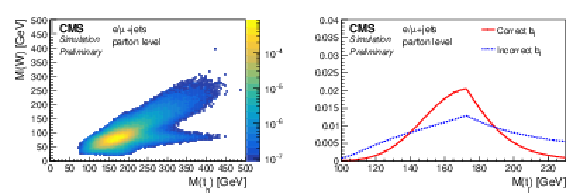
png pdf |
Figure 2:
Normalized two-dimensional mass distribution of the correctly reconstructed hadronically decaying W bosons and the correctly reconstructed th (left). Normalized distributions of the reconstructed M(tℓ) for correctly and incorrectly selected bℓ (right). The distributions are taken from the POWHEG +PYTHIA tˉt simulation. |
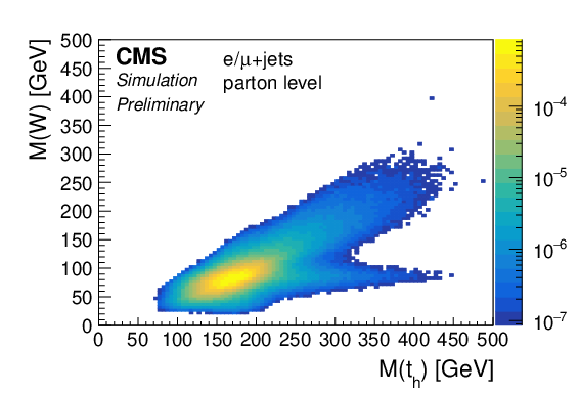
png pdf |
Figure 2-a:
Normalized two-dimensional mass distribution of the correctly reconstructed hadronically decaying W bosons and the correctly reconstructed th (left). Normalized distributions of the reconstructed M(tℓ) for correctly and incorrectly selected bℓ (right). The distributions are taken from the POWHEG +PYTHIA tˉt simulation. |
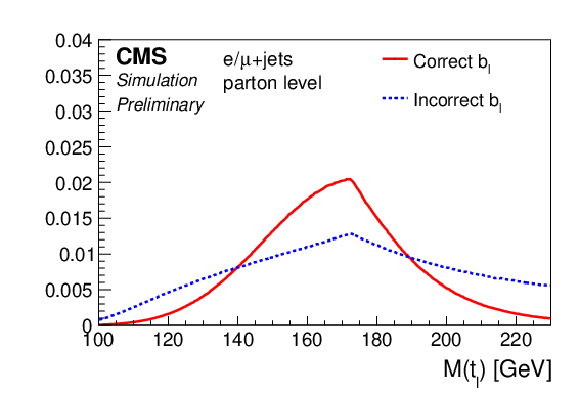
png pdf |
Figure 2-b:
Normalized two-dimensional mass distribution of the correctly reconstructed hadronically decaying W bosons and the correctly reconstructed th (left). Normalized distributions of the reconstructed M(tℓ) for correctly and incorrectly selected bℓ (right). The distributions are taken from the POWHEG +PYTHIA tˉt simulation. |
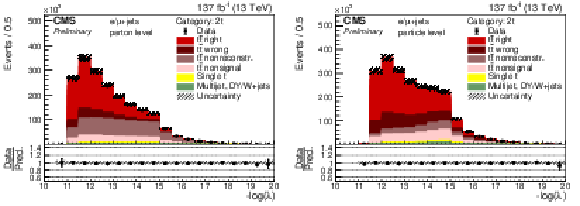
png pdf |
Figure 3:
Distributions of the negative log-likelihood for the selected best permutation in the 2t category. The comparisons of data and predictions are shown for the (left) parton- and the (right) particle-level measurements. Events generated with POWHEG +PYTHIA are used to describe tˉt production. The contribution of multijet, DY, and W boson background events is extracted from the data (cf. Section xxxxx). Combined systematic (cf. Section yyyyy) and statistical uncertainties (hatched area) are shown for the total predicted yields. The data points are shown with statistical uncertainties. The ratios of data to the sum of the predicted yields are provided at the bottom of each panel. |

png pdf |
Figure 3-a:
Distributions of the negative log-likelihood for the selected best permutation in the 2t category. The comparisons of data and predictions are shown for the (left) parton- and the (right) particle-level measurements. Events generated with POWHEG +PYTHIA are used to describe tˉt production. The contribution of multijet, DY, and W boson background events is extracted from the data (cf. Section xxxxx). Combined systematic (cf. Section yyyyy) and statistical uncertainties (hatched area) are shown for the total predicted yields. The data points are shown with statistical uncertainties. The ratios of data to the sum of the predicted yields are provided at the bottom of each panel. |
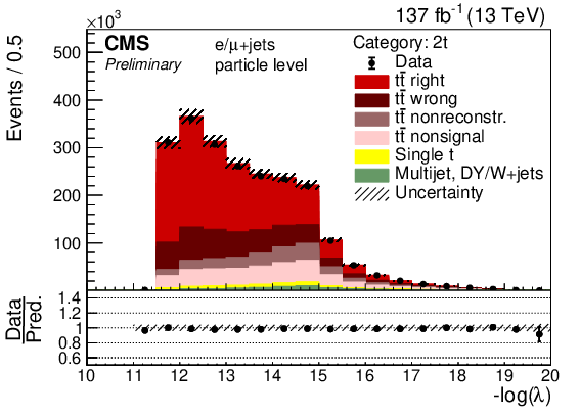
png pdf |
Figure 3-b:
Distributions of the negative log-likelihood for the selected best permutation in the 2t category. The comparisons of data and predictions are shown for the (left) parton- and the (right) particle-level measurements. Events generated with POWHEG +PYTHIA are used to describe tˉt production. The contribution of multijet, DY, and W boson background events is extracted from the data (cf. Section xxxxx). Combined systematic (cf. Section yyyyy) and statistical uncertainties (hatched area) are shown for the total predicted yields. The data points are shown with statistical uncertainties. The ratios of data to the sum of the predicted yields are provided at the bottom of each panel. |

png pdf |
Figure 4:
Distributions of the negative log-likelihood for the selected best permutation in the 1t1l category. The comparisons of data and predictions are shown for the (left) parton- and the (right) particle-level measurements. Events generated with POWHEG +PYTHIA are used to describe tˉt production. The contribution of multijet, DY, and W boson background events is extracted from the data (cf. Section xxxxx). Combined systematic (cf. Section yyyyy) and statistical uncertainties (hatched area) are shown for the total predicted yields. The data points are shown with statistical uncertainties. The ratios of data to the sum of the predicted yields are provided at the bottom of each panel. |

png pdf |
Figure 4-a:
Distributions of the negative log-likelihood for the selected best permutation in the 1t1l category. The comparisons of data and predictions are shown for the (left) parton- and the (right) particle-level measurements. Events generated with POWHEG +PYTHIA are used to describe tˉt production. The contribution of multijet, DY, and W boson background events is extracted from the data (cf. Section xxxxx). Combined systematic (cf. Section yyyyy) and statistical uncertainties (hatched area) are shown for the total predicted yields. The data points are shown with statistical uncertainties. The ratios of data to the sum of the predicted yields are provided at the bottom of each panel. |

png pdf |
Figure 4-b:
Distributions of the negative log-likelihood for the selected best permutation in the 1t1l category. The comparisons of data and predictions are shown for the (left) parton- and the (right) particle-level measurements. Events generated with POWHEG +PYTHIA are used to describe tˉt production. The contribution of multijet, DY, and W boson background events is extracted from the data (cf. Section xxxxx). Combined systematic (cf. Section yyyyy) and statistical uncertainties (hatched area) are shown for the total predicted yields. The data points are shown with statistical uncertainties. The ratios of data to the sum of the predicted yields are provided at the bottom of each panel. |
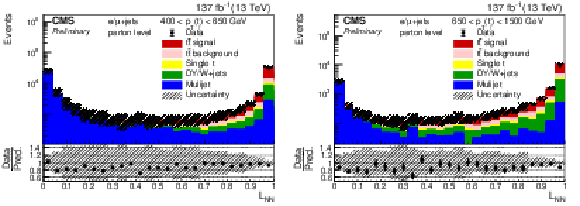
png pdf |
Figure 5:
Distributions of the output variable of the NN for the identification of a boosted tℓ. The distributions are shown in the low (left) and high (right) pT regions. The data are compared to the predicted yields taken from the simulations. Combined systematic (cf. Section yyyyy) and statistical uncertainties (hatched area) are shown for the total predicted yields. The data points are shown with statistical uncertainties. The ratios of data to the sum of the predicted yields are provided at the bottom panels. |
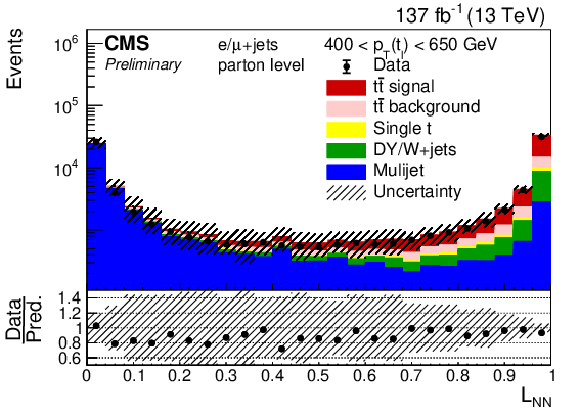
png pdf |
Figure 5-a:
Distributions of the output variable of the NN for the identification of a boosted tℓ. The distributions are shown in the low (left) and high (right) pT regions. The data are compared to the predicted yields taken from the simulations. Combined systematic (cf. Section yyyyy) and statistical uncertainties (hatched area) are shown for the total predicted yields. The data points are shown with statistical uncertainties. The ratios of data to the sum of the predicted yields are provided at the bottom panels. |
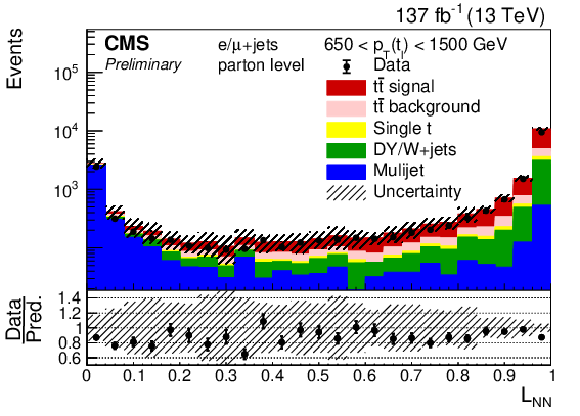
png pdf |
Figure 5-b:
Distributions of the output variable of the NN for the identification of a boosted tℓ. The distributions are shown in the low (left) and high (right) pT regions. The data are compared to the predicted yields taken from the simulations. Combined systematic (cf. Section yyyyy) and statistical uncertainties (hatched area) are shown for the total predicted yields. The data points are shown with statistical uncertainties. The ratios of data to the sum of the predicted yields are provided at the bottom panels. |

png pdf |
Figure 6:
Background selection efficiency as function of the signal selection efficiency in various pT ranges for 3Q and 3Q+2Q jets. An efficiency of 100% corresponds to the preselection of |η|< 2.4 and Mjet> 120 GeV. |

png pdf |
Figure 7:
Comparisons of various reconstructed kinematic distribution between data and predictions. Contributions of the various reconstruction categories are obtained from the POWHEG +PYTHIA tˉt simulation. The contribution of multijet, DY, and W boson background events in the 2t and 1t1l categories are extracted from the data (cf. Section xxxxx). All other background contributions are taken from the simulations. Combined systematic (cf. Section yyyyy) and statistical uncertainties (hatched area) are shown for the total predicted yields. The data points are shown with statistical uncertainties. The ratios of data to the sum of the predicted yields are provided at the bottom of each panel. |

png pdf |
Figure 7-a:
Comparisons of various reconstructed kinematic distribution between data and predictions. Contributions of the various reconstruction categories are obtained from the POWHEG +PYTHIA tˉt simulation. The contribution of multijet, DY, and W boson background events in the 2t and 1t1l categories are extracted from the data (cf. Section xxxxx). All other background contributions are taken from the simulations. Combined systematic (cf. Section yyyyy) and statistical uncertainties (hatched area) are shown for the total predicted yields. The data points are shown with statistical uncertainties. The ratios of data to the sum of the predicted yields are provided at the bottom of each panel. |

png pdf |
Figure 7-b:
Comparisons of various reconstructed kinematic distribution between data and predictions. Contributions of the various reconstruction categories are obtained from the POWHEG +PYTHIA tˉt simulation. The contribution of multijet, DY, and W boson background events in the 2t and 1t1l categories are extracted from the data (cf. Section xxxxx). All other background contributions are taken from the simulations. Combined systematic (cf. Section yyyyy) and statistical uncertainties (hatched area) are shown for the total predicted yields. The data points are shown with statistical uncertainties. The ratios of data to the sum of the predicted yields are provided at the bottom of each panel. |
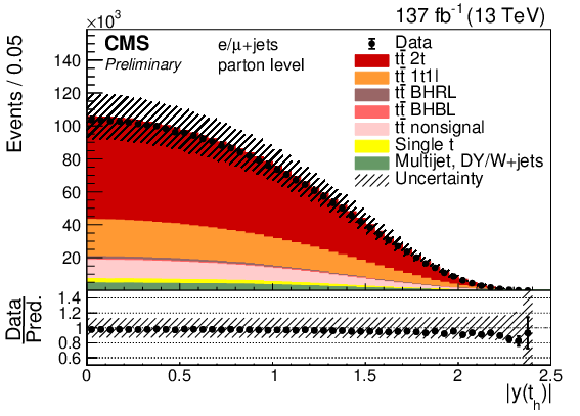
png pdf |
Figure 7-c:
Comparisons of various reconstructed kinematic distribution between data and predictions. Contributions of the various reconstruction categories are obtained from the POWHEG +PYTHIA tˉt simulation. The contribution of multijet, DY, and W boson background events in the 2t and 1t1l categories are extracted from the data (cf. Section xxxxx). All other background contributions are taken from the simulations. Combined systematic (cf. Section yyyyy) and statistical uncertainties (hatched area) are shown for the total predicted yields. The data points are shown with statistical uncertainties. The ratios of data to the sum of the predicted yields are provided at the bottom of each panel. |
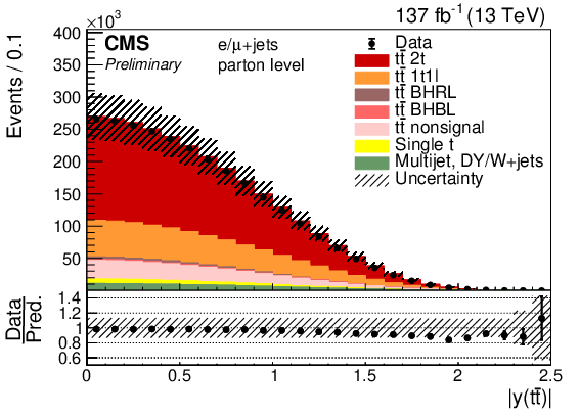
png pdf |
Figure 7-d:
Comparisons of various reconstructed kinematic distribution between data and predictions. Contributions of the various reconstruction categories are obtained from the POWHEG +PYTHIA tˉt simulation. The contribution of multijet, DY, and W boson background events in the 2t and 1t1l categories are extracted from the data (cf. Section xxxxx). All other background contributions are taken from the simulations. Combined systematic (cf. Section yyyyy) and statistical uncertainties (hatched area) are shown for the total predicted yields. The data points are shown with statistical uncertainties. The ratios of data to the sum of the predicted yields are provided at the bottom of each panel. |

png pdf |
Figure 7-e:
Comparisons of various reconstructed kinematic distribution between data and predictions. Contributions of the various reconstruction categories are obtained from the POWHEG +PYTHIA tˉt simulation. The contribution of multijet, DY, and W boson background events in the 2t and 1t1l categories are extracted from the data (cf. Section xxxxx). All other background contributions are taken from the simulations. Combined systematic (cf. Section yyyyy) and statistical uncertainties (hatched area) are shown for the total predicted yields. The data points are shown with statistical uncertainties. The ratios of data to the sum of the predicted yields are provided at the bottom of each panel. |
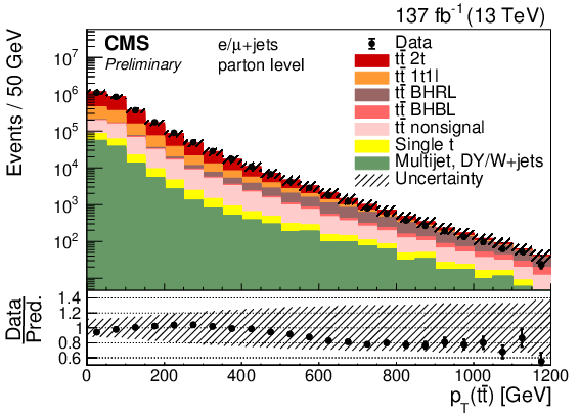
png pdf |
Figure 7-f:
Comparisons of various reconstructed kinematic distribution between data and predictions. Contributions of the various reconstruction categories are obtained from the POWHEG +PYTHIA tˉt simulation. The contribution of multijet, DY, and W boson background events in the 2t and 1t1l categories are extracted from the data (cf. Section xxxxx). All other background contributions are taken from the simulations. Combined systematic (cf. Section yyyyy) and statistical uncertainties (hatched area) are shown for the total predicted yields. The data points are shown with statistical uncertainties. The ratios of data to the sum of the predicted yields are provided at the bottom of each panel. |
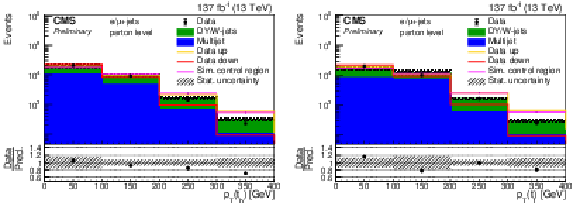
png pdf |
Figure 8:
Comparisons of the multijet DY/W boson background obtained from data in the control region and the predicted background in the signal region in the 1t1l category. The red and orange lines show the shape uncertainties obtained by varying the selection of the control region. The magenta line shows the multijet DY/W boson prediction in the control region. The hatched uncertainty shows the statistical uncertainties in the prediction. |
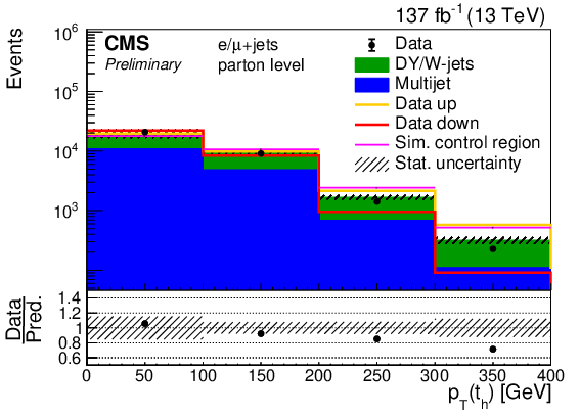
png pdf |
Figure 8-a:
Comparisons of the multijet DY/W boson background obtained from data in the control region and the predicted background in the signal region in the 1t1l category. The red and orange lines show the shape uncertainties obtained by varying the selection of the control region. The magenta line shows the multijet DY/W boson prediction in the control region. The hatched uncertainty shows the statistical uncertainties in the prediction. |

png pdf |
Figure 8-b:
Comparisons of the multijet DY/W boson background obtained from data in the control region and the predicted background in the signal region in the 1t1l category. The red and orange lines show the shape uncertainties obtained by varying the selection of the control region. The magenta line shows the multijet DY/W boson prediction in the control region. The hatched uncertainty shows the statistical uncertainties in the prediction. |
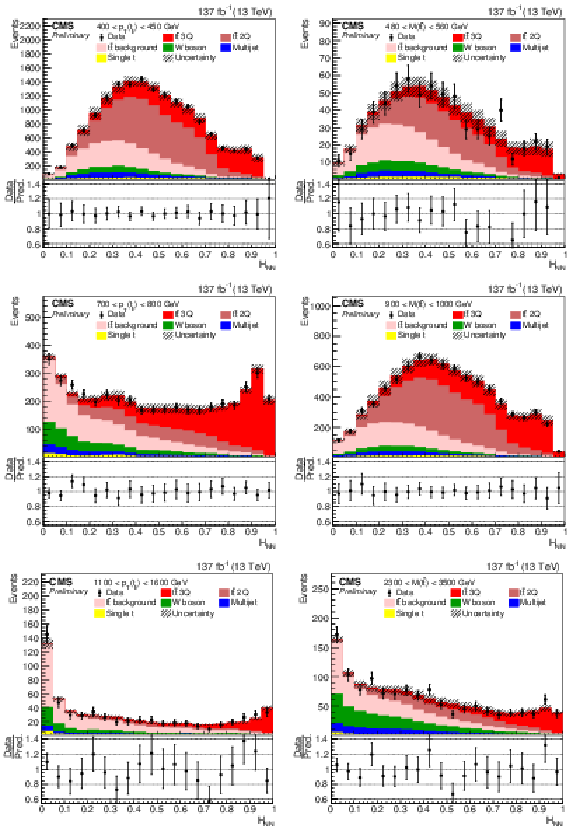
png pdf |
Figure 9:
Post-fit distributions in bins of the pT(th) (left) and M(tˉt) (right) measurements. For illustration the distributions of the electron and muon channels are added for the three years. In addition, for the M(tˉt) measurement the results are summed over the pT(th) bins that are fitted separately for each M(tˉt) bin. The post-fit uncertainties (hatched area) are shown for the total fitted yields. The data points are shown with statistical uncertainties. |
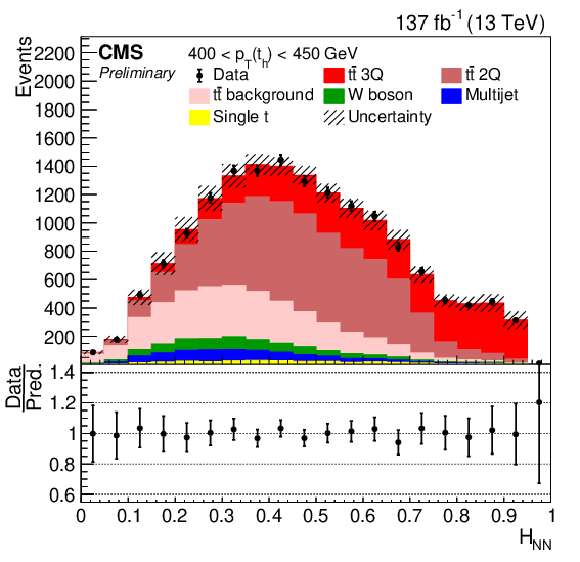
png pdf |
Figure 9-a:
Post-fit distributions in bins of the pT(th) (left) and M(tˉt) (right) measurements. For illustration the distributions of the electron and muon channels are added for the three years. In addition, for the M(tˉt) measurement the results are summed over the pT(th) bins that are fitted separately for each M(tˉt) bin. The post-fit uncertainties (hatched area) are shown for the total fitted yields. The data points are shown with statistical uncertainties. |

png pdf |
Figure 9-b:
Post-fit distributions in bins of the pT(th) (left) and M(tˉt) (right) measurements. For illustration the distributions of the electron and muon channels are added for the three years. In addition, for the M(tˉt) measurement the results are summed over the pT(th) bins that are fitted separately for each M(tˉt) bin. The post-fit uncertainties (hatched area) are shown for the total fitted yields. The data points are shown with statistical uncertainties. |

png pdf |
Figure 9-c:
Post-fit distributions in bins of the pT(th) (left) and M(tˉt) (right) measurements. For illustration the distributions of the electron and muon channels are added for the three years. In addition, for the M(tˉt) measurement the results are summed over the pT(th) bins that are fitted separately for each M(tˉt) bin. The post-fit uncertainties (hatched area) are shown for the total fitted yields. The data points are shown with statistical uncertainties. |

png pdf |
Figure 9-d:
Post-fit distributions in bins of the pT(th) (left) and M(tˉt) (right) measurements. For illustration the distributions of the electron and muon channels are added for the three years. In addition, for the M(tˉt) measurement the results are summed over the pT(th) bins that are fitted separately for each M(tˉt) bin. The post-fit uncertainties (hatched area) are shown for the total fitted yields. The data points are shown with statistical uncertainties. |

png pdf |
Figure 9-e:
Post-fit distributions in bins of the pT(th) (left) and M(tˉt) (right) measurements. For illustration the distributions of the electron and muon channels are added for the three years. In addition, for the M(tˉt) measurement the results are summed over the pT(th) bins that are fitted separately for each M(tˉt) bin. The post-fit uncertainties (hatched area) are shown for the total fitted yields. The data points are shown with statistical uncertainties. |
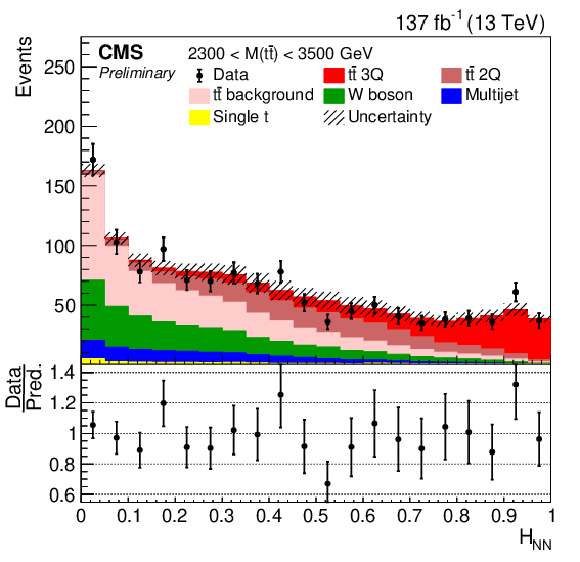
png pdf |
Figure 9-f:
Post-fit distributions in bins of the pT(th) (left) and M(tˉt) (right) measurements. For illustration the distributions of the electron and muon channels are added for the three years. In addition, for the M(tˉt) measurement the results are summed over the pT(th) bins that are fitted separately for each M(tˉt) bin. The post-fit uncertainties (hatched area) are shown for the total fitted yields. The data points are shown with statistical uncertainties. |
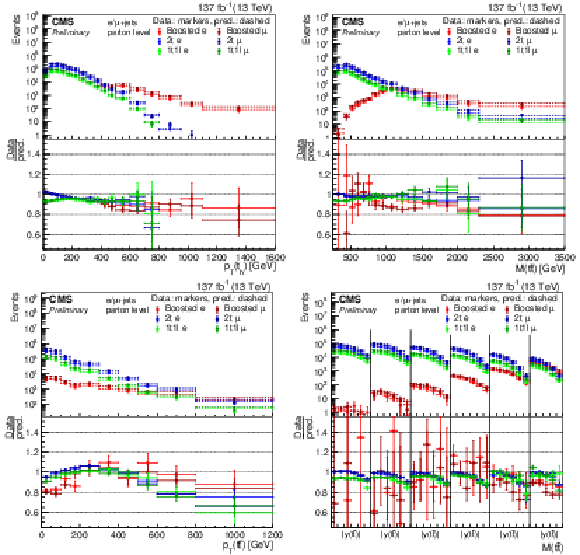
png pdf |
Figure 10:
Signal yields in the 2t, 1t1l, and boosted categories after background subtraction. The error bars show the statistical uncertainty in data. The prediction is obtained with POWHEG +PYTHIA, for which no uncertainties are shown. |

png pdf |
Figure 10-a:
Signal yields in the 2t, 1t1l, and boosted categories after background subtraction. The error bars show the statistical uncertainty in data. The prediction is obtained with POWHEG +PYTHIA, for which no uncertainties are shown. |
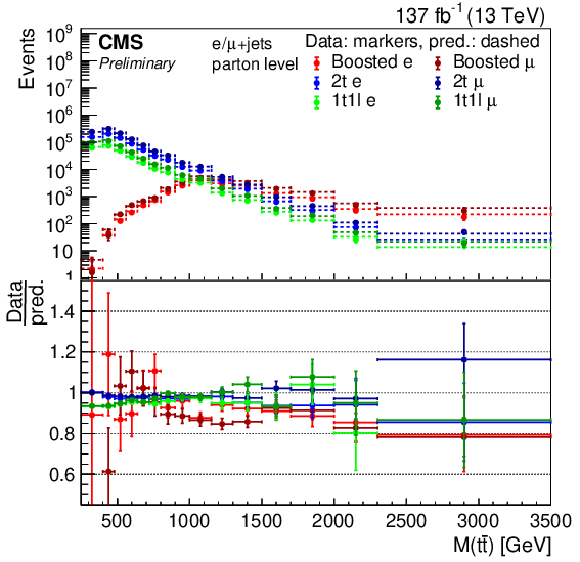
png pdf |
Figure 10-b:
Signal yields in the 2t, 1t1l, and boosted categories after background subtraction. The error bars show the statistical uncertainty in data. The prediction is obtained with POWHEG +PYTHIA, for which no uncertainties are shown. |
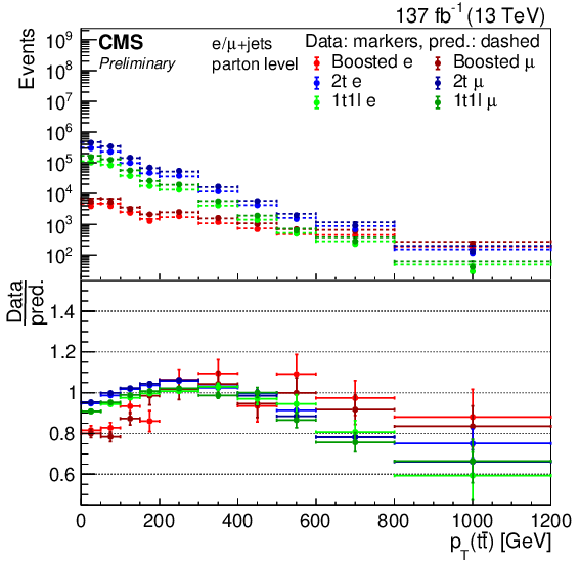
png pdf |
Figure 10-c:
Signal yields in the 2t, 1t1l, and boosted categories after background subtraction. The error bars show the statistical uncertainty in data. The prediction is obtained with POWHEG +PYTHIA, for which no uncertainties are shown. |

png pdf |
Figure 10-d:
Signal yields in the 2t, 1t1l, and boosted categories after background subtraction. The error bars show the statistical uncertainty in data. The prediction is obtained with POWHEG +PYTHIA, for which no uncertainties are shown. |

png pdf |
Figure 11:
Combined response matrices of all reconstruction categories for the measurements of pT(th) at parton (upper) and particle (lower) level. The matrices are shown together with their purity (fraction of parton-/particle-level events that are reconstructed in the same bin at the detector level), stability (fraction of detector-level events that belong in the same bin at the parton/particle level), and the efficiency per bin. |

png pdf |
Figure 11-a:
Combined response matrices of all reconstruction categories for the measurements of pT(th) at parton (upper) and particle (lower) level. The matrices are shown together with their purity (fraction of parton-/particle-level events that are reconstructed in the same bin at the detector level), stability (fraction of detector-level events that belong in the same bin at the parton/particle level), and the efficiency per bin. |
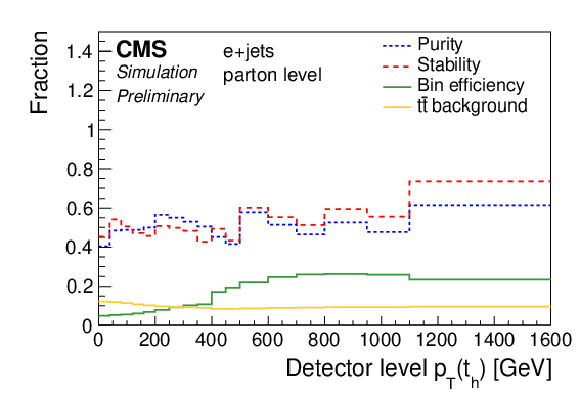
png pdf |
Figure 11-b:
Combined response matrices of all reconstruction categories for the measurements of pT(th) at parton (upper) and particle (lower) level. The matrices are shown together with their purity (fraction of parton-/particle-level events that are reconstructed in the same bin at the detector level), stability (fraction of detector-level events that belong in the same bin at the parton/particle level), and the efficiency per bin. |
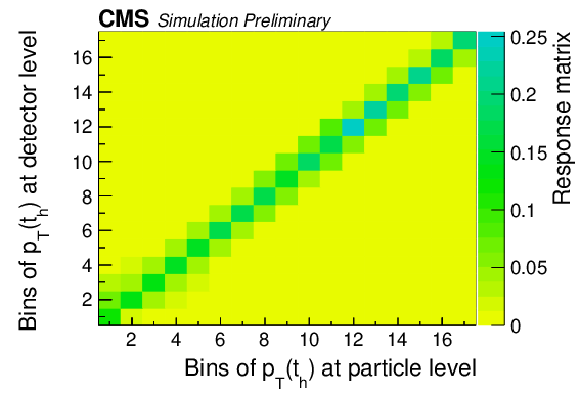
png pdf |
Figure 11-c:
Combined response matrices of all reconstruction categories for the measurements of pT(th) at parton (upper) and particle (lower) level. The matrices are shown together with their purity (fraction of parton-/particle-level events that are reconstructed in the same bin at the detector level), stability (fraction of detector-level events that belong in the same bin at the parton/particle level), and the efficiency per bin. |

png pdf |
Figure 11-d:
Combined response matrices of all reconstruction categories for the measurements of pT(th) at parton (upper) and particle (lower) level. The matrices are shown together with their purity (fraction of parton-/particle-level events that are reconstructed in the same bin at the detector level), stability (fraction of detector-level events that belong in the same bin at the parton/particle level), and the efficiency per bin. |
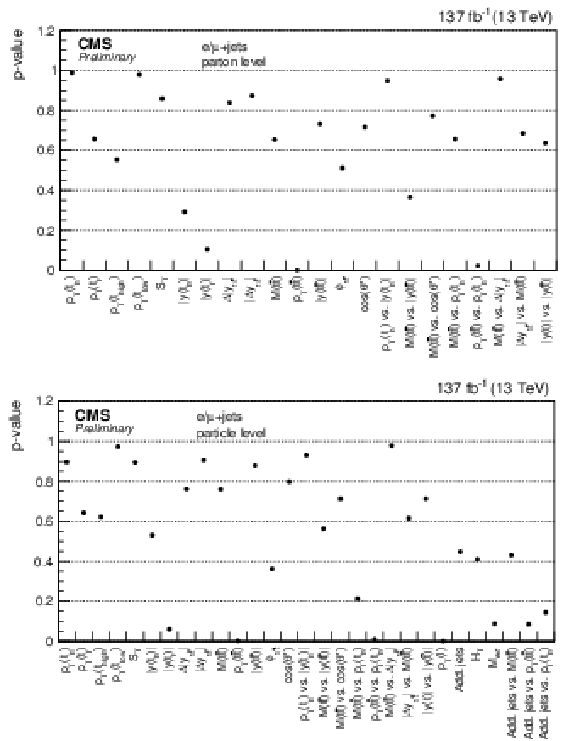
png pdf |
Figure 12:
The p-values of the χ2 fits are shown for the parton- (upper) and particle- (lower) level measurements. |

png pdf |
Figure 12-a:
The p-values of the χ2 fits are shown for the parton- (upper) and particle- (lower) level measurements. |
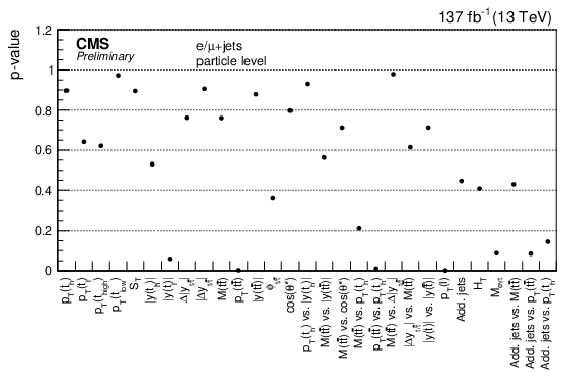
png pdf |
Figure 12-b:
The p-values of the χ2 fits are shown for the parton- (upper) and particle- (lower) level measurements. |
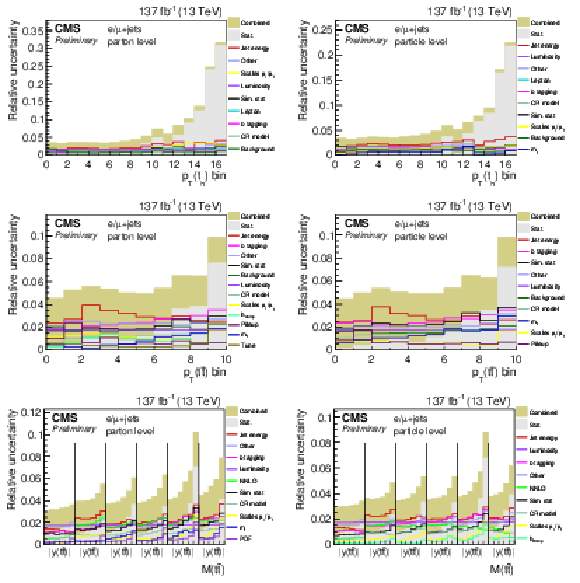
png pdf |
Figure 13:
Uncertainties split into various sources for three exemplary distributions. Uncertainties in the parton-level measurement are shown on the left and in the particle-level measurement on the right. Sources with a maximum uncertainty below 1.5% are combined in the category of "Other''. The boundaries of the bins can be taken from Figs zzzzz, aaaaa, and bbbbb in Section ccccc. |
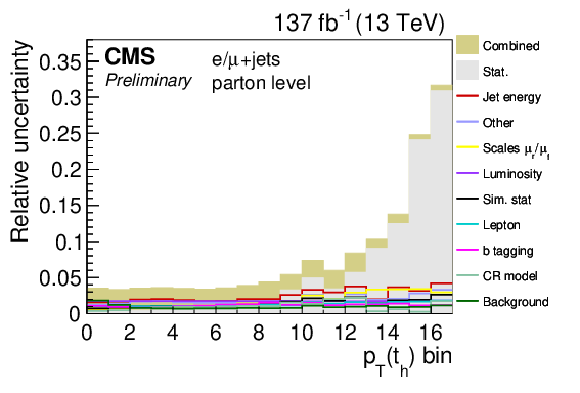
png pdf |
Figure 13-a:
Uncertainties split into various sources for three exemplary distributions. Uncertainties in the parton-level measurement are shown on the left and in the particle-level measurement on the right. Sources with a maximum uncertainty below 1.5% are combined in the category of "Other''. The boundaries of the bins can be taken from Figs zzzzz, aaaaa, and bbbbb in Section ccccc. |

png pdf |
Figure 13-b:
Uncertainties split into various sources for three exemplary distributions. Uncertainties in the parton-level measurement are shown on the left and in the particle-level measurement on the right. Sources with a maximum uncertainty below 1.5% are combined in the category of "Other''. The boundaries of the bins can be taken from Figs zzzzz, aaaaa, and bbbbb in Section ccccc. |
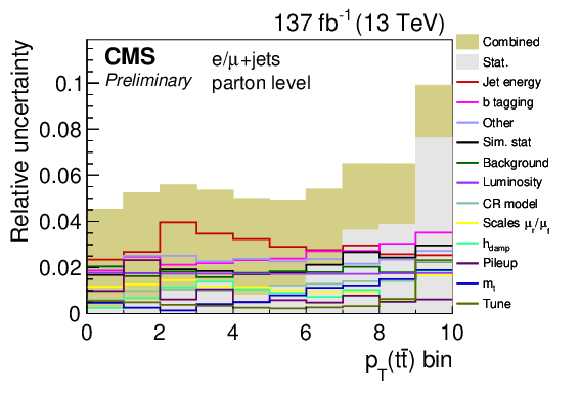
png pdf |
Figure 13-c:
Uncertainties split into various sources for three exemplary distributions. Uncertainties in the parton-level measurement are shown on the left and in the particle-level measurement on the right. Sources with a maximum uncertainty below 1.5% are combined in the category of "Other''. The boundaries of the bins can be taken from Figs zzzzz, aaaaa, and bbbbb in Section ccccc. |

png pdf |
Figure 13-d:
Uncertainties split into various sources for three exemplary distributions. Uncertainties in the parton-level measurement are shown on the left and in the particle-level measurement on the right. Sources with a maximum uncertainty below 1.5% are combined in the category of "Other''. The boundaries of the bins can be taken from Figs zzzzz, aaaaa, and bbbbb in Section ccccc. |
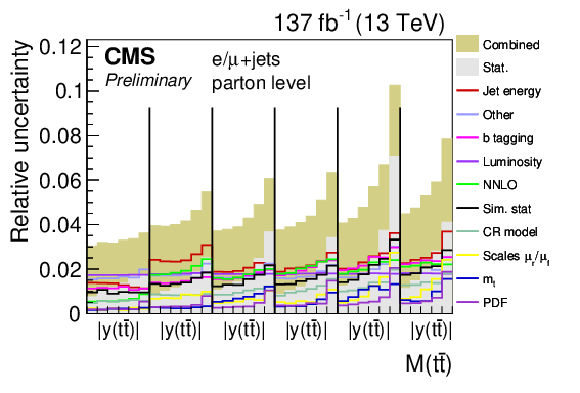
png pdf |
Figure 13-e:
Uncertainties split into various sources for three exemplary distributions. Uncertainties in the parton-level measurement are shown on the left and in the particle-level measurement on the right. Sources with a maximum uncertainty below 1.5% are combined in the category of "Other''. The boundaries of the bins can be taken from Figs zzzzz, aaaaa, and bbbbb in Section ccccc. |
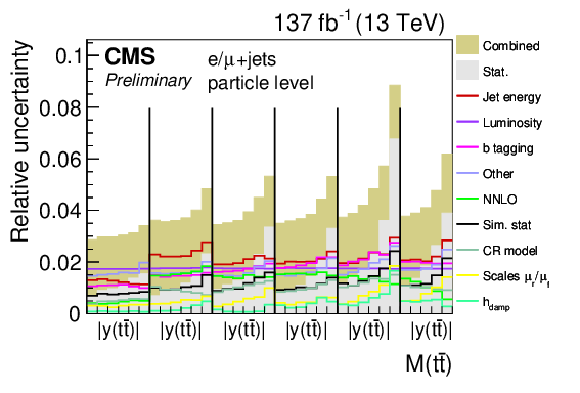
png pdf |
Figure 13-f:
Uncertainties split into various sources for three exemplary distributions. Uncertainties in the parton-level measurement are shown on the left and in the particle-level measurement on the right. Sources with a maximum uncertainty below 1.5% are combined in the category of "Other''. The boundaries of the bins can be taken from Figs zzzzz, aaaaa, and bbbbb in Section ccccc. |
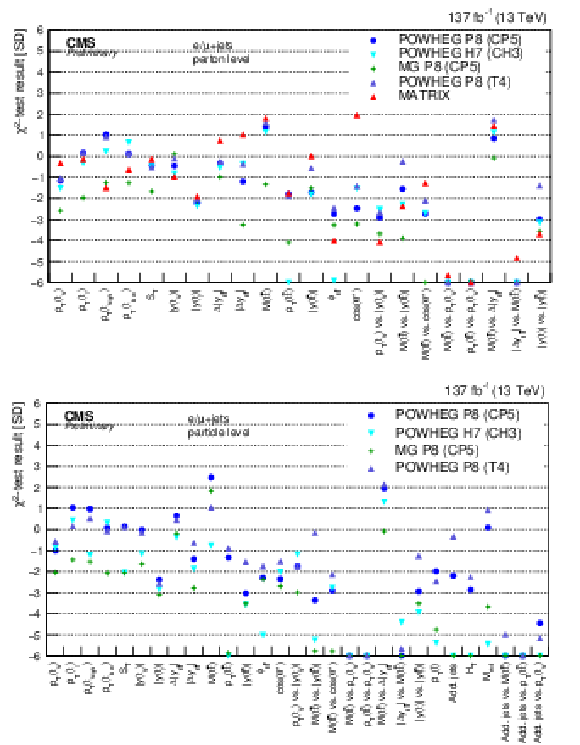
png pdf |
Figure 14:
Results of χ2 tests in standard deviation (SD) comparing the measured cross sections at the parton (upper) and particle (lower) level to various predictions. The p-values above 0.5 correspond to a positive SD and below 0.5 to a negative SD. The uncertainties in the measurements and the predictions are taken into account. |

png pdf |
Figure 14-a:
Results of χ2 tests in standard deviation (SD) comparing the measured cross sections at the parton (upper) and particle (lower) level to various predictions. The p-values above 0.5 correspond to a positive SD and below 0.5 to a negative SD. The uncertainties in the measurements and the predictions are taken into account. |

png pdf |
Figure 14-b:
Results of χ2 tests in standard deviation (SD) comparing the measured cross sections at the parton (upper) and particle (lower) level to various predictions. The p-values above 0.5 correspond to a positive SD and below 0.5 to a negative SD. The uncertainties in the measurements and the predictions are taken into account. |

png pdf |
Figure 15:
Differential cross section as functions of pT(th), pT(tℓ), pT(thigh), pT(tlow), and ST. The data are shown as points with light (dark) bands indicating the statistical (statistical and systematic) uncertainties. The cross sections are compared to the predictions of POWHEG combined with PYTHIA (P8) or HERWIG (H7), the multiparton simulation MG5_aMC@NLO (MG5)+PYTHIA FxFx, and the NNLO QCD calculations obtained with Matrix. The ratios of the various predictions to the measured cross sections are shown at the bottom of each panel. |
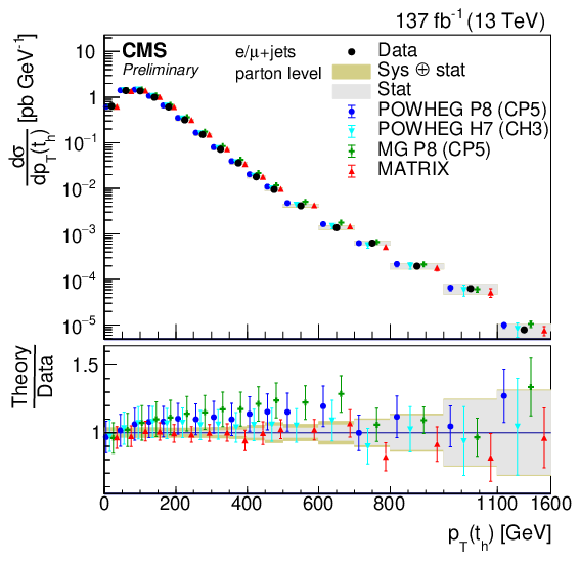
png pdf |
Figure 15-a:
Differential cross section as functions of pT(th), pT(tℓ), pT(thigh), pT(tlow), and ST. The data are shown as points with light (dark) bands indicating the statistical (statistical and systematic) uncertainties. The cross sections are compared to the predictions of POWHEG combined with PYTHIA (P8) or HERWIG (H7), the multiparton simulation MG5_aMC@NLO (MG5)+PYTHIA FxFx, and the NNLO QCD calculations obtained with Matrix. The ratios of the various predictions to the measured cross sections are shown at the bottom of each panel. |

png pdf |
Figure 15-b:
Differential cross section as functions of pT(th), pT(tℓ), pT(thigh), pT(tlow), and ST. The data are shown as points with light (dark) bands indicating the statistical (statistical and systematic) uncertainties. The cross sections are compared to the predictions of POWHEG combined with PYTHIA (P8) or HERWIG (H7), the multiparton simulation MG5_aMC@NLO (MG5)+PYTHIA FxFx, and the NNLO QCD calculations obtained with Matrix. The ratios of the various predictions to the measured cross sections are shown at the bottom of each panel. |

png pdf |
Figure 15-c:
Differential cross section as functions of pT(th), pT(tℓ), pT(thigh), pT(tlow), and ST. The data are shown as points with light (dark) bands indicating the statistical (statistical and systematic) uncertainties. The cross sections are compared to the predictions of POWHEG combined with PYTHIA (P8) or HERWIG (H7), the multiparton simulation MG5_aMC@NLO (MG5)+PYTHIA FxFx, and the NNLO QCD calculations obtained with Matrix. The ratios of the various predictions to the measured cross sections are shown at the bottom of each panel. |

png pdf |
Figure 15-d:
Differential cross section as functions of pT(th), pT(tℓ), pT(thigh), pT(tlow), and ST. The data are shown as points with light (dark) bands indicating the statistical (statistical and systematic) uncertainties. The cross sections are compared to the predictions of POWHEG combined with PYTHIA (P8) or HERWIG (H7), the multiparton simulation MG5_aMC@NLO (MG5)+PYTHIA FxFx, and the NNLO QCD calculations obtained with Matrix. The ratios of the various predictions to the measured cross sections are shown at the bottom of each panel. |
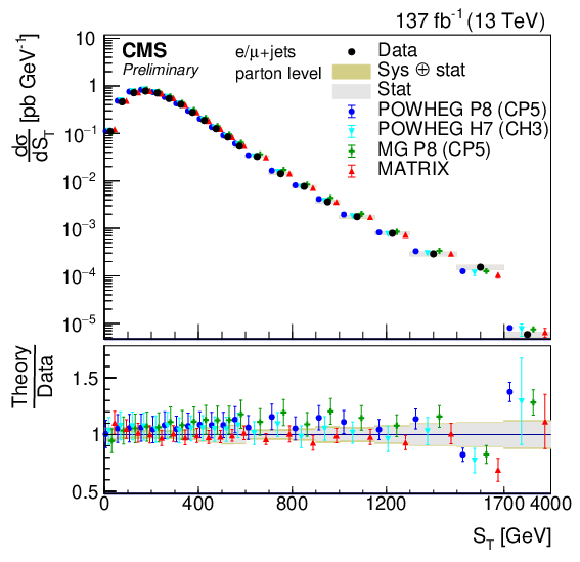
png pdf |
Figure 15-e:
Differential cross section as functions of pT(th), pT(tℓ), pT(thigh), pT(tlow), and ST. The data are shown as points with light (dark) bands indicating the statistical (statistical and systematic) uncertainties. The cross sections are compared to the predictions of POWHEG combined with PYTHIA (P8) or HERWIG (H7), the multiparton simulation MG5_aMC@NLO (MG5)+PYTHIA FxFx, and the NNLO QCD calculations obtained with Matrix. The ratios of the various predictions to the measured cross sections are shown at the bottom of each panel. |

png pdf |
Figure 16:
Differential cross section as functions of pT(th), pT(tℓ), pT(thigh), pT(tlow), and ST. The data are shown as points with light (dark) bands indicating the statistical (statistical and systematic) uncertainties. The cross sections are compared to the predictions of POWHEG +PYTHIA (P8) for the CP5 and CUETP8M2T4 (T4), POWHEG +HERWIG (H7), and the multiparton simulation MG5_aMC@NLO (MG)+PYTHIA. The ratios of the various predictions to the measured cross sections are shown at the bottom of each panel. |
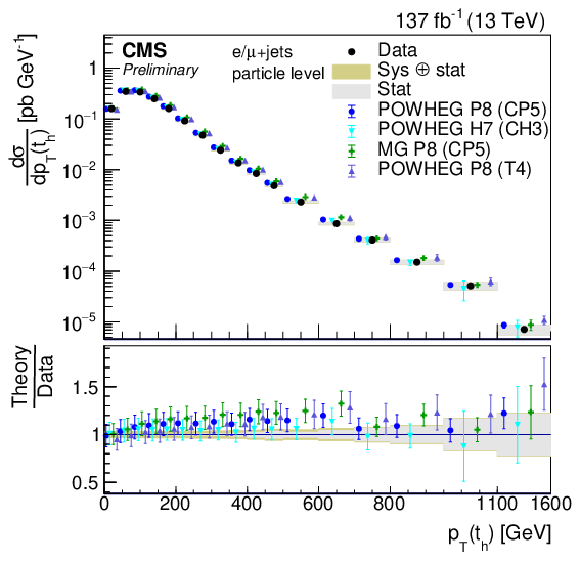
png pdf |
Figure 16-a:
Differential cross section as functions of pT(th), pT(tℓ), pT(thigh), pT(tlow), and ST. The data are shown as points with light (dark) bands indicating the statistical (statistical and systematic) uncertainties. The cross sections are compared to the predictions of POWHEG +PYTHIA (P8) for the CP5 and CUETP8M2T4 (T4), POWHEG +HERWIG (H7), and the multiparton simulation MG5_aMC@NLO (MG)+PYTHIA. The ratios of the various predictions to the measured cross sections are shown at the bottom of each panel. |

png pdf |
Figure 16-b:
Differential cross section as functions of pT(th), pT(tℓ), pT(thigh), pT(tlow), and ST. The data are shown as points with light (dark) bands indicating the statistical (statistical and systematic) uncertainties. The cross sections are compared to the predictions of POWHEG +PYTHIA (P8) for the CP5 and CUETP8M2T4 (T4), POWHEG +HERWIG (H7), and the multiparton simulation MG5_aMC@NLO (MG)+PYTHIA. The ratios of the various predictions to the measured cross sections are shown at the bottom of each panel. |
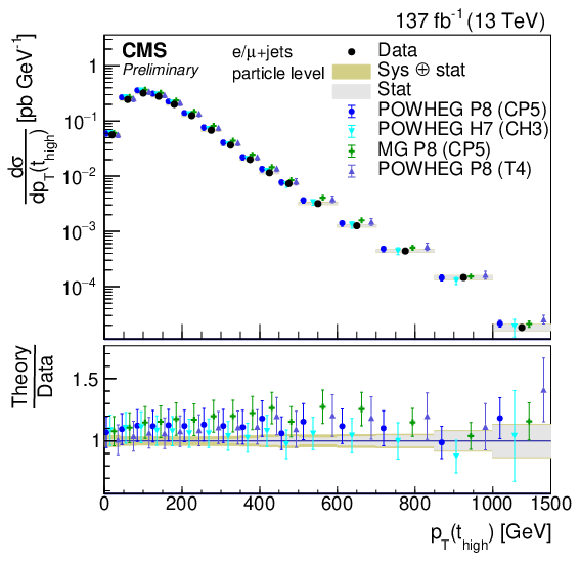
png pdf |
Figure 16-c:
Differential cross section as functions of pT(th), pT(tℓ), pT(thigh), pT(tlow), and ST. The data are shown as points with light (dark) bands indicating the statistical (statistical and systematic) uncertainties. The cross sections are compared to the predictions of POWHEG +PYTHIA (P8) for the CP5 and CUETP8M2T4 (T4), POWHEG +HERWIG (H7), and the multiparton simulation MG5_aMC@NLO (MG)+PYTHIA. The ratios of the various predictions to the measured cross sections are shown at the bottom of each panel. |
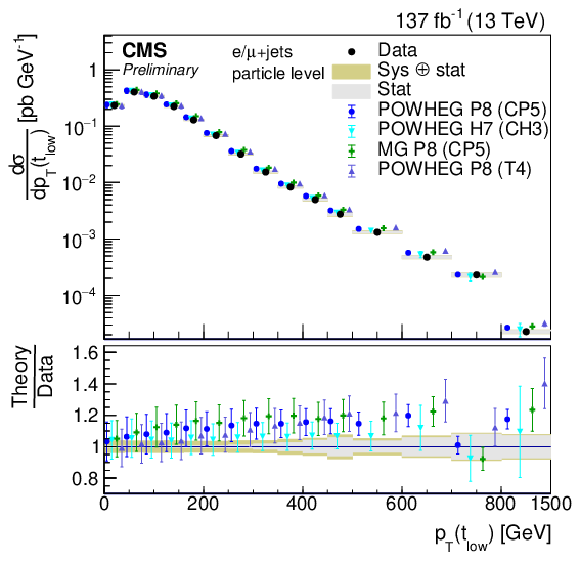
png pdf |
Figure 16-d:
Differential cross section as functions of pT(th), pT(tℓ), pT(thigh), pT(tlow), and ST. The data are shown as points with light (dark) bands indicating the statistical (statistical and systematic) uncertainties. The cross sections are compared to the predictions of POWHEG +PYTHIA (P8) for the CP5 and CUETP8M2T4 (T4), POWHEG +HERWIG (H7), and the multiparton simulation MG5_aMC@NLO (MG)+PYTHIA. The ratios of the various predictions to the measured cross sections are shown at the bottom of each panel. |

png pdf |
Figure 16-e:
Differential cross section as functions of pT(th), pT(tℓ), pT(thigh), pT(tlow), and ST. The data are shown as points with light (dark) bands indicating the statistical (statistical and systematic) uncertainties. The cross sections are compared to the predictions of POWHEG +PYTHIA (P8) for the CP5 and CUETP8M2T4 (T4), POWHEG +HERWIG (H7), and the multiparton simulation MG5_aMC@NLO (MG)+PYTHIA. The ratios of the various predictions to the measured cross sections are shown at the bottom of each panel. |

png pdf |
Figure 17:
Differential cross section as function of |y(th)|, |y(tℓ)|, and the differences Δ|yt/ˉt| and |Δyt/ˉt|. The data are shown as points with light (dark) bands indicating the statistical (statistical and systematic) uncertainties. The cross sections are compared to the predictions of POWHEG combined with PYTHIA (P8) or HERWIG (H7), the multiparton simulation MG5_aMC@NLO (MG5)+PYTHIA FxFx, and the NNLO QCD calculations obtained with Matrix. The ratios of the various predictions to the measured cross sections are shown at the bottom of each panel. |
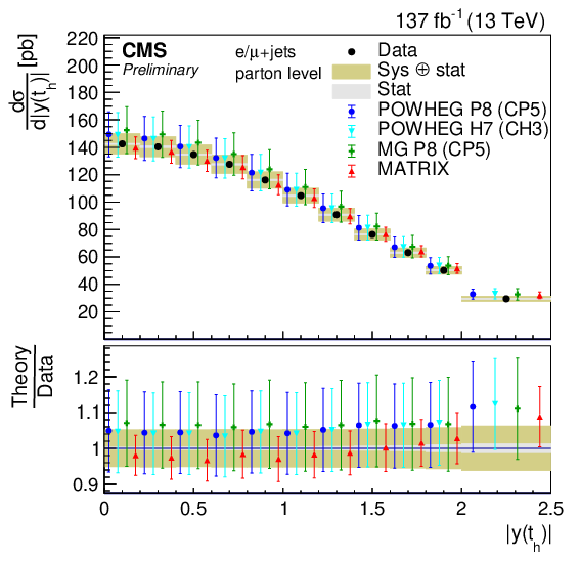
png pdf |
Figure 17-a:
Differential cross section as function of |y(th)|, |y(tℓ)|, and the differences Δ|yt/ˉt| and |Δyt/ˉt|. The data are shown as points with light (dark) bands indicating the statistical (statistical and systematic) uncertainties. The cross sections are compared to the predictions of POWHEG combined with PYTHIA (P8) or HERWIG (H7), the multiparton simulation MG5_aMC@NLO (MG5)+PYTHIA FxFx, and the NNLO QCD calculations obtained with Matrix. The ratios of the various predictions to the measured cross sections are shown at the bottom of each panel. |

png pdf |
Figure 17-b:
Differential cross section as function of |y(th)|, |y(tℓ)|, and the differences Δ|yt/ˉt| and |Δyt/ˉt|. The data are shown as points with light (dark) bands indicating the statistical (statistical and systematic) uncertainties. The cross sections are compared to the predictions of POWHEG combined with PYTHIA (P8) or HERWIG (H7), the multiparton simulation MG5_aMC@NLO (MG5)+PYTHIA FxFx, and the NNLO QCD calculations obtained with Matrix. The ratios of the various predictions to the measured cross sections are shown at the bottom of each panel. |
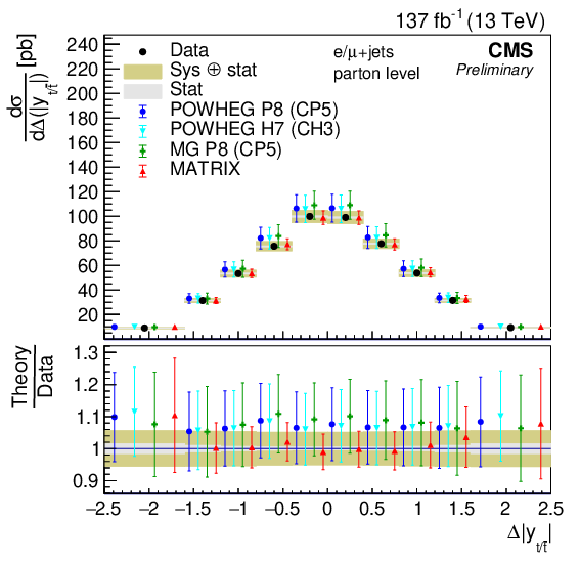
png pdf |
Figure 17-c:
Differential cross section as function of |y(th)|, |y(tℓ)|, and the differences Δ|yt/ˉt| and |Δyt/ˉt|. The data are shown as points with light (dark) bands indicating the statistical (statistical and systematic) uncertainties. The cross sections are compared to the predictions of POWHEG combined with PYTHIA (P8) or HERWIG (H7), the multiparton simulation MG5_aMC@NLO (MG5)+PYTHIA FxFx, and the NNLO QCD calculations obtained with Matrix. The ratios of the various predictions to the measured cross sections are shown at the bottom of each panel. |

png pdf |
Figure 17-d:
Differential cross section as function of |y(th)|, |y(tℓ)|, and the differences Δ|yt/ˉt| and |Δyt/ˉt|. The data are shown as points with light (dark) bands indicating the statistical (statistical and systematic) uncertainties. The cross sections are compared to the predictions of POWHEG combined with PYTHIA (P8) or HERWIG (H7), the multiparton simulation MG5_aMC@NLO (MG5)+PYTHIA FxFx, and the NNLO QCD calculations obtained with Matrix. The ratios of the various predictions to the measured cross sections are shown at the bottom of each panel. |
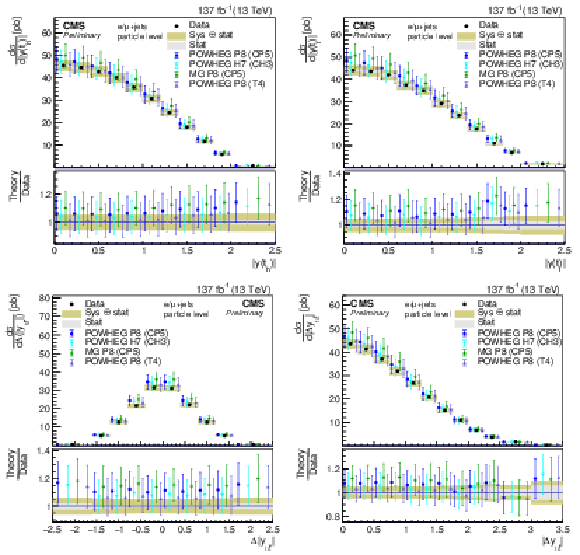
png pdf |
Figure 18:
Differential cross section as function of |y(th)|, |y(tℓ)|, and the differences Δ|yt/ˉt| and |Δyt/ˉt|. The data are shown as points with light (dark) bands indicating the statistical (statistical and systematic) uncertainties. The cross sections are compared to the predictions of POWHEG +PYTHIA (P8) for the CP5 and CUETP8M2T4 (T4), POWHEG +HERWIG (H7), and the multiparton simulation MG5_aMC@NLO (MG)+PYTHIA. The ratios of the various predictions to the measured cross sections are shown at the bottom of each panel. |

png pdf |
Figure 18-a:
Differential cross section as function of |y(th)|, |y(tℓ)|, and the differences Δ|yt/ˉt| and |Δyt/ˉt|. The data are shown as points with light (dark) bands indicating the statistical (statistical and systematic) uncertainties. The cross sections are compared to the predictions of POWHEG +PYTHIA (P8) for the CP5 and CUETP8M2T4 (T4), POWHEG +HERWIG (H7), and the multiparton simulation MG5_aMC@NLO (MG)+PYTHIA. The ratios of the various predictions to the measured cross sections are shown at the bottom of each panel. |

png pdf |
Figure 18-b:
Differential cross section as function of |y(th)|, |y(tℓ)|, and the differences Δ|yt/ˉt| and |Δyt/ˉt|. The data are shown as points with light (dark) bands indicating the statistical (statistical and systematic) uncertainties. The cross sections are compared to the predictions of POWHEG +PYTHIA (P8) for the CP5 and CUETP8M2T4 (T4), POWHEG +HERWIG (H7), and the multiparton simulation MG5_aMC@NLO (MG)+PYTHIA. The ratios of the various predictions to the measured cross sections are shown at the bottom of each panel. |
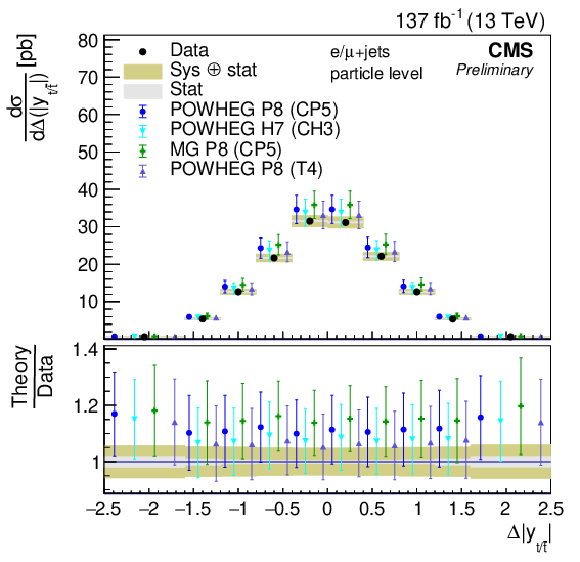
png pdf |
Figure 18-c:
Differential cross section as function of |y(th)|, |y(tℓ)|, and the differences Δ|yt/ˉt| and |Δyt/ˉt|. The data are shown as points with light (dark) bands indicating the statistical (statistical and systematic) uncertainties. The cross sections are compared to the predictions of POWHEG +PYTHIA (P8) for the CP5 and CUETP8M2T4 (T4), POWHEG +HERWIG (H7), and the multiparton simulation MG5_aMC@NLO (MG)+PYTHIA. The ratios of the various predictions to the measured cross sections are shown at the bottom of each panel. |
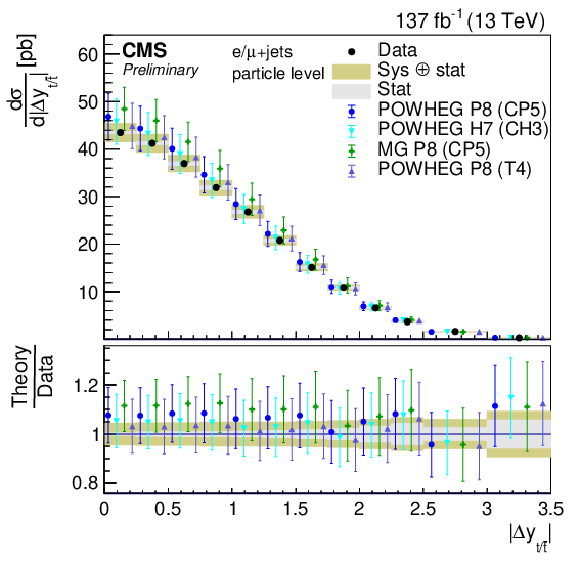
png pdf |
Figure 18-d:
Differential cross section as function of |y(th)|, |y(tℓ)|, and the differences Δ|yt/ˉt| and |Δyt/ˉt|. The data are shown as points with light (dark) bands indicating the statistical (statistical and systematic) uncertainties. The cross sections are compared to the predictions of POWHEG +PYTHIA (P8) for the CP5 and CUETP8M2T4 (T4), POWHEG +HERWIG (H7), and the multiparton simulation MG5_aMC@NLO (MG)+PYTHIA. The ratios of the various predictions to the measured cross sections are shown at the bottom of each panel. |

png pdf |
Figure 19:
Differential cross sections as functions of quantities of the tˉt system. The data are shown as points with light (dark) bands indicating the statistical (statistical and systematic) uncertainties. The cross sections are compared to the predictions of POWHEG combined with PYTHIA (P8) or HERWIG (H7), the multiparton simulation MG5_aMC@NLO (MG5)+PYTHIA FxFx, and the NNLO QCD calculations obtained with Matrix. The ratios of the various predictions to the measured cross sections are shown at the bottom of each panel. |
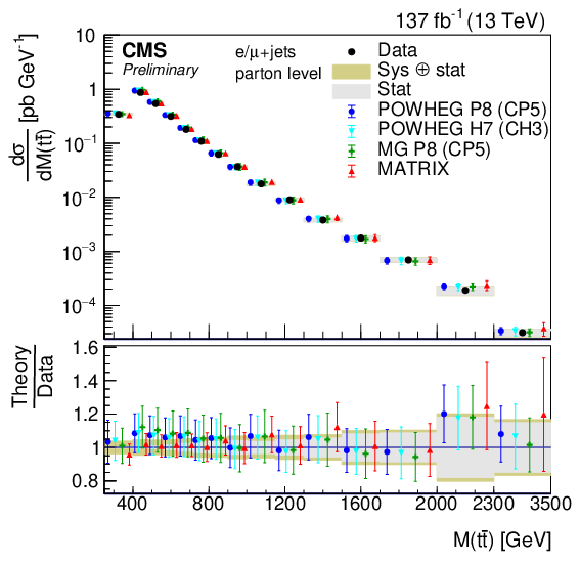
png pdf |
Figure 19-a:
Differential cross sections as functions of quantities of the tˉt system. The data are shown as points with light (dark) bands indicating the statistical (statistical and systematic) uncertainties. The cross sections are compared to the predictions of POWHEG combined with PYTHIA (P8) or HERWIG (H7), the multiparton simulation MG5_aMC@NLO (MG5)+PYTHIA FxFx, and the NNLO QCD calculations obtained with Matrix. The ratios of the various predictions to the measured cross sections are shown at the bottom of each panel. |
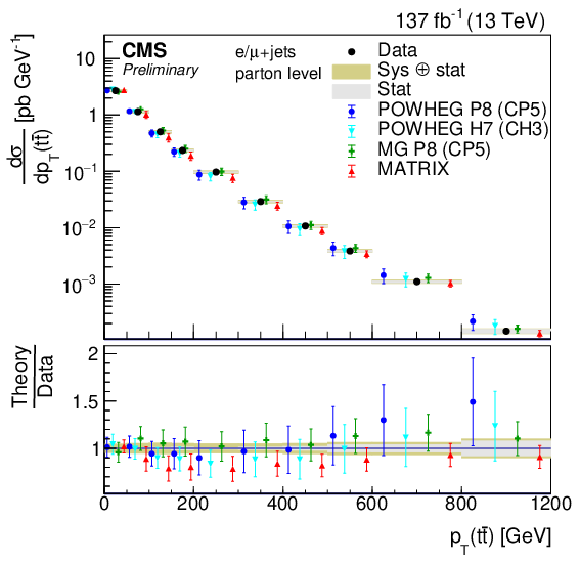
png pdf |
Figure 19-b:
Differential cross sections as functions of quantities of the tˉt system. The data are shown as points with light (dark) bands indicating the statistical (statistical and systematic) uncertainties. The cross sections are compared to the predictions of POWHEG combined with PYTHIA (P8) or HERWIG (H7), the multiparton simulation MG5_aMC@NLO (MG5)+PYTHIA FxFx, and the NNLO QCD calculations obtained with Matrix. The ratios of the various predictions to the measured cross sections are shown at the bottom of each panel. |

png pdf |
Figure 19-c:
Differential cross sections as functions of quantities of the tˉt system. The data are shown as points with light (dark) bands indicating the statistical (statistical and systematic) uncertainties. The cross sections are compared to the predictions of POWHEG combined with PYTHIA (P8) or HERWIG (H7), the multiparton simulation MG5_aMC@NLO (MG5)+PYTHIA FxFx, and the NNLO QCD calculations obtained with Matrix. The ratios of the various predictions to the measured cross sections are shown at the bottom of each panel. |

png pdf |
Figure 19-d:
Differential cross sections as functions of quantities of the tˉt system. The data are shown as points with light (dark) bands indicating the statistical (statistical and systematic) uncertainties. The cross sections are compared to the predictions of POWHEG combined with PYTHIA (P8) or HERWIG (H7), the multiparton simulation MG5_aMC@NLO (MG5)+PYTHIA FxFx, and the NNLO QCD calculations obtained with Matrix. The ratios of the various predictions to the measured cross sections are shown at the bottom of each panel. |
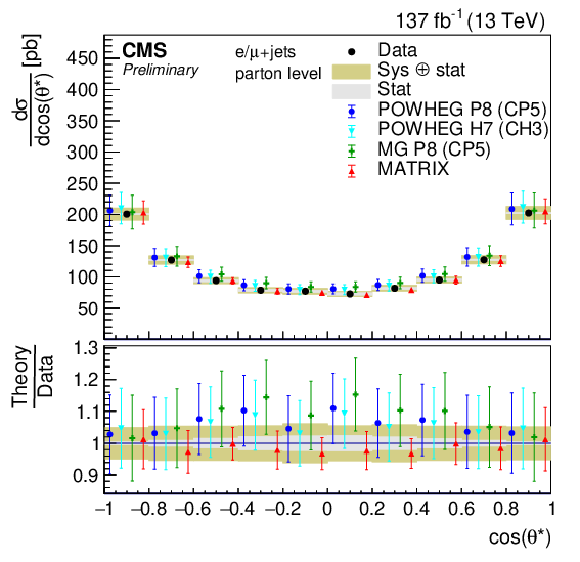
png pdf |
Figure 19-e:
Differential cross sections as functions of quantities of the tˉt system. The data are shown as points with light (dark) bands indicating the statistical (statistical and systematic) uncertainties. The cross sections are compared to the predictions of POWHEG combined with PYTHIA (P8) or HERWIG (H7), the multiparton simulation MG5_aMC@NLO (MG5)+PYTHIA FxFx, and the NNLO QCD calculations obtained with Matrix. The ratios of the various predictions to the measured cross sections are shown at the bottom of each panel. |
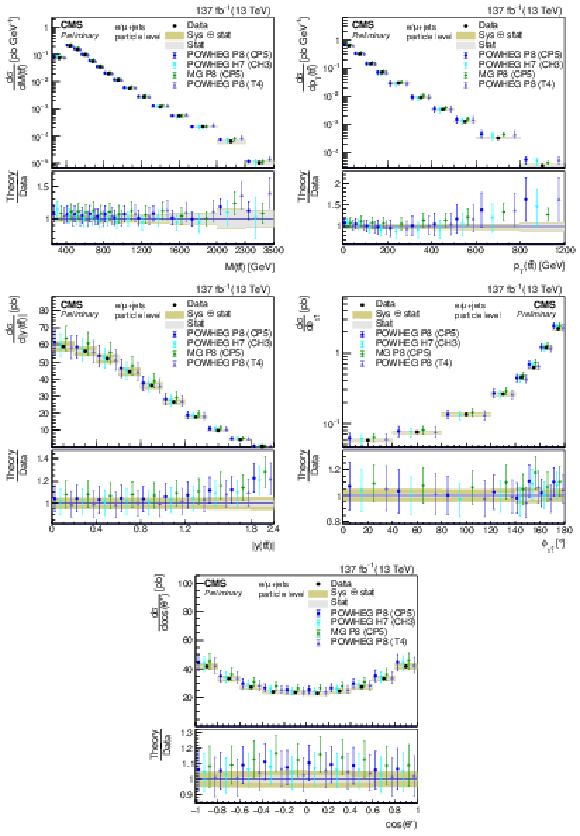
png pdf |
Figure 20:
Differential cross sections as functions of quantities of the tˉt system. The data are shown as points with light (dark) bands indicating the statistical (statistical and systematic) uncertainties. The cross sections are compared to the predictions of POWHEG +PYTHIA (P8) for the CP5 and CUETP8M2T4 (T4), POWHEG +HERWIG (H7), and the multiparton simulation MG5_aMC@NLO (MG)+PYTHIA. The ratios of the various predictions to the measured cross sections are shown at the bottom of each panel. |

png pdf |
Figure 20-a:
Differential cross sections as functions of quantities of the tˉt system. The data are shown as points with light (dark) bands indicating the statistical (statistical and systematic) uncertainties. The cross sections are compared to the predictions of POWHEG +PYTHIA (P8) for the CP5 and CUETP8M2T4 (T4), POWHEG +HERWIG (H7), and the multiparton simulation MG5_aMC@NLO (MG)+PYTHIA. The ratios of the various predictions to the measured cross sections are shown at the bottom of each panel. |

png pdf |
Figure 20-b:
Differential cross sections as functions of quantities of the tˉt system. The data are shown as points with light (dark) bands indicating the statistical (statistical and systematic) uncertainties. The cross sections are compared to the predictions of POWHEG +PYTHIA (P8) for the CP5 and CUETP8M2T4 (T4), POWHEG +HERWIG (H7), and the multiparton simulation MG5_aMC@NLO (MG)+PYTHIA. The ratios of the various predictions to the measured cross sections are shown at the bottom of each panel. |
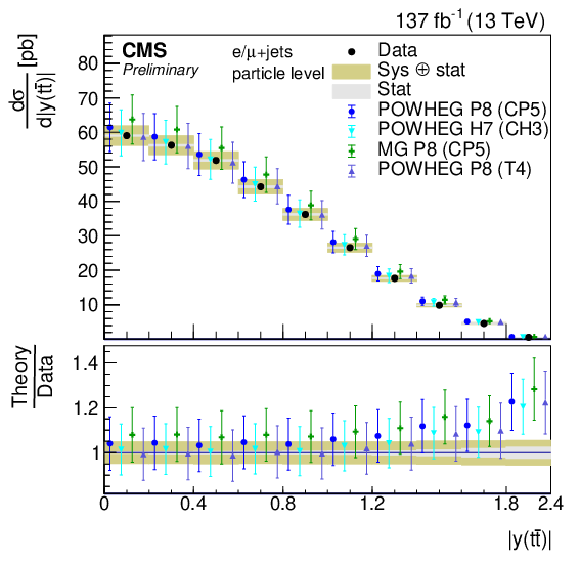
png pdf |
Figure 20-c:
Differential cross sections as functions of quantities of the tˉt system. The data are shown as points with light (dark) bands indicating the statistical (statistical and systematic) uncertainties. The cross sections are compared to the predictions of POWHEG +PYTHIA (P8) for the CP5 and CUETP8M2T4 (T4), POWHEG +HERWIG (H7), and the multiparton simulation MG5_aMC@NLO (MG)+PYTHIA. The ratios of the various predictions to the measured cross sections are shown at the bottom of each panel. |

png pdf |
Figure 20-d:
Differential cross sections as functions of quantities of the tˉt system. The data are shown as points with light (dark) bands indicating the statistical (statistical and systematic) uncertainties. The cross sections are compared to the predictions of POWHEG +PYTHIA (P8) for the CP5 and CUETP8M2T4 (T4), POWHEG +HERWIG (H7), and the multiparton simulation MG5_aMC@NLO (MG)+PYTHIA. The ratios of the various predictions to the measured cross sections are shown at the bottom of each panel. |

png pdf |
Figure 20-e:
Differential cross sections as functions of quantities of the tˉt system. The data are shown as points with light (dark) bands indicating the statistical (statistical and systematic) uncertainties. The cross sections are compared to the predictions of POWHEG +PYTHIA (P8) for the CP5 and CUETP8M2T4 (T4), POWHEG +HERWIG (H7), and the multiparton simulation MG5_aMC@NLO (MG)+PYTHIA. The ratios of the various predictions to the measured cross sections are shown at the bottom of each panel. |

png pdf |
Figure 21:
Double differential cross section as function of pT(th) vs |y(th)|. The data are shown as points with light (dark) bands indicating the statistical (statistical and systematic) uncertainties. The cross sections are compared to the predictions of POWHEG combined with PYTHIA (P8) or HERWIG (H7), the multiparton simulation MG5_aMC@NLO (MG5)+PYTHIA FxFx, and the NNLO QCD calculations obtained with Matrix. The ratios of the various predictions to the measured cross sections are shown at the bottom of each panel. |

png pdf |
Figure 21-a:
Double differential cross section as function of pT(th) vs |y(th)|. The data are shown as points with light (dark) bands indicating the statistical (statistical and systematic) uncertainties. The cross sections are compared to the predictions of POWHEG combined with PYTHIA (P8) or HERWIG (H7), the multiparton simulation MG5_aMC@NLO (MG5)+PYTHIA FxFx, and the NNLO QCD calculations obtained with Matrix. The ratios of the various predictions to the measured cross sections are shown at the bottom of each panel. |
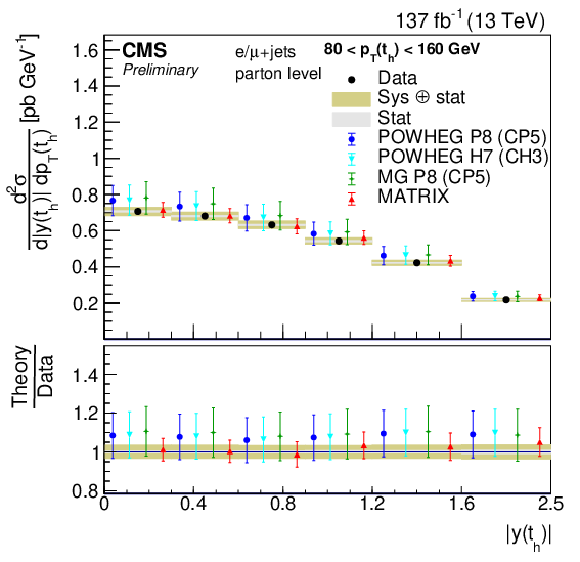
png pdf |
Figure 21-b:
Double differential cross section as function of pT(th) vs |y(th)|. The data are shown as points with light (dark) bands indicating the statistical (statistical and systematic) uncertainties. The cross sections are compared to the predictions of POWHEG combined with PYTHIA (P8) or HERWIG (H7), the multiparton simulation MG5_aMC@NLO (MG5)+PYTHIA FxFx, and the NNLO QCD calculations obtained with Matrix. The ratios of the various predictions to the measured cross sections are shown at the bottom of each panel. |

png pdf |
Figure 21-c:
Double differential cross section as function of pT(th) vs |y(th)|. The data are shown as points with light (dark) bands indicating the statistical (statistical and systematic) uncertainties. The cross sections are compared to the predictions of POWHEG combined with PYTHIA (P8) or HERWIG (H7), the multiparton simulation MG5_aMC@NLO (MG5)+PYTHIA FxFx, and the NNLO QCD calculations obtained with Matrix. The ratios of the various predictions to the measured cross sections are shown at the bottom of each panel. |
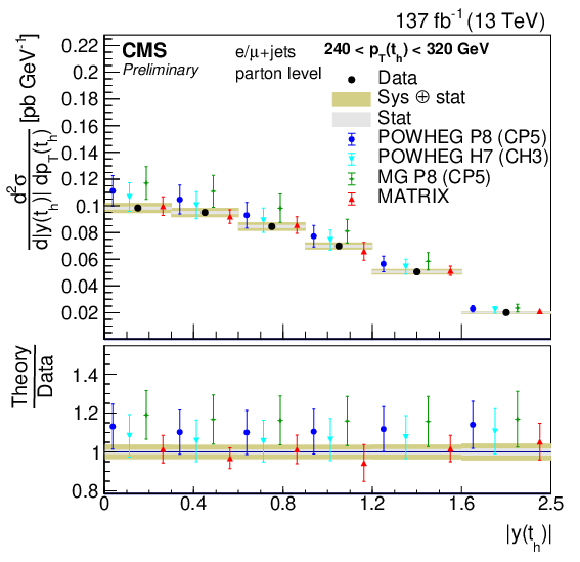
png pdf |
Figure 21-d:
Double differential cross section as function of pT(th) vs |y(th)|. The data are shown as points with light (dark) bands indicating the statistical (statistical and systematic) uncertainties. The cross sections are compared to the predictions of POWHEG combined with PYTHIA (P8) or HERWIG (H7), the multiparton simulation MG5_aMC@NLO (MG5)+PYTHIA FxFx, and the NNLO QCD calculations obtained with Matrix. The ratios of the various predictions to the measured cross sections are shown at the bottom of each panel. |

png pdf |
Figure 21-e:
Double differential cross section as function of pT(th) vs |y(th)|. The data are shown as points with light (dark) bands indicating the statistical (statistical and systematic) uncertainties. The cross sections are compared to the predictions of POWHEG combined with PYTHIA (P8) or HERWIG (H7), the multiparton simulation MG5_aMC@NLO (MG5)+PYTHIA FxFx, and the NNLO QCD calculations obtained with Matrix. The ratios of the various predictions to the measured cross sections are shown at the bottom of each panel. |

png pdf |
Figure 21-f:
Double differential cross section as function of pT(th) vs |y(th)|. The data are shown as points with light (dark) bands indicating the statistical (statistical and systematic) uncertainties. The cross sections are compared to the predictions of POWHEG combined with PYTHIA (P8) or HERWIG (H7), the multiparton simulation MG5_aMC@NLO (MG5)+PYTHIA FxFx, and the NNLO QCD calculations obtained with Matrix. The ratios of the various predictions to the measured cross sections are shown at the bottom of each panel. |
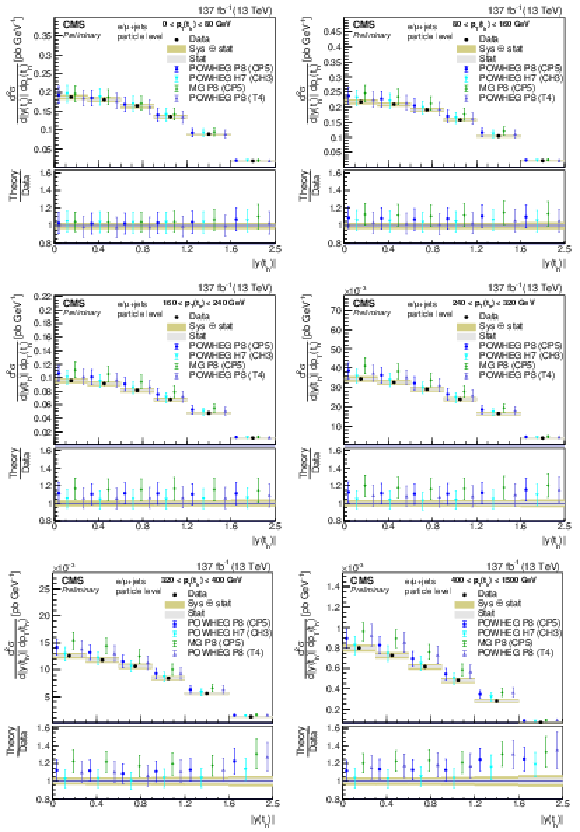
png pdf |
Figure 22:
Double differential cross section as function of pT(th) vs |y(th)|. The data are shown as points with light (dark) bands indicating the statistical (statistical and systematic) uncertainties. The cross sections are compared to the predictions of POWHEG +PYTHIA (P8) for the CP5 and CUETP8M2T4 (T4), POWHEG +HERWIG (H7), and the multiparton simulation MG5_aMC@NLO (MG)+PYTHIA. The ratios of the various predictions to the measured cross sections are shown at the bottom of each panel. |
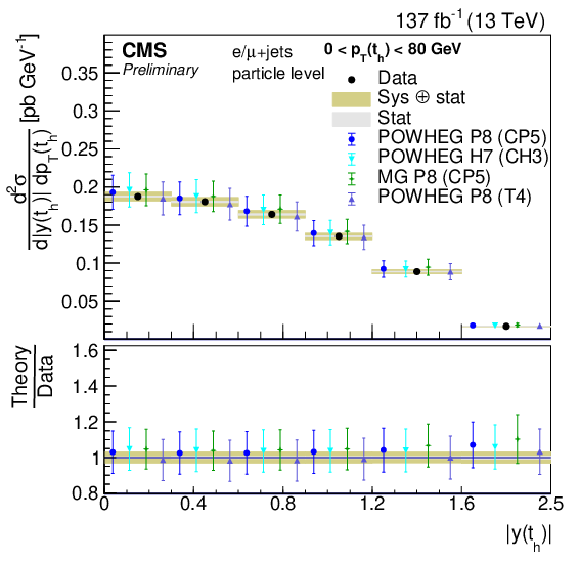
png pdf |
Figure 22-a:
Double differential cross section as function of pT(th) vs |y(th)|. The data are shown as points with light (dark) bands indicating the statistical (statistical and systematic) uncertainties. The cross sections are compared to the predictions of POWHEG +PYTHIA (P8) for the CP5 and CUETP8M2T4 (T4), POWHEG +HERWIG (H7), and the multiparton simulation MG5_aMC@NLO (MG)+PYTHIA. The ratios of the various predictions to the measured cross sections are shown at the bottom of each panel. |

png pdf |
Figure 22-b:
Double differential cross section as function of pT(th) vs |y(th)|. The data are shown as points with light (dark) bands indicating the statistical (statistical and systematic) uncertainties. The cross sections are compared to the predictions of POWHEG +PYTHIA (P8) for the CP5 and CUETP8M2T4 (T4), POWHEG +HERWIG (H7), and the multiparton simulation MG5_aMC@NLO (MG)+PYTHIA. The ratios of the various predictions to the measured cross sections are shown at the bottom of each panel. |
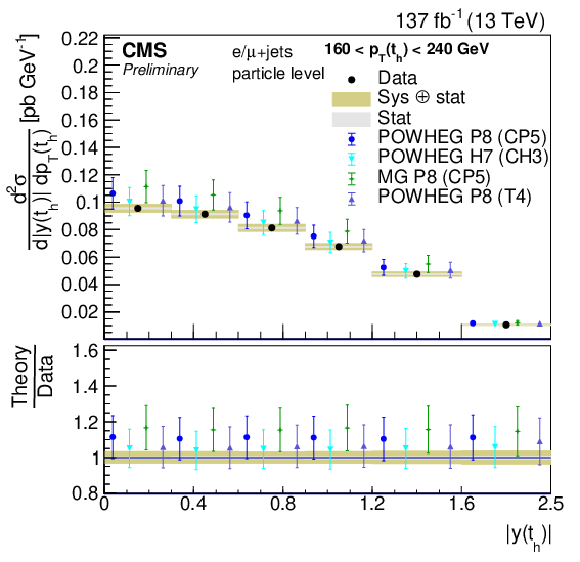
png pdf |
Figure 22-c:
Double differential cross section as function of pT(th) vs |y(th)|. The data are shown as points with light (dark) bands indicating the statistical (statistical and systematic) uncertainties. The cross sections are compared to the predictions of POWHEG +PYTHIA (P8) for the CP5 and CUETP8M2T4 (T4), POWHEG +HERWIG (H7), and the multiparton simulation MG5_aMC@NLO (MG)+PYTHIA. The ratios of the various predictions to the measured cross sections are shown at the bottom of each panel. |

png pdf |
Figure 22-d:
Double differential cross section as function of pT(th) vs |y(th)|. The data are shown as points with light (dark) bands indicating the statistical (statistical and systematic) uncertainties. The cross sections are compared to the predictions of POWHEG +PYTHIA (P8) for the CP5 and CUETP8M2T4 (T4), POWHEG +HERWIG (H7), and the multiparton simulation MG5_aMC@NLO (MG)+PYTHIA. The ratios of the various predictions to the measured cross sections are shown at the bottom of each panel. |
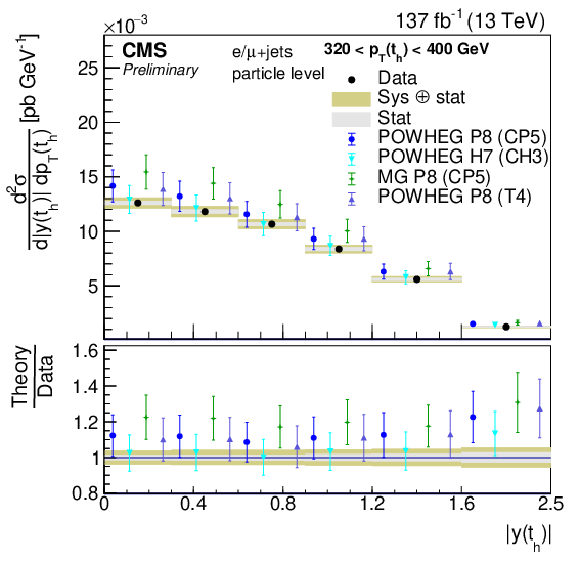
png pdf |
Figure 22-e:
Double differential cross section as function of pT(th) vs |y(th)|. The data are shown as points with light (dark) bands indicating the statistical (statistical and systematic) uncertainties. The cross sections are compared to the predictions of POWHEG +PYTHIA (P8) for the CP5 and CUETP8M2T4 (T4), POWHEG +HERWIG (H7), and the multiparton simulation MG5_aMC@NLO (MG)+PYTHIA. The ratios of the various predictions to the measured cross sections are shown at the bottom of each panel. |

png pdf |
Figure 22-f:
Double differential cross section as function of pT(th) vs |y(th)|. The data are shown as points with light (dark) bands indicating the statistical (statistical and systematic) uncertainties. The cross sections are compared to the predictions of POWHEG +PYTHIA (P8) for the CP5 and CUETP8M2T4 (T4), POWHEG +HERWIG (H7), and the multiparton simulation MG5_aMC@NLO (MG)+PYTHIA. The ratios of the various predictions to the measured cross sections are shown at the bottom of each panel. |
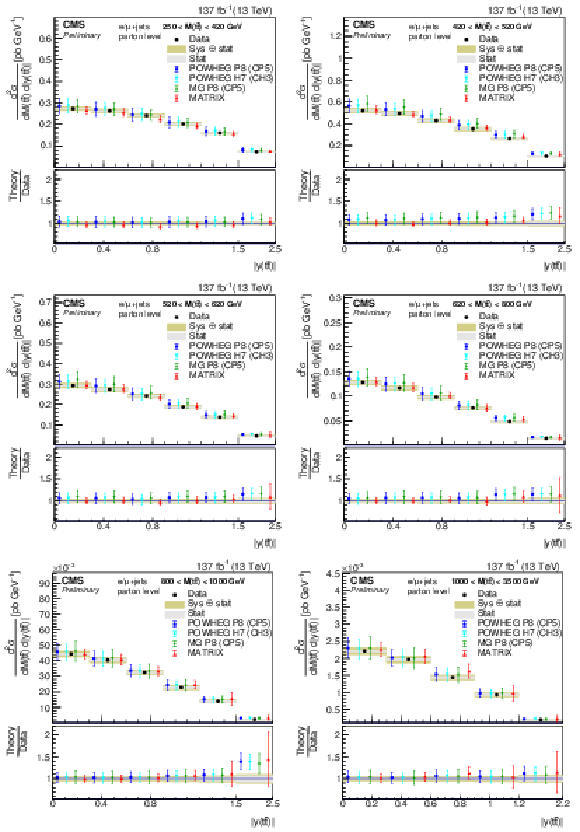
png pdf |
Figure 23:
Double differential cross section as function of M(tˉt) vs |y(tˉt)|. The data are shown as points with light (dark) bands indicating the statistical (statistical and systematic) uncertainties. The cross sections are compared to the predictions of POWHEG combined with PYTHIA (P8) or HERWIG (H7), the multiparton simulation MG5_aMC@NLO (MG5)+PYTHIA FxFx, and the NNLO QCD calculations obtained with Matrix. The ratios of the various predictions to the measured cross sections are shown at the bottom of each panel. |

png pdf |
Figure 23-a:
Double differential cross section as function of M(tˉt) vs |y(tˉt)|. The data are shown as points with light (dark) bands indicating the statistical (statistical and systematic) uncertainties. The cross sections are compared to the predictions of POWHEG combined with PYTHIA (P8) or HERWIG (H7), the multiparton simulation MG5_aMC@NLO (MG5)+PYTHIA FxFx, and the NNLO QCD calculations obtained with Matrix. The ratios of the various predictions to the measured cross sections are shown at the bottom of each panel. |
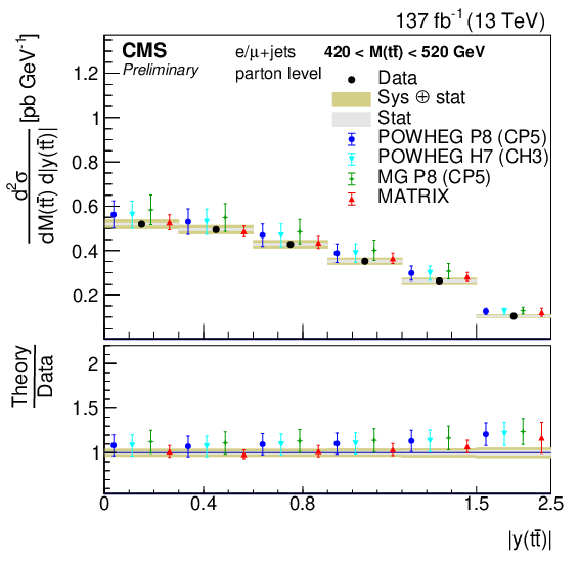
png pdf |
Figure 23-b:
Double differential cross section as function of M(tˉt) vs |y(tˉt)|. The data are shown as points with light (dark) bands indicating the statistical (statistical and systematic) uncertainties. The cross sections are compared to the predictions of POWHEG combined with PYTHIA (P8) or HERWIG (H7), the multiparton simulation MG5_aMC@NLO (MG5)+PYTHIA FxFx, and the NNLO QCD calculations obtained with Matrix. The ratios of the various predictions to the measured cross sections are shown at the bottom of each panel. |
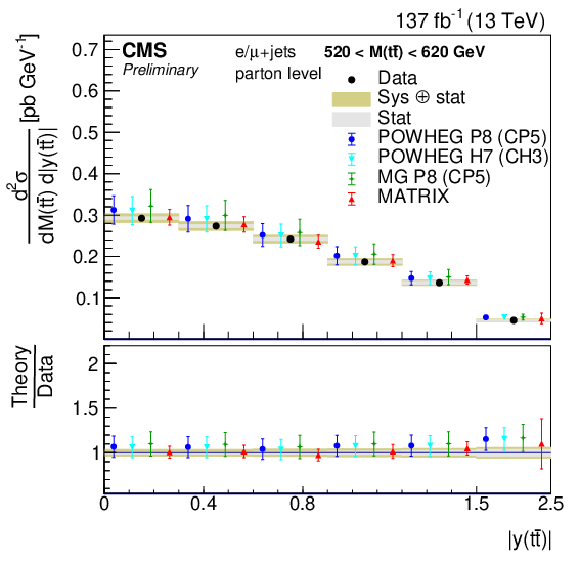
png pdf |
Figure 23-c:
Double differential cross section as function of M(tˉt) vs |y(tˉt)|. The data are shown as points with light (dark) bands indicating the statistical (statistical and systematic) uncertainties. The cross sections are compared to the predictions of POWHEG combined with PYTHIA (P8) or HERWIG (H7), the multiparton simulation MG5_aMC@NLO (MG5)+PYTHIA FxFx, and the NNLO QCD calculations obtained with Matrix. The ratios of the various predictions to the measured cross sections are shown at the bottom of each panel. |
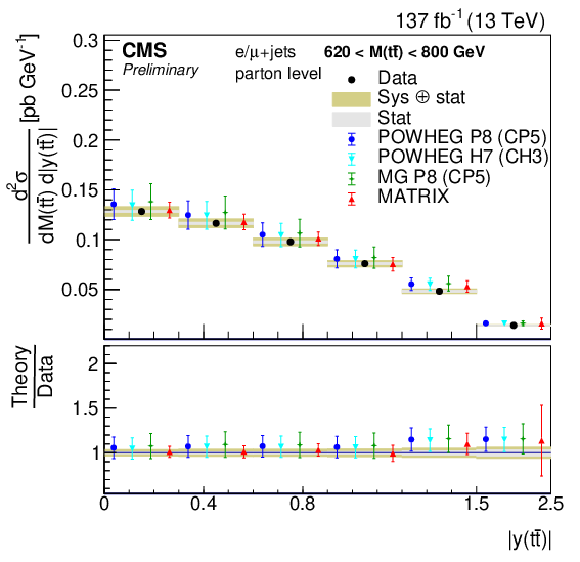
png pdf |
Figure 23-d:
Double differential cross section as function of M(tˉt) vs |y(tˉt)|. The data are shown as points with light (dark) bands indicating the statistical (statistical and systematic) uncertainties. The cross sections are compared to the predictions of POWHEG combined with PYTHIA (P8) or HERWIG (H7), the multiparton simulation MG5_aMC@NLO (MG5)+PYTHIA FxFx, and the NNLO QCD calculations obtained with Matrix. The ratios of the various predictions to the measured cross sections are shown at the bottom of each panel. |
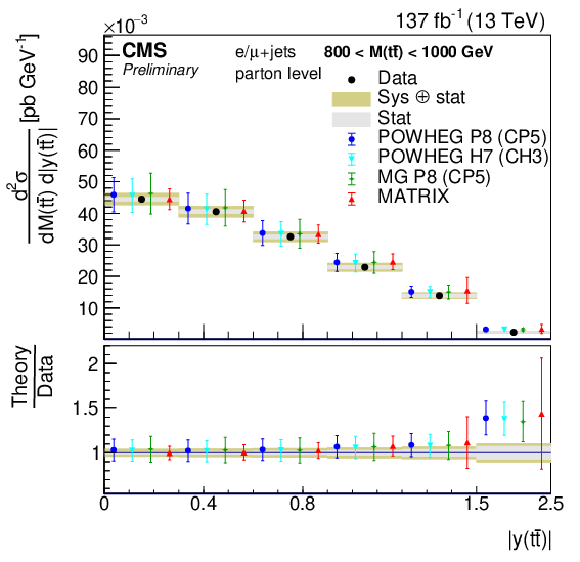
png pdf |
Figure 23-e:
Double differential cross section as function of M(tˉt) vs |y(tˉt)|. The data are shown as points with light (dark) bands indicating the statistical (statistical and systematic) uncertainties. The cross sections are compared to the predictions of POWHEG combined with PYTHIA (P8) or HERWIG (H7), the multiparton simulation MG5_aMC@NLO (MG5)+PYTHIA FxFx, and the NNLO QCD calculations obtained with Matrix. The ratios of the various predictions to the measured cross sections are shown at the bottom of each panel. |

png pdf |
Figure 23-f:
Double differential cross section as function of M(tˉt) vs |y(tˉt)|. The data are shown as points with light (dark) bands indicating the statistical (statistical and systematic) uncertainties. The cross sections are compared to the predictions of POWHEG combined with PYTHIA (P8) or HERWIG (H7), the multiparton simulation MG5_aMC@NLO (MG5)+PYTHIA FxFx, and the NNLO QCD calculations obtained with Matrix. The ratios of the various predictions to the measured cross sections are shown at the bottom of each panel. |

png pdf |
Figure 24:
Double differential cross section as function of M(tˉt) vs |y(tˉt)|. The data are shown as points with light (dark) bands indicating the statistical (statistical and systematic) uncertainties. The cross sections are compared to the predictions of POWHEG +PYTHIA (P8) for the CP5 and CUETP8M2T4 (T4), POWHEG +HERWIG (H7), and the multiparton simulation MG5_aMC@NLO (MG)+PYTHIA. The ratios of the various predictions to the measured cross sections are shown at the bottom of each panel. |

png pdf |
Figure 24-a:
Double differential cross section as function of M(tˉt) vs |y(tˉt)|. The data are shown as points with light (dark) bands indicating the statistical (statistical and systematic) uncertainties. The cross sections are compared to the predictions of POWHEG +PYTHIA (P8) for the CP5 and CUETP8M2T4 (T4), POWHEG +HERWIG (H7), and the multiparton simulation MG5_aMC@NLO (MG)+PYTHIA. The ratios of the various predictions to the measured cross sections are shown at the bottom of each panel. |
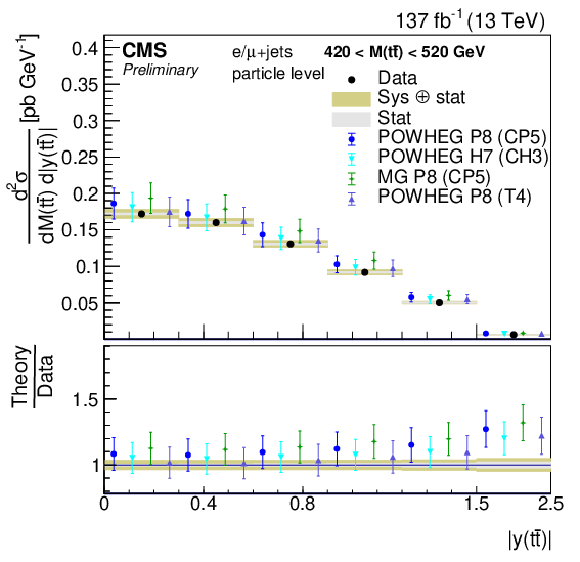
png pdf |
Figure 24-b:
Double differential cross section as function of M(tˉt) vs |y(tˉt)|. The data are shown as points with light (dark) bands indicating the statistical (statistical and systematic) uncertainties. The cross sections are compared to the predictions of POWHEG +PYTHIA (P8) for the CP5 and CUETP8M2T4 (T4), POWHEG +HERWIG (H7), and the multiparton simulation MG5_aMC@NLO (MG)+PYTHIA. The ratios of the various predictions to the measured cross sections are shown at the bottom of each panel. |
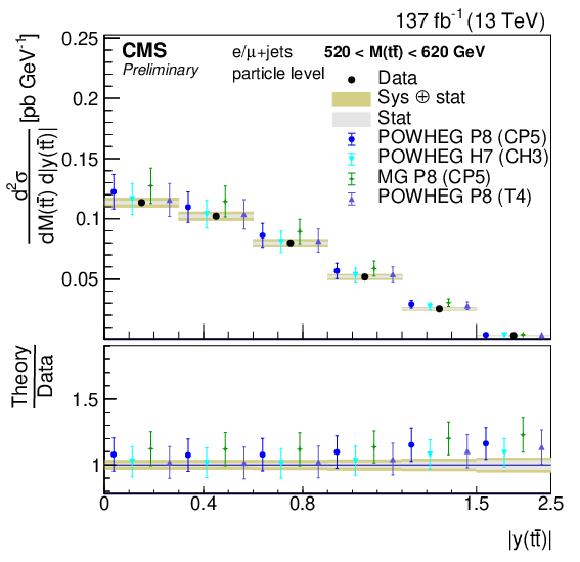
png pdf |
Figure 24-c:
Double differential cross section as function of M(tˉt) vs |y(tˉt)|. The data are shown as points with light (dark) bands indicating the statistical (statistical and systematic) uncertainties. The cross sections are compared to the predictions of POWHEG +PYTHIA (P8) for the CP5 and CUETP8M2T4 (T4), POWHEG +HERWIG (H7), and the multiparton simulation MG5_aMC@NLO (MG)+PYTHIA. The ratios of the various predictions to the measured cross sections are shown at the bottom of each panel. |
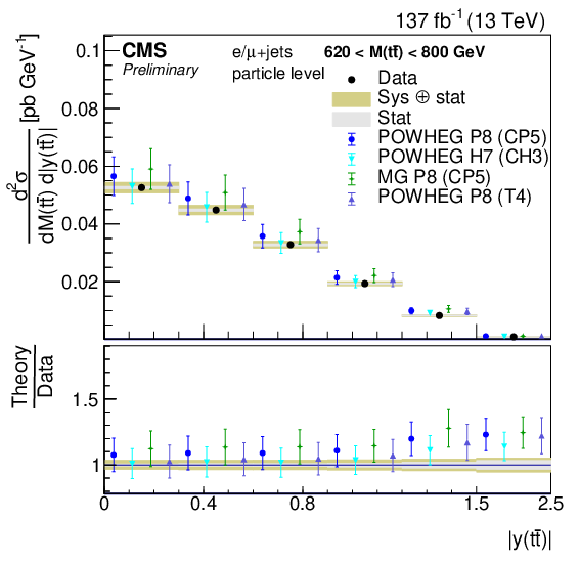
png pdf |
Figure 24-d:
Double differential cross section as function of M(tˉt) vs |y(tˉt)|. The data are shown as points with light (dark) bands indicating the statistical (statistical and systematic) uncertainties. The cross sections are compared to the predictions of POWHEG +PYTHIA (P8) for the CP5 and CUETP8M2T4 (T4), POWHEG +HERWIG (H7), and the multiparton simulation MG5_aMC@NLO (MG)+PYTHIA. The ratios of the various predictions to the measured cross sections are shown at the bottom of each panel. |

png pdf |
Figure 24-e:
Double differential cross section as function of M(tˉt) vs |y(tˉt)|. The data are shown as points with light (dark) bands indicating the statistical (statistical and systematic) uncertainties. The cross sections are compared to the predictions of POWHEG +PYTHIA (P8) for the CP5 and CUETP8M2T4 (T4), POWHEG +HERWIG (H7), and the multiparton simulation MG5_aMC@NLO (MG)+PYTHIA. The ratios of the various predictions to the measured cross sections are shown at the bottom of each panel. |
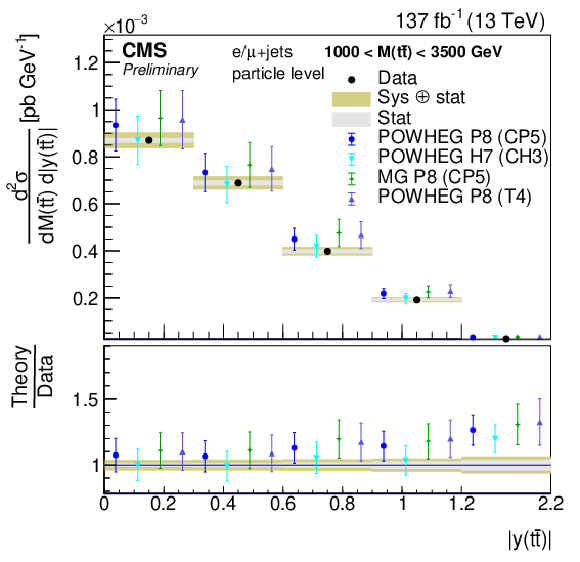
png pdf |
Figure 24-f:
Double differential cross section as function of M(tˉt) vs |y(tˉt)|. The data are shown as points with light (dark) bands indicating the statistical (statistical and systematic) uncertainties. The cross sections are compared to the predictions of POWHEG +PYTHIA (P8) for the CP5 and CUETP8M2T4 (T4), POWHEG +HERWIG (H7), and the multiparton simulation MG5_aMC@NLO (MG)+PYTHIA. The ratios of the various predictions to the measured cross sections are shown at the bottom of each panel. |

png pdf |
Figure 25:
Double differential cross section as function of M(tˉt) vs \qopnameelaxocos(θ∗). The data are shown as points with light (dark) bands indicating the statistical (statistical and systematic) uncertainties. The cross sections are compared to the predictions of POWHEG combined with PYTHIA (P8) or HERWIG (H7), the multiparton simulation MG5_aMC@NLO (MG5)+PYTHIA FxFx, and the NNLO QCD calculations obtained with Matrix. The ratios of the various predictions to the measured cross sections are shown at the bottom of each panel. |
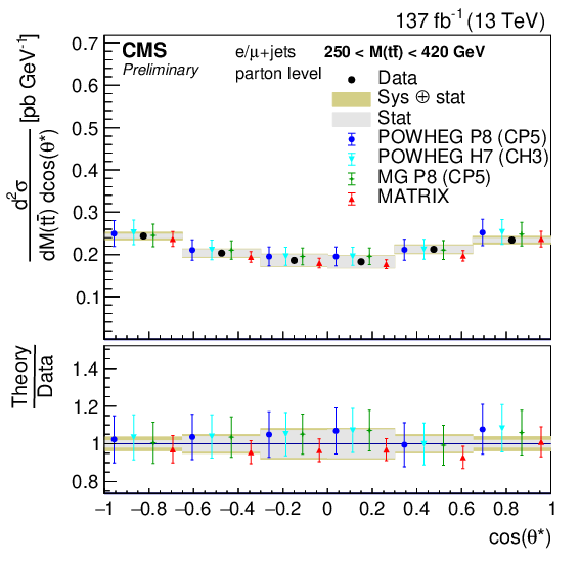
png pdf |
Figure 25-a:
Double differential cross section as function of M(tˉt) vs \qopnameelaxocos(θ∗). The data are shown as points with light (dark) bands indicating the statistical (statistical and systematic) uncertainties. The cross sections are compared to the predictions of POWHEG combined with PYTHIA (P8) or HERWIG (H7), the multiparton simulation MG5_aMC@NLO (MG5)+PYTHIA FxFx, and the NNLO QCD calculations obtained with Matrix. The ratios of the various predictions to the measured cross sections are shown at the bottom of each panel. |
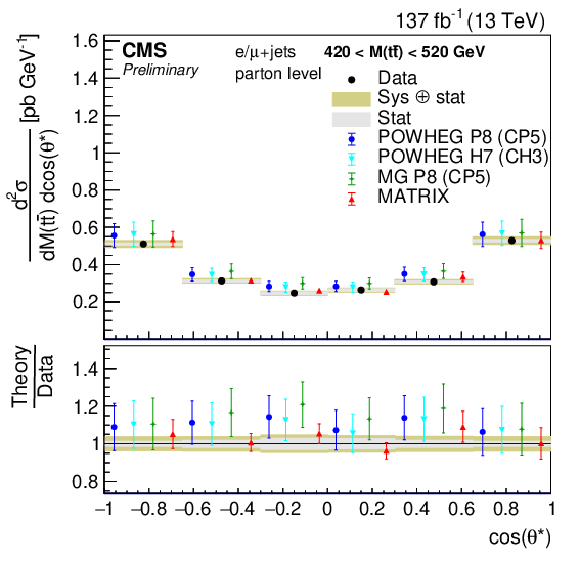
png pdf |
Figure 25-b:
Double differential cross section as function of M(tˉt) vs \qopnameelaxocos(θ∗). The data are shown as points with light (dark) bands indicating the statistical (statistical and systematic) uncertainties. The cross sections are compared to the predictions of POWHEG combined with PYTHIA (P8) or HERWIG (H7), the multiparton simulation MG5_aMC@NLO (MG5)+PYTHIA FxFx, and the NNLO QCD calculations obtained with Matrix. The ratios of the various predictions to the measured cross sections are shown at the bottom of each panel. |

png pdf |
Figure 25-c:
Double differential cross section as function of M(tˉt) vs \qopnameelaxocos(θ∗). The data are shown as points with light (dark) bands indicating the statistical (statistical and systematic) uncertainties. The cross sections are compared to the predictions of POWHEG combined with PYTHIA (P8) or HERWIG (H7), the multiparton simulation MG5_aMC@NLO (MG5)+PYTHIA FxFx, and the NNLO QCD calculations obtained with Matrix. The ratios of the various predictions to the measured cross sections are shown at the bottom of each panel. |

png pdf |
Figure 25-d:
Double differential cross section as function of M(tˉt) vs \qopnameelaxocos(θ∗). The data are shown as points with light (dark) bands indicating the statistical (statistical and systematic) uncertainties. The cross sections are compared to the predictions of POWHEG combined with PYTHIA (P8) or HERWIG (H7), the multiparton simulation MG5_aMC@NLO (MG5)+PYTHIA FxFx, and the NNLO QCD calculations obtained with Matrix. The ratios of the various predictions to the measured cross sections are shown at the bottom of each panel. |

png pdf |
Figure 25-e:
Double differential cross section as function of M(tˉt) vs \qopnameelaxocos(θ∗). The data are shown as points with light (dark) bands indicating the statistical (statistical and systematic) uncertainties. The cross sections are compared to the predictions of POWHEG combined with PYTHIA (P8) or HERWIG (H7), the multiparton simulation MG5_aMC@NLO (MG5)+PYTHIA FxFx, and the NNLO QCD calculations obtained with Matrix. The ratios of the various predictions to the measured cross sections are shown at the bottom of each panel. |

png pdf |
Figure 25-f:
Double differential cross section as function of M(tˉt) vs \qopnameelaxocos(θ∗). The data are shown as points with light (dark) bands indicating the statistical (statistical and systematic) uncertainties. The cross sections are compared to the predictions of POWHEG combined with PYTHIA (P8) or HERWIG (H7), the multiparton simulation MG5_aMC@NLO (MG5)+PYTHIA FxFx, and the NNLO QCD calculations obtained with Matrix. The ratios of the various predictions to the measured cross sections are shown at the bottom of each panel. |
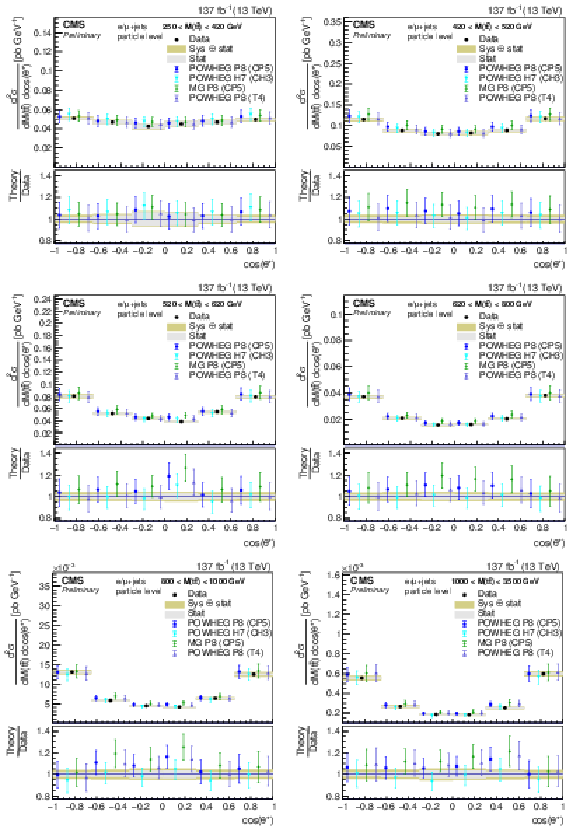
png pdf |
Figure 26:
Double differential cross section as function of M(tˉt) vs \qopnameelaxocos(θ∗). The data are shown as points with light (dark) bands indicating the statistical (statistical and systematic) uncertainties. The cross sections are compared to the predictions of POWHEG +PYTHIA (P8) for the CP5 and CUETP8M2T4 (T4), POWHEG +HERWIG (H7), and the multiparton simulation MG5_aMC@NLO (MG)+PYTHIA. The ratios of the various predictions to the measured cross sections are shown at the bottom of each panel. |

png pdf |
Figure 26-a:
Double differential cross section as function of M(tˉt) vs \qopnameelaxocos(θ∗). The data are shown as points with light (dark) bands indicating the statistical (statistical and systematic) uncertainties. The cross sections are compared to the predictions of POWHEG +PYTHIA (P8) for the CP5 and CUETP8M2T4 (T4), POWHEG +HERWIG (H7), and the multiparton simulation MG5_aMC@NLO (MG)+PYTHIA. The ratios of the various predictions to the measured cross sections are shown at the bottom of each panel. |

png pdf |
Figure 26-b:
Double differential cross section as function of M(tˉt) vs \qopnameelaxocos(θ∗). The data are shown as points with light (dark) bands indicating the statistical (statistical and systematic) uncertainties. The cross sections are compared to the predictions of POWHEG +PYTHIA (P8) for the CP5 and CUETP8M2T4 (T4), POWHEG +HERWIG (H7), and the multiparton simulation MG5_aMC@NLO (MG)+PYTHIA. The ratios of the various predictions to the measured cross sections are shown at the bottom of each panel. |

png pdf |
Figure 26-c:
Double differential cross section as function of M(tˉt) vs \qopnameelaxocos(θ∗). The data are shown as points with light (dark) bands indicating the statistical (statistical and systematic) uncertainties. The cross sections are compared to the predictions of POWHEG +PYTHIA (P8) for the CP5 and CUETP8M2T4 (T4), POWHEG +HERWIG (H7), and the multiparton simulation MG5_aMC@NLO (MG)+PYTHIA. The ratios of the various predictions to the measured cross sections are shown at the bottom of each panel. |
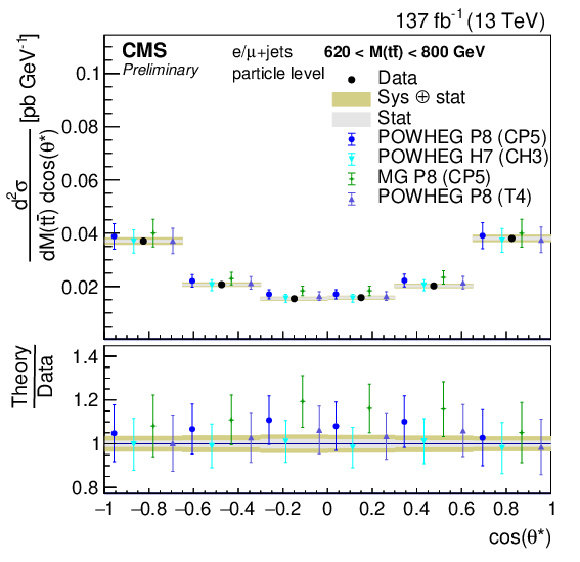
png pdf |
Figure 26-d:
Double differential cross section as function of M(tˉt) vs \qopnameelaxocos(θ∗). The data are shown as points with light (dark) bands indicating the statistical (statistical and systematic) uncertainties. The cross sections are compared to the predictions of POWHEG +PYTHIA (P8) for the CP5 and CUETP8M2T4 (T4), POWHEG +HERWIG (H7), and the multiparton simulation MG5_aMC@NLO (MG)+PYTHIA. The ratios of the various predictions to the measured cross sections are shown at the bottom of each panel. |
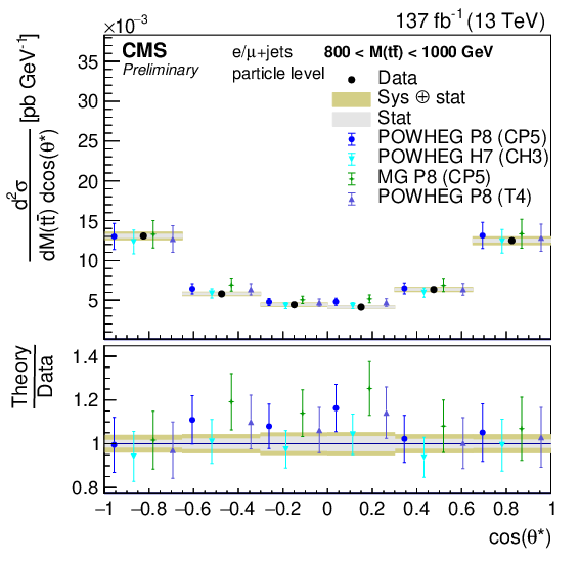
png pdf |
Figure 26-e:
Double differential cross section as function of M(tˉt) vs \qopnameelaxocos(θ∗). The data are shown as points with light (dark) bands indicating the statistical (statistical and systematic) uncertainties. The cross sections are compared to the predictions of POWHEG +PYTHIA (P8) for the CP5 and CUETP8M2T4 (T4), POWHEG +HERWIG (H7), and the multiparton simulation MG5_aMC@NLO (MG)+PYTHIA. The ratios of the various predictions to the measured cross sections are shown at the bottom of each panel. |
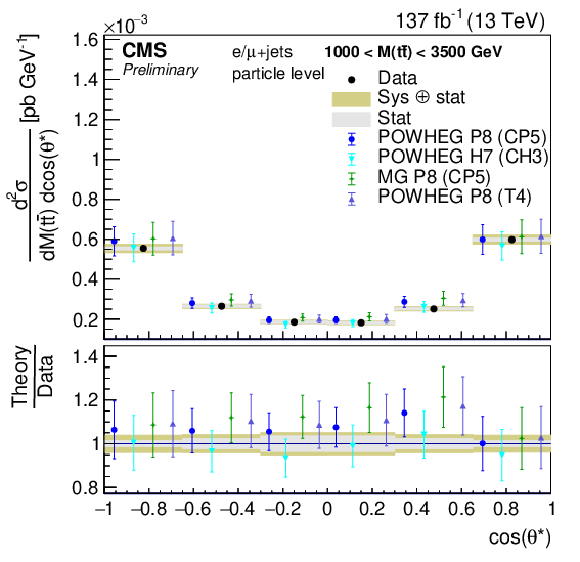
png pdf |
Figure 26-f:
Double differential cross section as function of M(tˉt) vs \qopnameelaxocos(θ∗). The data are shown as points with light (dark) bands indicating the statistical (statistical and systematic) uncertainties. The cross sections are compared to the predictions of POWHEG +PYTHIA (P8) for the CP5 and CUETP8M2T4 (T4), POWHEG +HERWIG (H7), and the multiparton simulation MG5_aMC@NLO (MG)+PYTHIA. The ratios of the various predictions to the measured cross sections are shown at the bottom of each panel. |

png pdf |
Figure 27:
Double differential cross section as function of M(tˉt) vs pT(th). The data are shown as points with light (dark) bands indicating the statistical (statistical and systematic) uncertainties. The cross sections are compared to the predictions of POWHEG combined with PYTHIA (P8) or HERWIG (H7), the multiparton simulation MG5_aMC@NLO (MG5)+PYTHIA FxFx, and the NNLO QCD calculations obtained with Matrix. The ratios of the various predictions to the measured cross sections are shown at the bottom of each panel. |
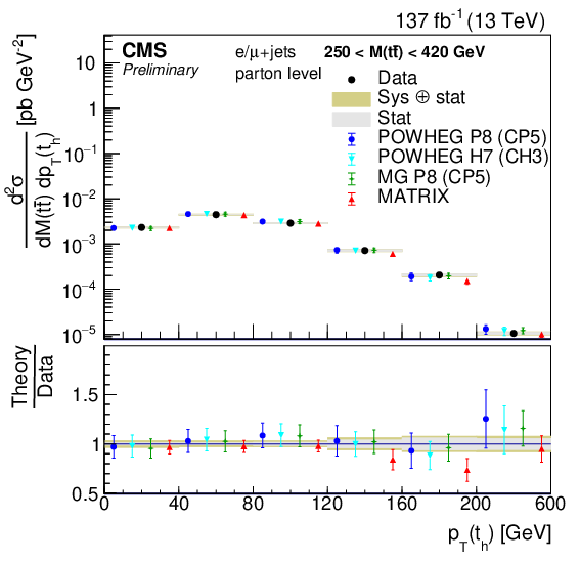
png pdf |
Figure 27-a:
Double differential cross section as function of M(tˉt) vs pT(th). The data are shown as points with light (dark) bands indicating the statistical (statistical and systematic) uncertainties. The cross sections are compared to the predictions of POWHEG combined with PYTHIA (P8) or HERWIG (H7), the multiparton simulation MG5_aMC@NLO (MG5)+PYTHIA FxFx, and the NNLO QCD calculations obtained with Matrix. The ratios of the various predictions to the measured cross sections are shown at the bottom of each panel. |

png pdf |
Figure 27-b:
Double differential cross section as function of M(tˉt) vs pT(th). The data are shown as points with light (dark) bands indicating the statistical (statistical and systematic) uncertainties. The cross sections are compared to the predictions of POWHEG combined with PYTHIA (P8) or HERWIG (H7), the multiparton simulation MG5_aMC@NLO (MG5)+PYTHIA FxFx, and the NNLO QCD calculations obtained with Matrix. The ratios of the various predictions to the measured cross sections are shown at the bottom of each panel. |

png pdf |
Figure 27-c:
Double differential cross section as function of M(tˉt) vs pT(th). The data are shown as points with light (dark) bands indicating the statistical (statistical and systematic) uncertainties. The cross sections are compared to the predictions of POWHEG combined with PYTHIA (P8) or HERWIG (H7), the multiparton simulation MG5_aMC@NLO (MG5)+PYTHIA FxFx, and the NNLO QCD calculations obtained with Matrix. The ratios of the various predictions to the measured cross sections are shown at the bottom of each panel. |

png pdf |
Figure 27-d:
Double differential cross section as function of M(tˉt) vs pT(th). The data are shown as points with light (dark) bands indicating the statistical (statistical and systematic) uncertainties. The cross sections are compared to the predictions of POWHEG combined with PYTHIA (P8) or HERWIG (H7), the multiparton simulation MG5_aMC@NLO (MG5)+PYTHIA FxFx, and the NNLO QCD calculations obtained with Matrix. The ratios of the various predictions to the measured cross sections are shown at the bottom of each panel. |

png pdf |
Figure 27-e:
Double differential cross section as function of M(tˉt) vs pT(th). The data are shown as points with light (dark) bands indicating the statistical (statistical and systematic) uncertainties. The cross sections are compared to the predictions of POWHEG combined with PYTHIA (P8) or HERWIG (H7), the multiparton simulation MG5_aMC@NLO (MG5)+PYTHIA FxFx, and the NNLO QCD calculations obtained with Matrix. The ratios of the various predictions to the measured cross sections are shown at the bottom of each panel. |

png pdf |
Figure 27-f:
Double differential cross section as function of M(tˉt) vs pT(th). The data are shown as points with light (dark) bands indicating the statistical (statistical and systematic) uncertainties. The cross sections are compared to the predictions of POWHEG combined with PYTHIA (P8) or HERWIG (H7), the multiparton simulation MG5_aMC@NLO (MG5)+PYTHIA FxFx, and the NNLO QCD calculations obtained with Matrix. The ratios of the various predictions to the measured cross sections are shown at the bottom of each panel. |
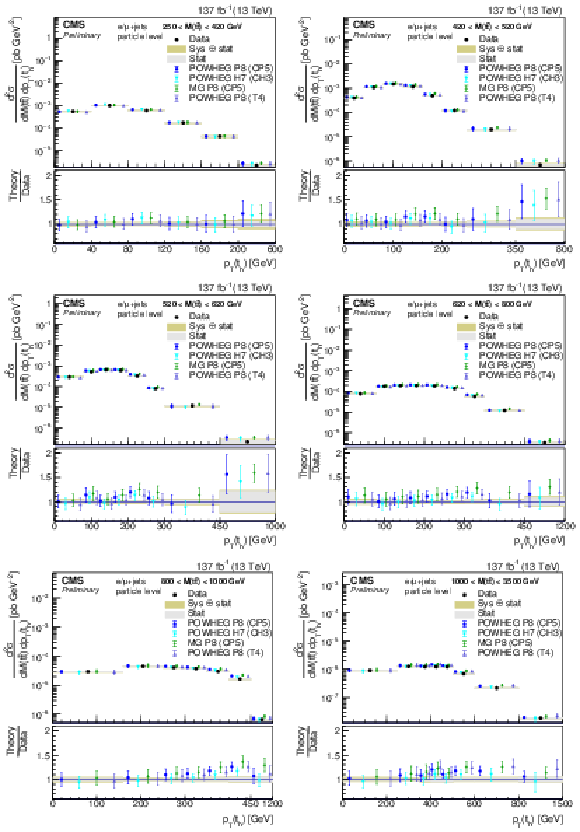
png pdf |
Figure 28:
Double differential cross section as function of M(tˉt) vs pT(th). The data are shown as points with light (dark) bands indicating the statistical (statistical and systematic) uncertainties. The cross sections are compared to the predictions of POWHEG +PYTHIA (P8) for the CP5 and CUETP8M2T4 (T4), POWHEG +HERWIG (H7), and the multiparton simulation MG5_aMC@NLO (MG)+PYTHIA. The ratios of the various predictions to the measured cross sections are shown at the bottom of each panel. |

png pdf |
Figure 28-a:
Double differential cross section as function of M(tˉt) vs pT(th). The data are shown as points with light (dark) bands indicating the statistical (statistical and systematic) uncertainties. The cross sections are compared to the predictions of POWHEG +PYTHIA (P8) for the CP5 and CUETP8M2T4 (T4), POWHEG +HERWIG (H7), and the multiparton simulation MG5_aMC@NLO (MG)+PYTHIA. The ratios of the various predictions to the measured cross sections are shown at the bottom of each panel. |

png pdf |
Figure 28-b:
Double differential cross section as function of M(tˉt) vs pT(th). The data are shown as points with light (dark) bands indicating the statistical (statistical and systematic) uncertainties. The cross sections are compared to the predictions of POWHEG +PYTHIA (P8) for the CP5 and CUETP8M2T4 (T4), POWHEG +HERWIG (H7), and the multiparton simulation MG5_aMC@NLO (MG)+PYTHIA. The ratios of the various predictions to the measured cross sections are shown at the bottom of each panel. |

png pdf |
Figure 28-c:
Double differential cross section as function of M(tˉt) vs pT(th). The data are shown as points with light (dark) bands indicating the statistical (statistical and systematic) uncertainties. The cross sections are compared to the predictions of POWHEG +PYTHIA (P8) for the CP5 and CUETP8M2T4 (T4), POWHEG +HERWIG (H7), and the multiparton simulation MG5_aMC@NLO (MG)+PYTHIA. The ratios of the various predictions to the measured cross sections are shown at the bottom of each panel. |

png pdf |
Figure 28-d:
Double differential cross section as function of M(tˉt) vs pT(th). The data are shown as points with light (dark) bands indicating the statistical (statistical and systematic) uncertainties. The cross sections are compared to the predictions of POWHEG +PYTHIA (P8) for the CP5 and CUETP8M2T4 (T4), POWHEG +HERWIG (H7), and the multiparton simulation MG5_aMC@NLO (MG)+PYTHIA. The ratios of the various predictions to the measured cross sections are shown at the bottom of each panel. |
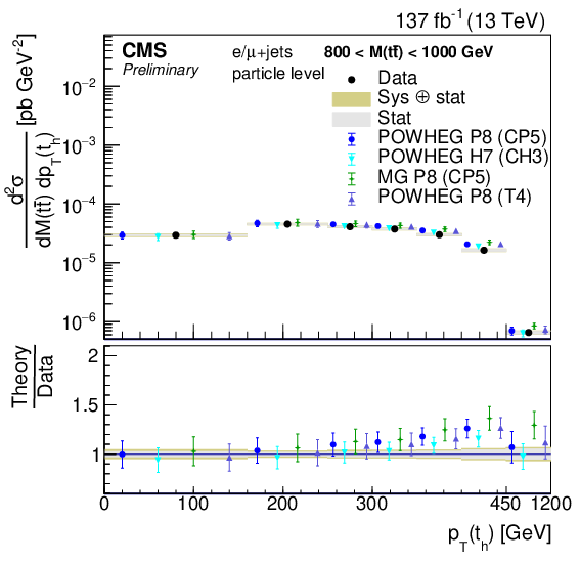
png pdf |
Figure 28-e:
Double differential cross section as function of M(tˉt) vs pT(th). The data are shown as points with light (dark) bands indicating the statistical (statistical and systematic) uncertainties. The cross sections are compared to the predictions of POWHEG +PYTHIA (P8) for the CP5 and CUETP8M2T4 (T4), POWHEG +HERWIG (H7), and the multiparton simulation MG5_aMC@NLO (MG)+PYTHIA. The ratios of the various predictions to the measured cross sections are shown at the bottom of each panel. |

png pdf |
Figure 28-f:
Double differential cross section as function of M(tˉt) vs pT(th). The data are shown as points with light (dark) bands indicating the statistical (statistical and systematic) uncertainties. The cross sections are compared to the predictions of POWHEG +PYTHIA (P8) for the CP5 and CUETP8M2T4 (T4), POWHEG +HERWIG (H7), and the multiparton simulation MG5_aMC@NLO (MG)+PYTHIA. The ratios of the various predictions to the measured cross sections are shown at the bottom of each panel. |
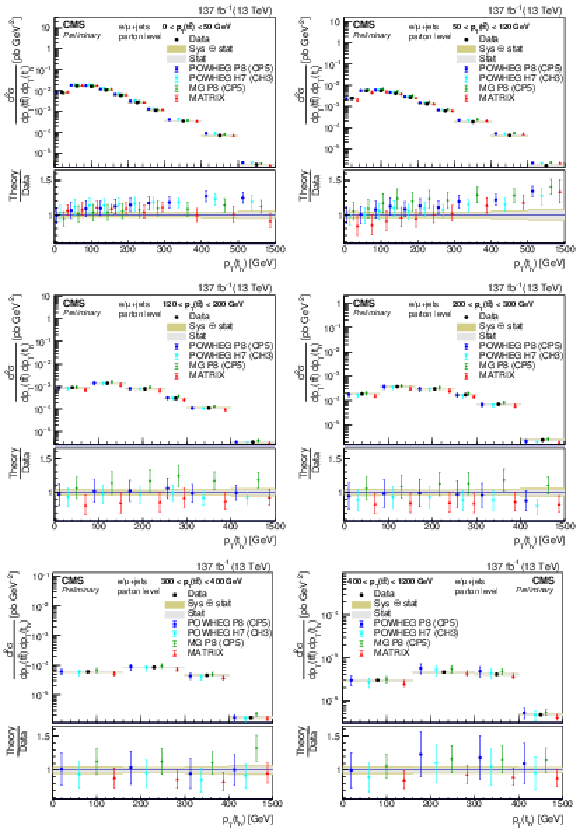
png pdf |
Figure 29:
Double differential cross section as function of pT(tˉt) vs pT(th). The data are shown as points with light (dark) bands indicating the statistical (statistical and systematic) uncertainties. The cross sections are compared to the predictions of POWHEG combined with PYTHIA (P8) or HERWIG (H7), the multiparton simulation MG5_aMC@NLO (MG5)+PYTHIA FxFx, and the NNLO QCD calculations obtained with Matrix. The ratios of the various predictions to the measured cross sections are shown at the bottom of each panel. |

png pdf |
Figure 29-a:
Double differential cross section as function of pT(tˉt) vs pT(th). The data are shown as points with light (dark) bands indicating the statistical (statistical and systematic) uncertainties. The cross sections are compared to the predictions of POWHEG combined with PYTHIA (P8) or HERWIG (H7), the multiparton simulation MG5_aMC@NLO (MG5)+PYTHIA FxFx, and the NNLO QCD calculations obtained with Matrix. The ratios of the various predictions to the measured cross sections are shown at the bottom of each panel. |

png pdf |
Figure 29-b:
Double differential cross section as function of pT(tˉt) vs pT(th). The data are shown as points with light (dark) bands indicating the statistical (statistical and systematic) uncertainties. The cross sections are compared to the predictions of POWHEG combined with PYTHIA (P8) or HERWIG (H7), the multiparton simulation MG5_aMC@NLO (MG5)+PYTHIA FxFx, and the NNLO QCD calculations obtained with Matrix. The ratios of the various predictions to the measured cross sections are shown at the bottom of each panel. |

png pdf |
Figure 29-c:
Double differential cross section as function of pT(tˉt) vs pT(th). The data are shown as points with light (dark) bands indicating the statistical (statistical and systematic) uncertainties. The cross sections are compared to the predictions of POWHEG combined with PYTHIA (P8) or HERWIG (H7), the multiparton simulation MG5_aMC@NLO (MG5)+PYTHIA FxFx, and the NNLO QCD calculations obtained with Matrix. The ratios of the various predictions to the measured cross sections are shown at the bottom of each panel. |
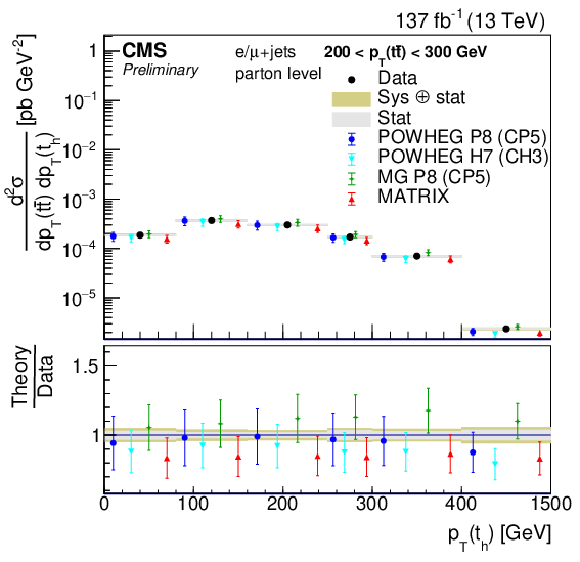
png pdf |
Figure 29-d:
Double differential cross section as function of pT(tˉt) vs pT(th). The data are shown as points with light (dark) bands indicating the statistical (statistical and systematic) uncertainties. The cross sections are compared to the predictions of POWHEG combined with PYTHIA (P8) or HERWIG (H7), the multiparton simulation MG5_aMC@NLO (MG5)+PYTHIA FxFx, and the NNLO QCD calculations obtained with Matrix. The ratios of the various predictions to the measured cross sections are shown at the bottom of each panel. |

png pdf |
Figure 29-e:
Double differential cross section as function of pT(tˉt) vs pT(th). The data are shown as points with light (dark) bands indicating the statistical (statistical and systematic) uncertainties. The cross sections are compared to the predictions of POWHEG combined with PYTHIA (P8) or HERWIG (H7), the multiparton simulation MG5_aMC@NLO (MG5)+PYTHIA FxFx, and the NNLO QCD calculations obtained with Matrix. The ratios of the various predictions to the measured cross sections are shown at the bottom of each panel. |
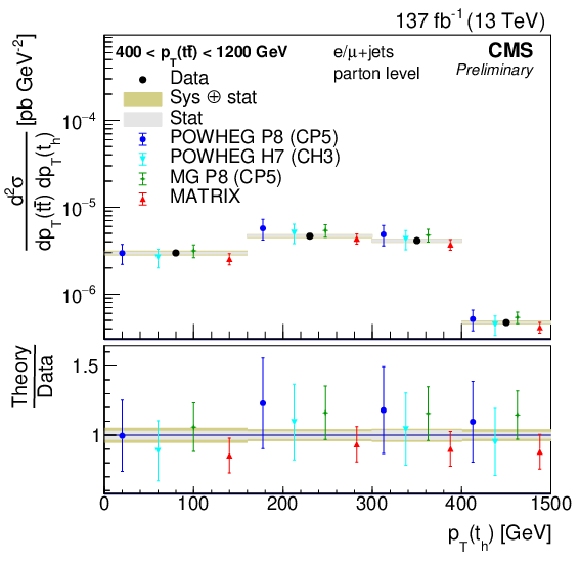
png pdf |
Figure 29-f:
Double differential cross section as function of pT(tˉt) vs pT(th). The data are shown as points with light (dark) bands indicating the statistical (statistical and systematic) uncertainties. The cross sections are compared to the predictions of POWHEG combined with PYTHIA (P8) or HERWIG (H7), the multiparton simulation MG5_aMC@NLO (MG5)+PYTHIA FxFx, and the NNLO QCD calculations obtained with Matrix. The ratios of the various predictions to the measured cross sections are shown at the bottom of each panel. |

png pdf |
Figure 30:
Double differential cross section as function of pT(tˉt) vs pT(th). The data are shown as points with light (dark) bands indicating the statistical (statistical and systematic) uncertainties. The cross sections are compared to the predictions of POWHEG +PYTHIA (P8) for the CP5 and CUETP8M2T4 (T4), POWHEG +HERWIG (H7), and the multiparton simulation MG5_aMC@NLO (MG)+PYTHIA. The ratios of the various predictions to the measured cross sections are shown at the bottom of each panel. |
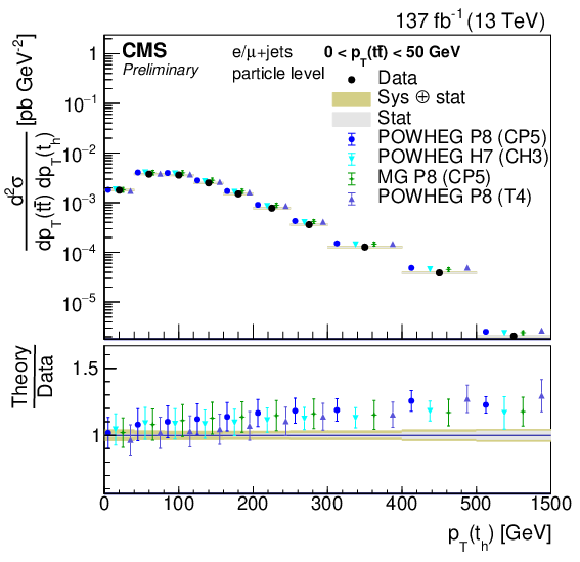
png pdf |
Figure 30-a:
Double differential cross section as function of pT(tˉt) vs pT(th). The data are shown as points with light (dark) bands indicating the statistical (statistical and systematic) uncertainties. The cross sections are compared to the predictions of POWHEG +PYTHIA (P8) for the CP5 and CUETP8M2T4 (T4), POWHEG +HERWIG (H7), and the multiparton simulation MG5_aMC@NLO (MG)+PYTHIA. The ratios of the various predictions to the measured cross sections are shown at the bottom of each panel. |
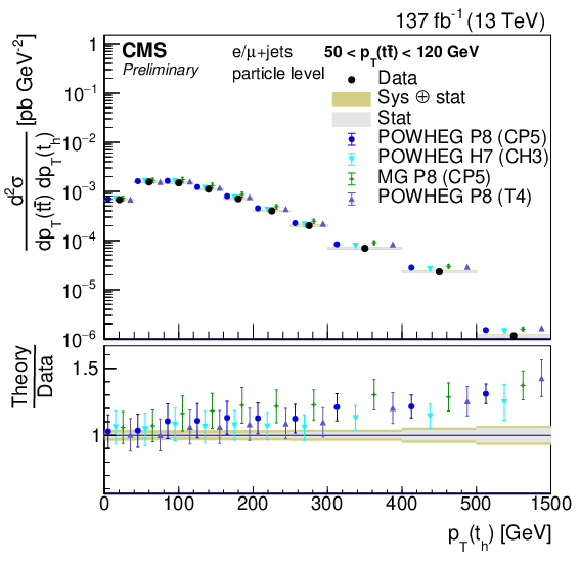
png pdf |
Figure 30-b:
Double differential cross section as function of pT(tˉt) vs pT(th). The data are shown as points with light (dark) bands indicating the statistical (statistical and systematic) uncertainties. The cross sections are compared to the predictions of POWHEG +PYTHIA (P8) for the CP5 and CUETP8M2T4 (T4), POWHEG +HERWIG (H7), and the multiparton simulation MG5_aMC@NLO (MG)+PYTHIA. The ratios of the various predictions to the measured cross sections are shown at the bottom of each panel. |

png pdf |
Figure 30-c:
Double differential cross section as function of pT(tˉt) vs pT(th). The data are shown as points with light (dark) bands indicating the statistical (statistical and systematic) uncertainties. The cross sections are compared to the predictions of POWHEG +PYTHIA (P8) for the CP5 and CUETP8M2T4 (T4), POWHEG +HERWIG (H7), and the multiparton simulation MG5_aMC@NLO (MG)+PYTHIA. The ratios of the various predictions to the measured cross sections are shown at the bottom of each panel. |

png pdf |
Figure 30-d:
Double differential cross section as function of pT(tˉt) vs pT(th). The data are shown as points with light (dark) bands indicating the statistical (statistical and systematic) uncertainties. The cross sections are compared to the predictions of POWHEG +PYTHIA (P8) for the CP5 and CUETP8M2T4 (T4), POWHEG +HERWIG (H7), and the multiparton simulation MG5_aMC@NLO (MG)+PYTHIA. The ratios of the various predictions to the measured cross sections are shown at the bottom of each panel. |

png pdf |
Figure 30-e:
Double differential cross section as function of pT(tˉt) vs pT(th). The data are shown as points with light (dark) bands indicating the statistical (statistical and systematic) uncertainties. The cross sections are compared to the predictions of POWHEG +PYTHIA (P8) for the CP5 and CUETP8M2T4 (T4), POWHEG +HERWIG (H7), and the multiparton simulation MG5_aMC@NLO (MG)+PYTHIA. The ratios of the various predictions to the measured cross sections are shown at the bottom of each panel. |

png pdf |
Figure 30-f:
Double differential cross section as function of pT(tˉt) vs pT(th). The data are shown as points with light (dark) bands indicating the statistical (statistical and systematic) uncertainties. The cross sections are compared to the predictions of POWHEG +PYTHIA (P8) for the CP5 and CUETP8M2T4 (T4), POWHEG +HERWIG (H7), and the multiparton simulation MG5_aMC@NLO (MG)+PYTHIA. The ratios of the various predictions to the measured cross sections are shown at the bottom of each panel. |
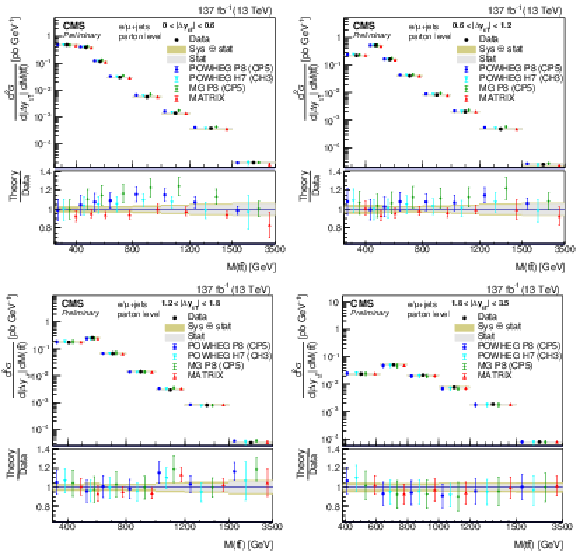
png pdf |
Figure 31:
Double differential cross section as function of |Δyt/ˉt| vs M(tˉt). The data are shown as points with light (dark) bands indicating the statistical (statistical and systematic) uncertainties. The cross sections are compared to the predictions of POWHEG combined with PYTHIA (P8) or HERWIG (H7), the multiparton simulation MG5_aMC@NLO (MG5)+PYTHIA FxFx, and the NNLO QCD calculations obtained with Matrix. The ratios of the various predictions to the measured cross sections are shown at the bottom of each panel. |

png pdf |
Figure 31-a:
Double differential cross section as function of |Δyt/ˉt| vs M(tˉt). The data are shown as points with light (dark) bands indicating the statistical (statistical and systematic) uncertainties. The cross sections are compared to the predictions of POWHEG combined with PYTHIA (P8) or HERWIG (H7), the multiparton simulation MG5_aMC@NLO (MG5)+PYTHIA FxFx, and the NNLO QCD calculations obtained with Matrix. The ratios of the various predictions to the measured cross sections are shown at the bottom of each panel. |

png pdf |
Figure 31-b:
Double differential cross section as function of |Δyt/ˉt| vs M(tˉt). The data are shown as points with light (dark) bands indicating the statistical (statistical and systematic) uncertainties. The cross sections are compared to the predictions of POWHEG combined with PYTHIA (P8) or HERWIG (H7), the multiparton simulation MG5_aMC@NLO (MG5)+PYTHIA FxFx, and the NNLO QCD calculations obtained with Matrix. The ratios of the various predictions to the measured cross sections are shown at the bottom of each panel. |

png pdf |
Figure 31-c:
Double differential cross section as function of |Δyt/ˉt| vs M(tˉt). The data are shown as points with light (dark) bands indicating the statistical (statistical and systematic) uncertainties. The cross sections are compared to the predictions of POWHEG combined with PYTHIA (P8) or HERWIG (H7), the multiparton simulation MG5_aMC@NLO (MG5)+PYTHIA FxFx, and the NNLO QCD calculations obtained with Matrix. The ratios of the various predictions to the measured cross sections are shown at the bottom of each panel. |

png pdf |
Figure 31-d:
Double differential cross section as function of |Δyt/ˉt| vs M(tˉt). The data are shown as points with light (dark) bands indicating the statistical (statistical and systematic) uncertainties. The cross sections are compared to the predictions of POWHEG combined with PYTHIA (P8) or HERWIG (H7), the multiparton simulation MG5_aMC@NLO (MG5)+PYTHIA FxFx, and the NNLO QCD calculations obtained with Matrix. The ratios of the various predictions to the measured cross sections are shown at the bottom of each panel. |

png pdf |
Figure 32:
Double differential cross section as function of |Δyt/ˉt| vs M(tˉt). The data are shown as points with light (dark) bands indicating the statistical (statistical and systematic) uncertainties. The cross sections are compared to the predictions of POWHEG +PYTHIA (P8) for the CP5 and CUETP8M2T4 (T4), POWHEG +HERWIG (H7), and the multiparton simulation MG5_aMC@NLO (MG)+PYTHIA. The ratios of the various predictions to the measured cross sections are shown at the bottom of each panel. |
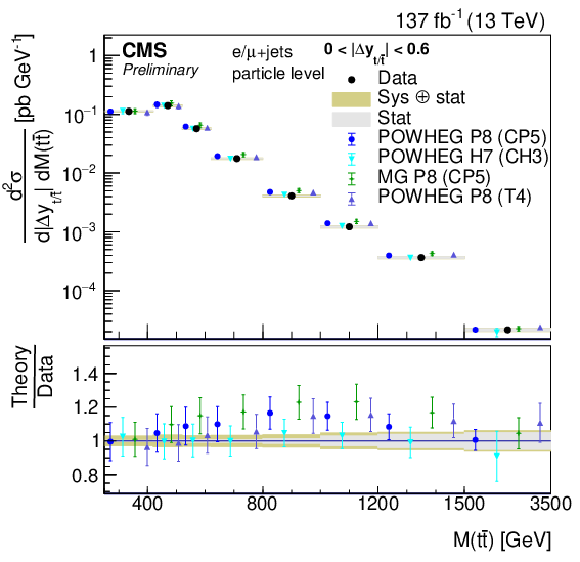
png pdf |
Figure 32-a:
Double differential cross section as function of |Δyt/ˉt| vs M(tˉt). The data are shown as points with light (dark) bands indicating the statistical (statistical and systematic) uncertainties. The cross sections are compared to the predictions of POWHEG +PYTHIA (P8) for the CP5 and CUETP8M2T4 (T4), POWHEG +HERWIG (H7), and the multiparton simulation MG5_aMC@NLO (MG)+PYTHIA. The ratios of the various predictions to the measured cross sections are shown at the bottom of each panel. |
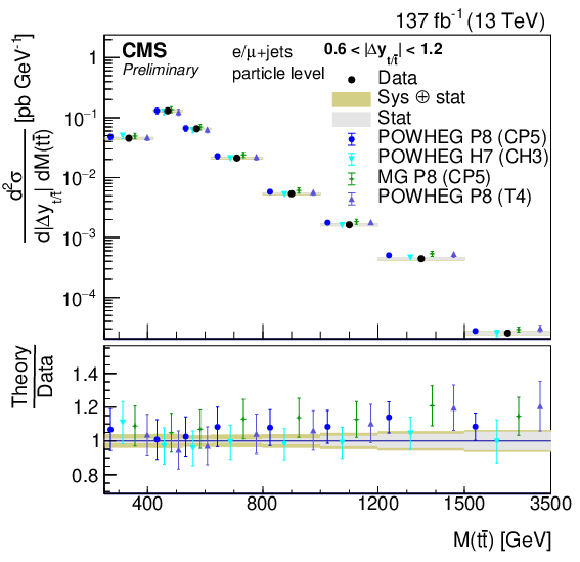
png pdf |
Figure 32-b:
Double differential cross section as function of |Δyt/ˉt| vs M(tˉt). The data are shown as points with light (dark) bands indicating the statistical (statistical and systematic) uncertainties. The cross sections are compared to the predictions of POWHEG +PYTHIA (P8) for the CP5 and CUETP8M2T4 (T4), POWHEG +HERWIG (H7), and the multiparton simulation MG5_aMC@NLO (MG)+PYTHIA. The ratios of the various predictions to the measured cross sections are shown at the bottom of each panel. |

png pdf |
Figure 32-c:
Double differential cross section as function of |Δyt/ˉt| vs M(tˉt). The data are shown as points with light (dark) bands indicating the statistical (statistical and systematic) uncertainties. The cross sections are compared to the predictions of POWHEG +PYTHIA (P8) for the CP5 and CUETP8M2T4 (T4), POWHEG +HERWIG (H7), and the multiparton simulation MG5_aMC@NLO (MG)+PYTHIA. The ratios of the various predictions to the measured cross sections are shown at the bottom of each panel. |

png pdf |
Figure 32-d:
Double differential cross section as function of |Δyt/ˉt| vs M(tˉt). The data are shown as points with light (dark) bands indicating the statistical (statistical and systematic) uncertainties. The cross sections are compared to the predictions of POWHEG +PYTHIA (P8) for the CP5 and CUETP8M2T4 (T4), POWHEG +HERWIG (H7), and the multiparton simulation MG5_aMC@NLO (MG)+PYTHIA. The ratios of the various predictions to the measured cross sections are shown at the bottom of each panel. |
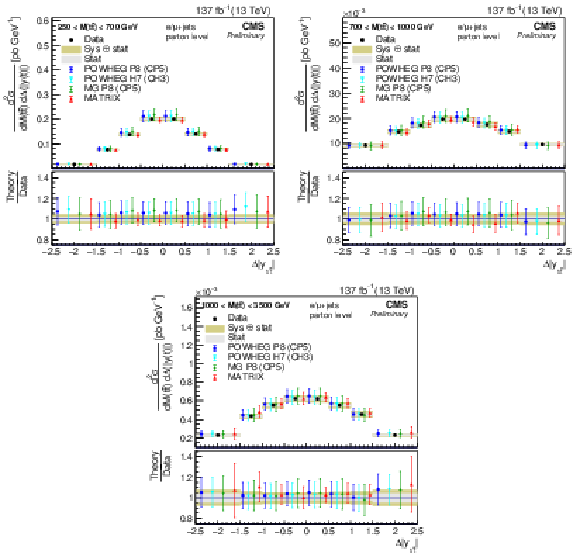
png pdf |
Figure 33:
Double differential cross section as function of M(tˉt) vs Δ|yt/ˉt|. The data are shown as points with light (dark) bands indicating the statistical (statistical and systematic) uncertainties. The cross sections are compared to the predictions of POWHEG combined with PYTHIA (P8) or HERWIG (H7), the multiparton simulation MG5_aMC@NLO (MG5)+PYTHIA FxFx, and the NNLO QCD calculations obtained with Matrix. The ratios of the various predictions to the measured cross sections are shown at the bottom of each panel. |

png pdf |
Figure 33-a:
Double differential cross section as function of M(tˉt) vs Δ|yt/ˉt|. The data are shown as points with light (dark) bands indicating the statistical (statistical and systematic) uncertainties. The cross sections are compared to the predictions of POWHEG combined with PYTHIA (P8) or HERWIG (H7), the multiparton simulation MG5_aMC@NLO (MG5)+PYTHIA FxFx, and the NNLO QCD calculations obtained with Matrix. The ratios of the various predictions to the measured cross sections are shown at the bottom of each panel. |

png pdf |
Figure 33-b:
Double differential cross section as function of M(tˉt) vs Δ|yt/ˉt|. The data are shown as points with light (dark) bands indicating the statistical (statistical and systematic) uncertainties. The cross sections are compared to the predictions of POWHEG combined with PYTHIA (P8) or HERWIG (H7), the multiparton simulation MG5_aMC@NLO (MG5)+PYTHIA FxFx, and the NNLO QCD calculations obtained with Matrix. The ratios of the various predictions to the measured cross sections are shown at the bottom of each panel. |
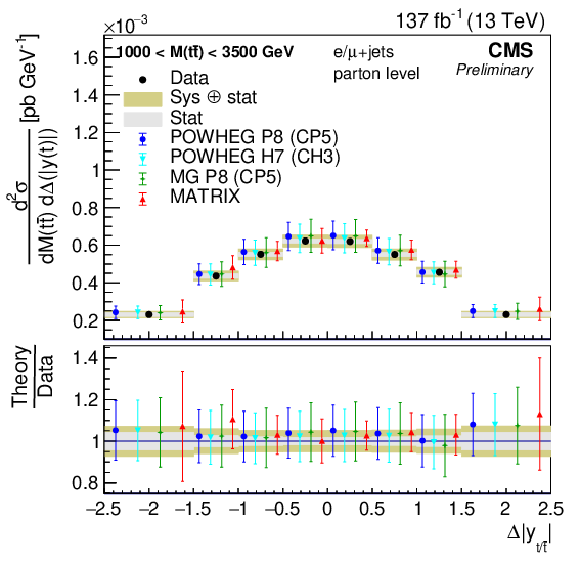
png pdf |
Figure 33-c:
Double differential cross section as function of M(tˉt) vs Δ|yt/ˉt|. The data are shown as points with light (dark) bands indicating the statistical (statistical and systematic) uncertainties. The cross sections are compared to the predictions of POWHEG combined with PYTHIA (P8) or HERWIG (H7), the multiparton simulation MG5_aMC@NLO (MG5)+PYTHIA FxFx, and the NNLO QCD calculations obtained with Matrix. The ratios of the various predictions to the measured cross sections are shown at the bottom of each panel. |

png pdf |
Figure 34:
Double differential cross section as function of M(tˉt) vs Δ|yt/ˉt|. The data are shown as points with light (dark) bands indicating the statistical (statistical and systematic) uncertainties. The cross sections are compared to the predictions of POWHEG +PYTHIA (P8) for the CP5 and CUETP8M2T4 (T4), POWHEG +HERWIG (H7), and the multiparton simulation MG5_aMC@NLO (MG)+PYTHIA. The ratios of the various predictions to the measured cross sections are shown at the bottom of each panel. |

png pdf |
Figure 34-a:
Double differential cross section as function of M(tˉt) vs Δ|yt/ˉt|. The data are shown as points with light (dark) bands indicating the statistical (statistical and systematic) uncertainties. The cross sections are compared to the predictions of POWHEG +PYTHIA (P8) for the CP5 and CUETP8M2T4 (T4), POWHEG +HERWIG (H7), and the multiparton simulation MG5_aMC@NLO (MG)+PYTHIA. The ratios of the various predictions to the measured cross sections are shown at the bottom of each panel. |
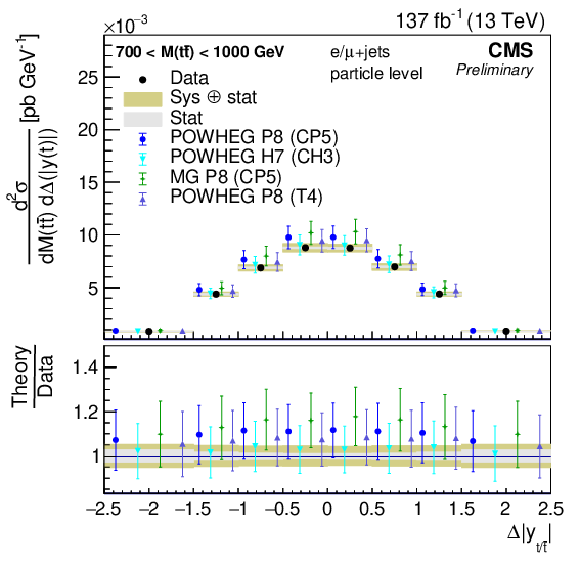
png pdf |
Figure 34-b:
Double differential cross section as function of M(tˉt) vs Δ|yt/ˉt|. The data are shown as points with light (dark) bands indicating the statistical (statistical and systematic) uncertainties. The cross sections are compared to the predictions of POWHEG +PYTHIA (P8) for the CP5 and CUETP8M2T4 (T4), POWHEG +HERWIG (H7), and the multiparton simulation MG5_aMC@NLO (MG)+PYTHIA. The ratios of the various predictions to the measured cross sections are shown at the bottom of each panel. |

png pdf |
Figure 34-c:
Double differential cross section as function of M(tˉt) vs Δ|yt/ˉt|. The data are shown as points with light (dark) bands indicating the statistical (statistical and systematic) uncertainties. The cross sections are compared to the predictions of POWHEG +PYTHIA (P8) for the CP5 and CUETP8M2T4 (T4), POWHEG +HERWIG (H7), and the multiparton simulation MG5_aMC@NLO (MG)+PYTHIA. The ratios of the various predictions to the measured cross sections are shown at the bottom of each panel. |

png pdf |
Figure 35:
Double differential cross section as function of |y(t)| vs |y(ˉt)|. The data are shown as points with light (dark) bands indicating the statistical (statistical and systematic) uncertainties. The cross sections are compared to the predictions of POWHEG combined with PYTHIA (P8) or HERWIG (H7), the multiparton simulation MG5_aMC@NLO (MG5)+PYTHIA FxFx, and the NNLO QCD calculations obtained with Matrix. The ratios of the various predictions to the measured cross sections are shown at the bottom of each panel. Bottom right: ratio of |y(ˉt)|/|y(t)|. |
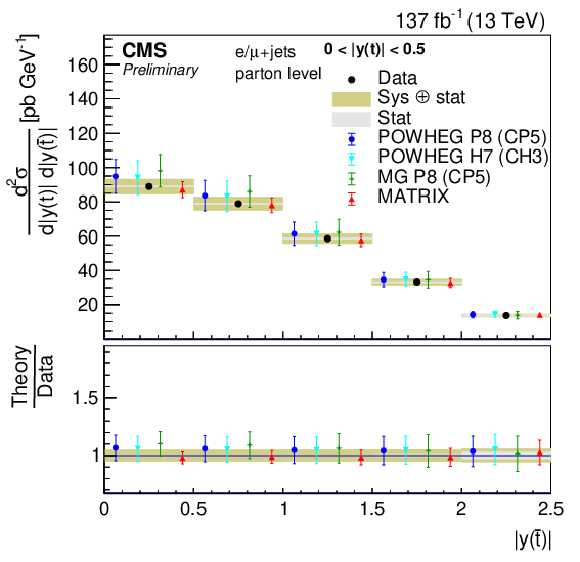
png pdf |
Figure 35-a:
Double differential cross section as function of |y(t)| vs |y(ˉt)|. The data are shown as points with light (dark) bands indicating the statistical (statistical and systematic) uncertainties. The cross sections are compared to the predictions of POWHEG combined with PYTHIA (P8) or HERWIG (H7), the multiparton simulation MG5_aMC@NLO (MG5)+PYTHIA FxFx, and the NNLO QCD calculations obtained with Matrix. The ratios of the various predictions to the measured cross sections are shown at the bottom of each panel. Bottom right: ratio of |y(ˉt)|/|y(t)|. |

png pdf |
Figure 35-b:
Double differential cross section as function of |y(t)| vs |y(ˉt)|. The data are shown as points with light (dark) bands indicating the statistical (statistical and systematic) uncertainties. The cross sections are compared to the predictions of POWHEG combined with PYTHIA (P8) or HERWIG (H7), the multiparton simulation MG5_aMC@NLO (MG5)+PYTHIA FxFx, and the NNLO QCD calculations obtained with Matrix. The ratios of the various predictions to the measured cross sections are shown at the bottom of each panel. Bottom right: ratio of |y(ˉt)|/|y(t)|. |

png pdf |
Figure 35-c:
Double differential cross section as function of |y(t)| vs |y(ˉt)|. The data are shown as points with light (dark) bands indicating the statistical (statistical and systematic) uncertainties. The cross sections are compared to the predictions of POWHEG combined with PYTHIA (P8) or HERWIG (H7), the multiparton simulation MG5_aMC@NLO (MG5)+PYTHIA FxFx, and the NNLO QCD calculations obtained with Matrix. The ratios of the various predictions to the measured cross sections are shown at the bottom of each panel. Bottom right: ratio of |y(ˉt)|/|y(t)|. |
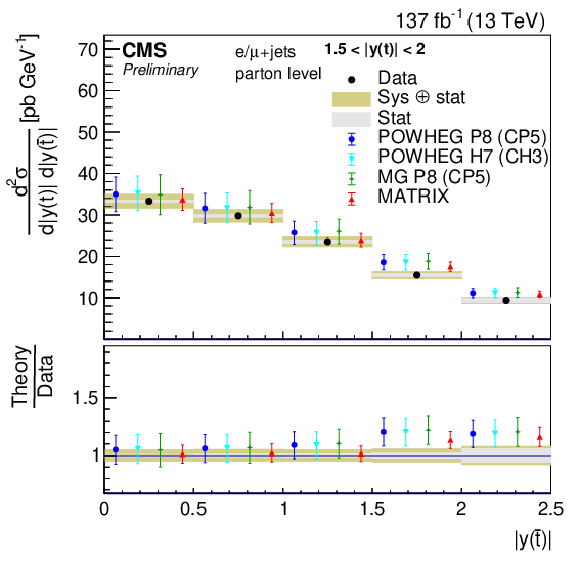
png pdf |
Figure 35-d:
Double differential cross section as function of |y(t)| vs |y(ˉt)|. The data are shown as points with light (dark) bands indicating the statistical (statistical and systematic) uncertainties. The cross sections are compared to the predictions of POWHEG combined with PYTHIA (P8) or HERWIG (H7), the multiparton simulation MG5_aMC@NLO (MG5)+PYTHIA FxFx, and the NNLO QCD calculations obtained with Matrix. The ratios of the various predictions to the measured cross sections are shown at the bottom of each panel. Bottom right: ratio of |y(ˉt)|/|y(t)|. |
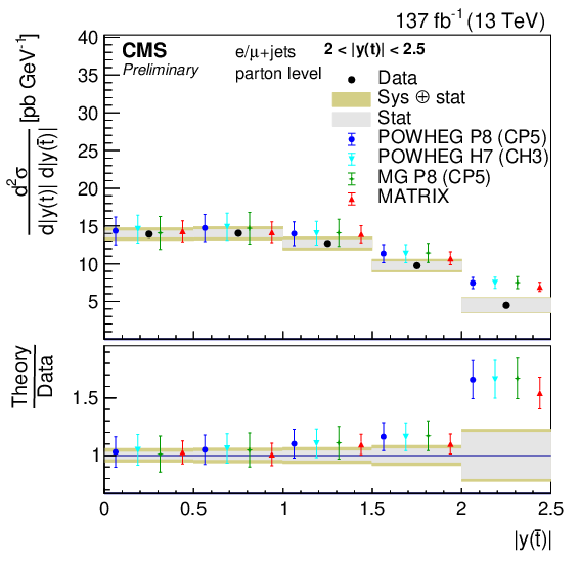
png pdf |
Figure 35-e:
Double differential cross section as function of |y(t)| vs |y(ˉt)|. The data are shown as points with light (dark) bands indicating the statistical (statistical and systematic) uncertainties. The cross sections are compared to the predictions of POWHEG combined with PYTHIA (P8) or HERWIG (H7), the multiparton simulation MG5_aMC@NLO (MG5)+PYTHIA FxFx, and the NNLO QCD calculations obtained with Matrix. The ratios of the various predictions to the measured cross sections are shown at the bottom of each panel. Bottom right: ratio of |y(ˉt)|/|y(t)|. |
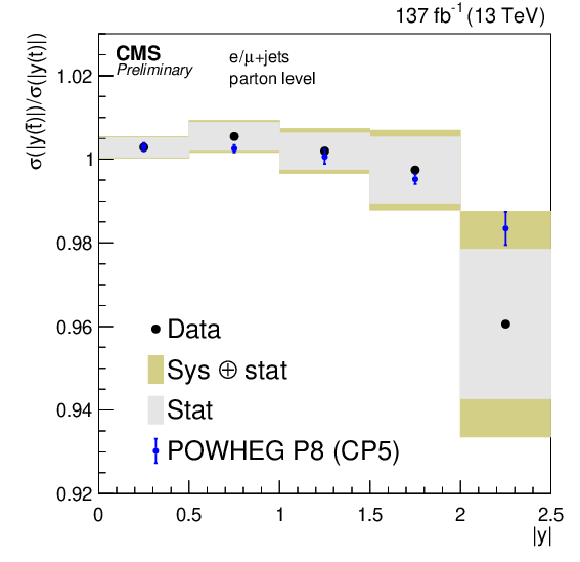
png pdf |
Figure 35-f:
Double differential cross section as function of |y(t)| vs |y(ˉt)|. The data are shown as points with light (dark) bands indicating the statistical (statistical and systematic) uncertainties. The cross sections are compared to the predictions of POWHEG combined with PYTHIA (P8) or HERWIG (H7), the multiparton simulation MG5_aMC@NLO (MG5)+PYTHIA FxFx, and the NNLO QCD calculations obtained with Matrix. The ratios of the various predictions to the measured cross sections are shown at the bottom of each panel. Bottom right: ratio of |y(ˉt)|/|y(t)|. |

png pdf |
Figure 36:
Double differential cross section as function of |y(t)| vs |y(ˉt)|. The data are shown as points with light (dark) bands indicating the statistical (statistical and systematic) uncertainties. The cross sections are compared to the predictions of POWHEG +PYTHIA (P8) for the CP5 and CUETP8M2T4 (T4), POWHEG +HERWIG (H7), and the multiparton simulation MG5_aMC@NLO (MG)+PYTHIA. The ratios of the various predictions to the measured cross sections are shown at the bottom of each panel. Bottom right: ratio of |y(ˉt)|/|y(t)| |
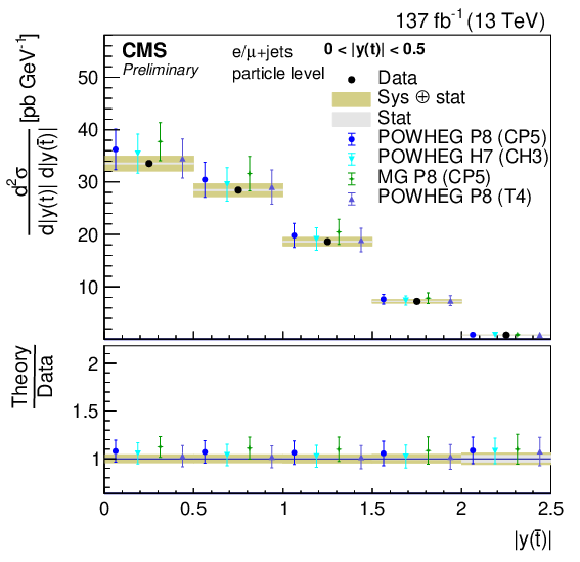
png pdf |
Figure 36-a:
Double differential cross section as function of |y(t)| vs |y(ˉt)|. The data are shown as points with light (dark) bands indicating the statistical (statistical and systematic) uncertainties. The cross sections are compared to the predictions of POWHEG +PYTHIA (P8) for the CP5 and CUETP8M2T4 (T4), POWHEG +HERWIG (H7), and the multiparton simulation MG5_aMC@NLO (MG)+PYTHIA. The ratios of the various predictions to the measured cross sections are shown at the bottom of each panel. Bottom right: ratio of |y(ˉt)|/|y(t)| |
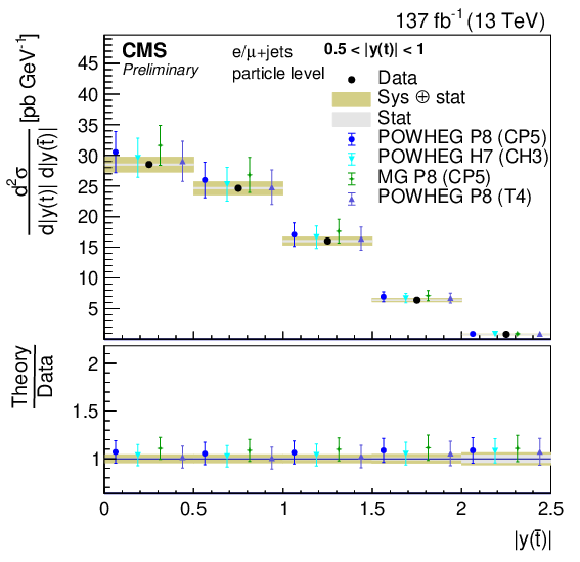
png pdf |
Figure 36-b:
Double differential cross section as function of |y(t)| vs |y(ˉt)|. The data are shown as points with light (dark) bands indicating the statistical (statistical and systematic) uncertainties. The cross sections are compared to the predictions of POWHEG +PYTHIA (P8) for the CP5 and CUETP8M2T4 (T4), POWHEG +HERWIG (H7), and the multiparton simulation MG5_aMC@NLO (MG)+PYTHIA. The ratios of the various predictions to the measured cross sections are shown at the bottom of each panel. Bottom right: ratio of |y(ˉt)|/|y(t)| |

png pdf |
Figure 36-c:
Double differential cross section as function of |y(t)| vs |y(ˉt)|. The data are shown as points with light (dark) bands indicating the statistical (statistical and systematic) uncertainties. The cross sections are compared to the predictions of POWHEG +PYTHIA (P8) for the CP5 and CUETP8M2T4 (T4), POWHEG +HERWIG (H7), and the multiparton simulation MG5_aMC@NLO (MG)+PYTHIA. The ratios of the various predictions to the measured cross sections are shown at the bottom of each panel. Bottom right: ratio of |y(ˉt)|/|y(t)| |
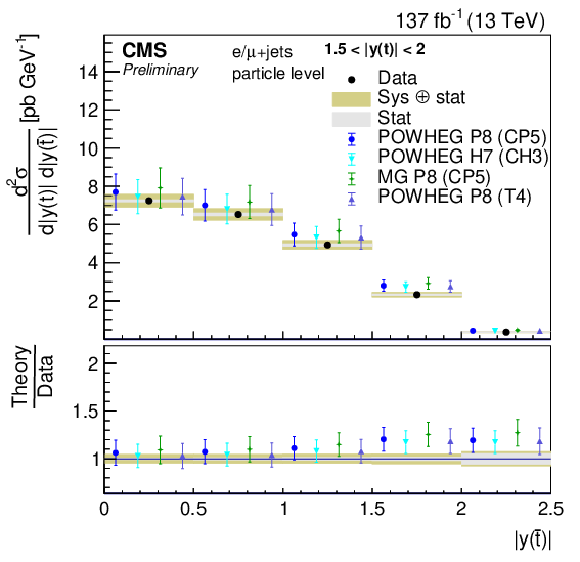
png pdf |
Figure 36-d:
Double differential cross section as function of |y(t)| vs |y(ˉt)|. The data are shown as points with light (dark) bands indicating the statistical (statistical and systematic) uncertainties. The cross sections are compared to the predictions of POWHEG +PYTHIA (P8) for the CP5 and CUETP8M2T4 (T4), POWHEG +HERWIG (H7), and the multiparton simulation MG5_aMC@NLO (MG)+PYTHIA. The ratios of the various predictions to the measured cross sections are shown at the bottom of each panel. Bottom right: ratio of |y(ˉt)|/|y(t)| |

png pdf |
Figure 36-e:
Double differential cross section as function of |y(t)| vs |y(ˉt)|. The data are shown as points with light (dark) bands indicating the statistical (statistical and systematic) uncertainties. The cross sections are compared to the predictions of POWHEG +PYTHIA (P8) for the CP5 and CUETP8M2T4 (T4), POWHEG +HERWIG (H7), and the multiparton simulation MG5_aMC@NLO (MG)+PYTHIA. The ratios of the various predictions to the measured cross sections are shown at the bottom of each panel. Bottom right: ratio of |y(ˉt)|/|y(t)| |

png pdf |
Figure 36-f:
Double differential cross section as function of |y(t)| vs |y(ˉt)|. The data are shown as points with light (dark) bands indicating the statistical (statistical and systematic) uncertainties. The cross sections are compared to the predictions of POWHEG +PYTHIA (P8) for the CP5 and CUETP8M2T4 (T4), POWHEG +HERWIG (H7), and the multiparton simulation MG5_aMC@NLO (MG)+PYTHIA. The ratios of the various predictions to the measured cross sections are shown at the bottom of each panel. Bottom right: ratio of |y(ˉt)|/|y(t)| |

png pdf |
Figure 37:
The tˉt production cross sections obtained as the sum of the cross sections in all bins of a distribution. The results are compared to the Top++2.0 and the Matrix prediction with their corresponding uncertainties. |

png pdf |
Figure 38:
The tˉt production cross sections σparticle obtained as the sum of the cross sections in all bins of a distribution. The results are compared to the POWHEG +PYTHIA predictions. |
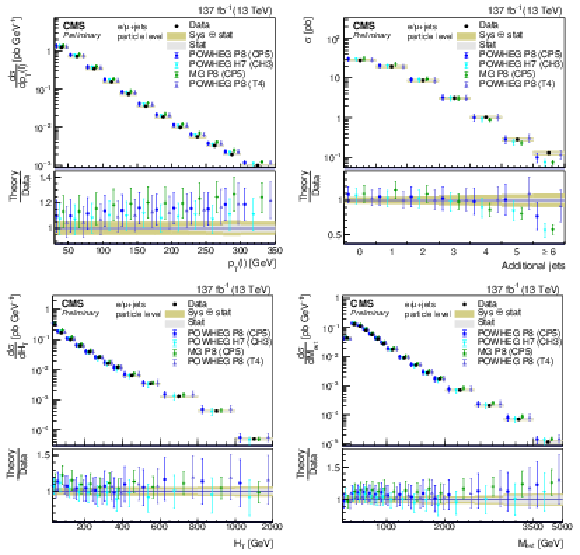
png pdf |
Figure 39:
Differential cross sections as functions of pT(ℓ), jet multiplicity, HT, and Mevt. The data are shown as points with light (dark) bands indicating the statistical (statistical and systematic) uncertainties. The cross sections are compared to the predictions of POWHEG +PYTHIA (P8) for the CP5 and CUETP8M2T4 (T4), POWHEG +HERWIG (H7), and the multiparton simulation MG5_aMC@NLO (MG)+PYTHIA. The ratios of the various predictions to the measured cross sections are shown at the bottom of each panel. |

png pdf |
Figure 39-a:
Differential cross sections as functions of pT(ℓ), jet multiplicity, HT, and Mevt. The data are shown as points with light (dark) bands indicating the statistical (statistical and systematic) uncertainties. The cross sections are compared to the predictions of POWHEG +PYTHIA (P8) for the CP5 and CUETP8M2T4 (T4), POWHEG +HERWIG (H7), and the multiparton simulation MG5_aMC@NLO (MG)+PYTHIA. The ratios of the various predictions to the measured cross sections are shown at the bottom of each panel. |

png pdf |
Figure 39-b:
Differential cross sections as functions of pT(ℓ), jet multiplicity, HT, and Mevt. The data are shown as points with light (dark) bands indicating the statistical (statistical and systematic) uncertainties. The cross sections are compared to the predictions of POWHEG +PYTHIA (P8) for the CP5 and CUETP8M2T4 (T4), POWHEG +HERWIG (H7), and the multiparton simulation MG5_aMC@NLO (MG)+PYTHIA. The ratios of the various predictions to the measured cross sections are shown at the bottom of each panel. |
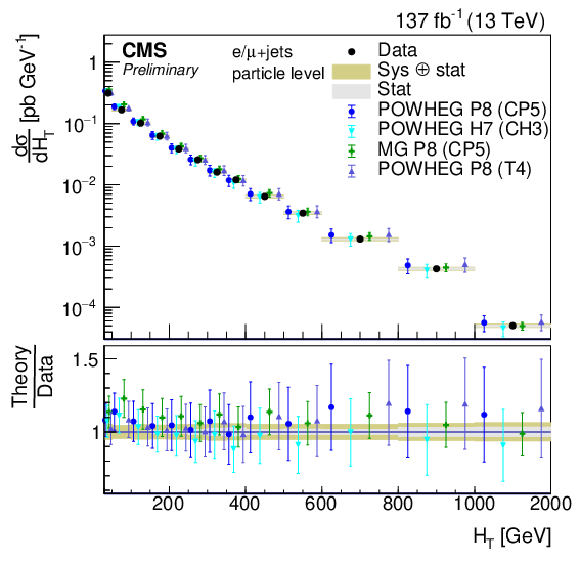
png pdf |
Figure 39-c:
Differential cross sections as functions of pT(ℓ), jet multiplicity, HT, and Mevt. The data are shown as points with light (dark) bands indicating the statistical (statistical and systematic) uncertainties. The cross sections are compared to the predictions of POWHEG +PYTHIA (P8) for the CP5 and CUETP8M2T4 (T4), POWHEG +HERWIG (H7), and the multiparton simulation MG5_aMC@NLO (MG)+PYTHIA. The ratios of the various predictions to the measured cross sections are shown at the bottom of each panel. |

png pdf |
Figure 39-d:
Differential cross sections as functions of pT(ℓ), jet multiplicity, HT, and Mevt. The data are shown as points with light (dark) bands indicating the statistical (statistical and systematic) uncertainties. The cross sections are compared to the predictions of POWHEG +PYTHIA (P8) for the CP5 and CUETP8M2T4 (T4), POWHEG +HERWIG (H7), and the multiparton simulation MG5_aMC@NLO (MG)+PYTHIA. The ratios of the various predictions to the measured cross sections are shown at the bottom of each panel. |

png pdf |
Figure 40:
Differential cross section as function of pT(th) in bins of jet multiplicity. The data are shown as points with light (dark) bands indicating the statistical (statistical and systematic) uncertainties. The cross sections are compared to the predictions of POWHEG +PYTHIA (P8) for the CP5 and CUETP8M2T4 (T4), POWHEG +HERWIG (H7), and the multiparton simulation MG5_aMC@NLO (MG)+PYTHIA. The ratios of the various predictions to the measured cross sections are shown at the bottom of each panel. |

png pdf |
Figure 40-a:
Differential cross section as function of pT(th) in bins of jet multiplicity. The data are shown as points with light (dark) bands indicating the statistical (statistical and systematic) uncertainties. The cross sections are compared to the predictions of POWHEG +PYTHIA (P8) for the CP5 and CUETP8M2T4 (T4), POWHEG +HERWIG (H7), and the multiparton simulation MG5_aMC@NLO (MG)+PYTHIA. The ratios of the various predictions to the measured cross sections are shown at the bottom of each panel. |

png pdf |
Figure 40-b:
Differential cross section as function of pT(th) in bins of jet multiplicity. The data are shown as points with light (dark) bands indicating the statistical (statistical and systematic) uncertainties. The cross sections are compared to the predictions of POWHEG +PYTHIA (P8) for the CP5 and CUETP8M2T4 (T4), POWHEG +HERWIG (H7), and the multiparton simulation MG5_aMC@NLO (MG)+PYTHIA. The ratios of the various predictions to the measured cross sections are shown at the bottom of each panel. |
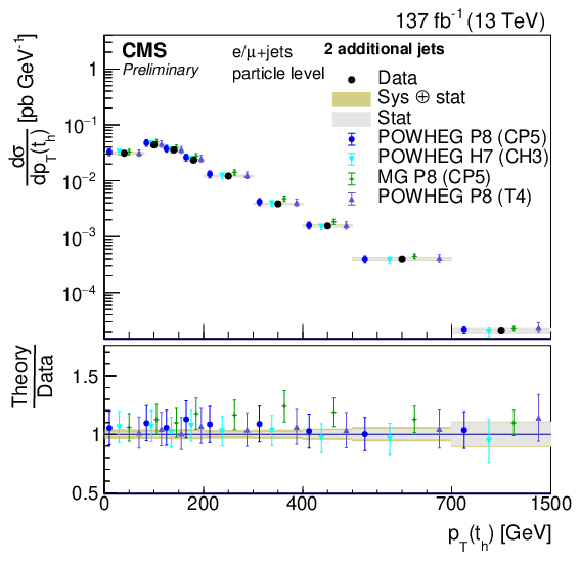
png pdf |
Figure 40-c:
Differential cross section as function of pT(th) in bins of jet multiplicity. The data are shown as points with light (dark) bands indicating the statistical (statistical and systematic) uncertainties. The cross sections are compared to the predictions of POWHEG +PYTHIA (P8) for the CP5 and CUETP8M2T4 (T4), POWHEG +HERWIG (H7), and the multiparton simulation MG5_aMC@NLO (MG)+PYTHIA. The ratios of the various predictions to the measured cross sections are shown at the bottom of each panel. |

png pdf |
Figure 40-d:
Differential cross section as function of pT(th) in bins of jet multiplicity. The data are shown as points with light (dark) bands indicating the statistical (statistical and systematic) uncertainties. The cross sections are compared to the predictions of POWHEG +PYTHIA (P8) for the CP5 and CUETP8M2T4 (T4), POWHEG +HERWIG (H7), and the multiparton simulation MG5_aMC@NLO (MG)+PYTHIA. The ratios of the various predictions to the measured cross sections are shown at the bottom of each panel. |

png pdf |
Figure 41:
Differential cross section as function of M(tˉt) in bins of jet multiplicity. The data are shown as points with light (dark) bands indicating the statistical (statistical and systematic) uncertainties. The cross sections are compared to the predictions of POWHEG +PYTHIA (P8) for the CP5 and CUETP8M2T4 (T4), POWHEG +HERWIG (H7), and the multiparton simulation MG5_aMC@NLO (MG)+PYTHIA. The ratios of the various predictions to the measured cross sections are shown at the bottom of each panel. |
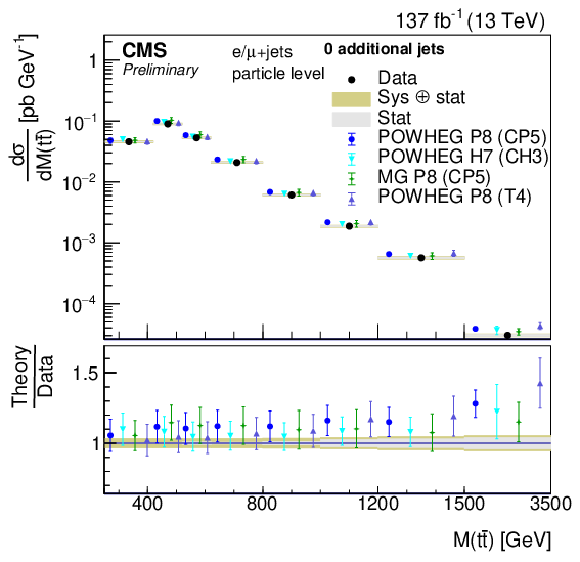
png pdf |
Figure 41-a:
Differential cross section as function of M(tˉt) in bins of jet multiplicity. The data are shown as points with light (dark) bands indicating the statistical (statistical and systematic) uncertainties. The cross sections are compared to the predictions of POWHEG +PYTHIA (P8) for the CP5 and CUETP8M2T4 (T4), POWHEG +HERWIG (H7), and the multiparton simulation MG5_aMC@NLO (MG)+PYTHIA. The ratios of the various predictions to the measured cross sections are shown at the bottom of each panel. |

png pdf |
Figure 41-b:
Differential cross section as function of M(tˉt) in bins of jet multiplicity. The data are shown as points with light (dark) bands indicating the statistical (statistical and systematic) uncertainties. The cross sections are compared to the predictions of POWHEG +PYTHIA (P8) for the CP5 and CUETP8M2T4 (T4), POWHEG +HERWIG (H7), and the multiparton simulation MG5_aMC@NLO (MG)+PYTHIA. The ratios of the various predictions to the measured cross sections are shown at the bottom of each panel. |
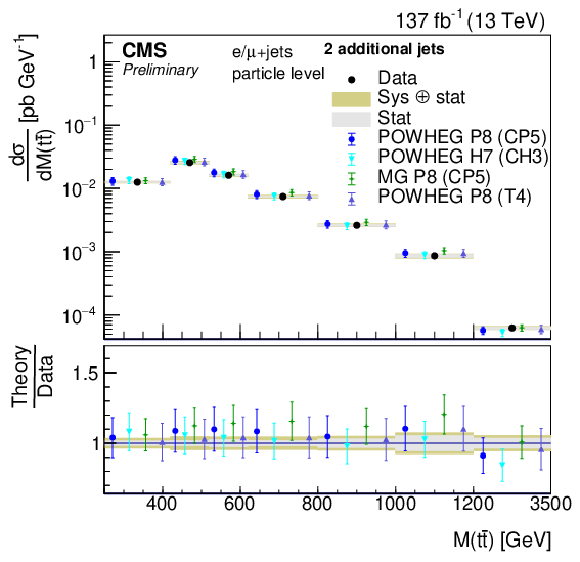
png pdf |
Figure 41-c:
Differential cross section as function of M(tˉt) in bins of jet multiplicity. The data are shown as points with light (dark) bands indicating the statistical (statistical and systematic) uncertainties. The cross sections are compared to the predictions of POWHEG +PYTHIA (P8) for the CP5 and CUETP8M2T4 (T4), POWHEG +HERWIG (H7), and the multiparton simulation MG5_aMC@NLO (MG)+PYTHIA. The ratios of the various predictions to the measured cross sections are shown at the bottom of each panel. |
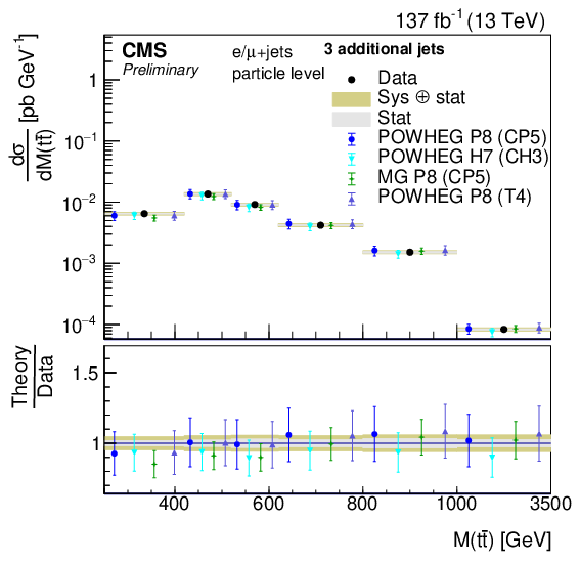
png pdf |
Figure 41-d:
Differential cross section as function of M(tˉt) in bins of jet multiplicity. The data are shown as points with light (dark) bands indicating the statistical (statistical and systematic) uncertainties. The cross sections are compared to the predictions of POWHEG +PYTHIA (P8) for the CP5 and CUETP8M2T4 (T4), POWHEG +HERWIG (H7), and the multiparton simulation MG5_aMC@NLO (MG)+PYTHIA. The ratios of the various predictions to the measured cross sections are shown at the bottom of each panel. |
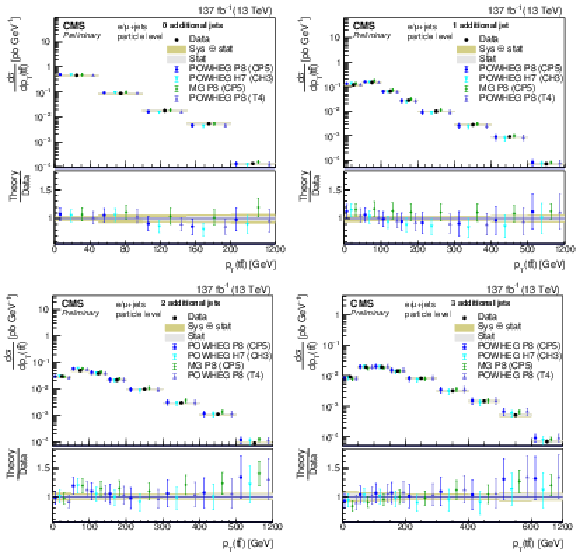
png pdf |
Figure 42:
Differential cross section as function of pT(tˉt) in bins of jet multiplicity. The data are shown as points with light (dark) bands indicating the statistical (statistical and systematic) uncertainties. The cross sections are compared to the predictions of POWHEG +PYTHIA (P8) for the CP5 and CUETP8M2T4 (T4), POWHEG +HERWIG (H7), and the multiparton simulation MG5_aMC@NLO (MG)+PYTHIA. The ratios of the various predictions to the measured cross sections are shown at the bottom of each panel. |

png pdf |
Figure 42-a:
Differential cross section as function of pT(tˉt) in bins of jet multiplicity. The data are shown as points with light (dark) bands indicating the statistical (statistical and systematic) uncertainties. The cross sections are compared to the predictions of POWHEG +PYTHIA (P8) for the CP5 and CUETP8M2T4 (T4), POWHEG +HERWIG (H7), and the multiparton simulation MG5_aMC@NLO (MG)+PYTHIA. The ratios of the various predictions to the measured cross sections are shown at the bottom of each panel. |

png pdf |
Figure 42-b:
Differential cross section as function of pT(tˉt) in bins of jet multiplicity. The data are shown as points with light (dark) bands indicating the statistical (statistical and systematic) uncertainties. The cross sections are compared to the predictions of POWHEG +PYTHIA (P8) for the CP5 and CUETP8M2T4 (T4), POWHEG +HERWIG (H7), and the multiparton simulation MG5_aMC@NLO (MG)+PYTHIA. The ratios of the various predictions to the measured cross sections are shown at the bottom of each panel. |

png pdf |
Figure 42-c:
Differential cross section as function of pT(tˉt) in bins of jet multiplicity. The data are shown as points with light (dark) bands indicating the statistical (statistical and systematic) uncertainties. The cross sections are compared to the predictions of POWHEG +PYTHIA (P8) for the CP5 and CUETP8M2T4 (T4), POWHEG +HERWIG (H7), and the multiparton simulation MG5_aMC@NLO (MG)+PYTHIA. The ratios of the various predictions to the measured cross sections are shown at the bottom of each panel. |

png pdf |
Figure 42-d:
Differential cross section as function of pT(tˉt) in bins of jet multiplicity. The data are shown as points with light (dark) bands indicating the statistical (statistical and systematic) uncertainties. The cross sections are compared to the predictions of POWHEG +PYTHIA (P8) for the CP5 and CUETP8M2T4 (T4), POWHEG +HERWIG (H7), and the multiparton simulation MG5_aMC@NLO (MG)+PYTHIA. The ratios of the various predictions to the measured cross sections are shown at the bottom of each panel. |

png pdf |
Figure 43:
Normalized differential cross section as functions of pT(th), pT(tℓ), pT(thigh), pT(tlow), and ST. The data are shown as points with light (dark) bands indicating the statistical (statistical and systematic) uncertainties. The cross sections are compared to the predictions of POWHEG combined with PYTHIA (P8) or HERWIG (H7), the multiparton simulation MG5_aMC@NLO (MG5)+PYTHIA FxFx, and the NNLO QCD calculations obtained with Matrix. The ratios of the various predictions to the measured cross sections are shown at the bottom of each panel. |

png pdf |
Figure 43-a:
Normalized differential cross section as functions of pT(th), pT(tℓ), pT(thigh), pT(tlow), and ST. The data are shown as points with light (dark) bands indicating the statistical (statistical and systematic) uncertainties. The cross sections are compared to the predictions of POWHEG combined with PYTHIA (P8) or HERWIG (H7), the multiparton simulation MG5_aMC@NLO (MG5)+PYTHIA FxFx, and the NNLO QCD calculations obtained with Matrix. The ratios of the various predictions to the measured cross sections are shown at the bottom of each panel. |

png pdf |
Figure 43-b:
Normalized differential cross section as functions of pT(th), pT(tℓ), pT(thigh), pT(tlow), and ST. The data are shown as points with light (dark) bands indicating the statistical (statistical and systematic) uncertainties. The cross sections are compared to the predictions of POWHEG combined with PYTHIA (P8) or HERWIG (H7), the multiparton simulation MG5_aMC@NLO (MG5)+PYTHIA FxFx, and the NNLO QCD calculations obtained with Matrix. The ratios of the various predictions to the measured cross sections are shown at the bottom of each panel. |
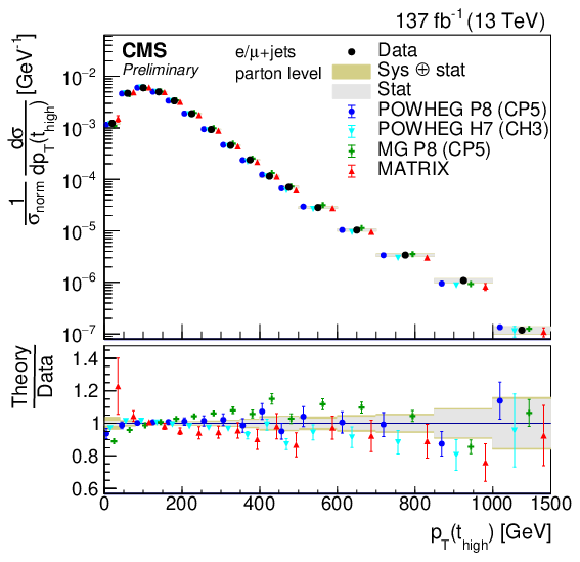
png pdf |
Figure 43-c:
Normalized differential cross section as functions of pT(th), pT(tℓ), pT(thigh), pT(tlow), and ST. The data are shown as points with light (dark) bands indicating the statistical (statistical and systematic) uncertainties. The cross sections are compared to the predictions of POWHEG combined with PYTHIA (P8) or HERWIG (H7), the multiparton simulation MG5_aMC@NLO (MG5)+PYTHIA FxFx, and the NNLO QCD calculations obtained with Matrix. The ratios of the various predictions to the measured cross sections are shown at the bottom of each panel. |

png pdf |
Figure 43-d:
Normalized differential cross section as functions of pT(th), pT(tℓ), pT(thigh), pT(tlow), and ST. The data are shown as points with light (dark) bands indicating the statistical (statistical and systematic) uncertainties. The cross sections are compared to the predictions of POWHEG combined with PYTHIA (P8) or HERWIG (H7), the multiparton simulation MG5_aMC@NLO (MG5)+PYTHIA FxFx, and the NNLO QCD calculations obtained with Matrix. The ratios of the various predictions to the measured cross sections are shown at the bottom of each panel. |

png pdf |
Figure 43-e:
Normalized differential cross section as functions of pT(th), pT(tℓ), pT(thigh), pT(tlow), and ST. The data are shown as points with light (dark) bands indicating the statistical (statistical and systematic) uncertainties. The cross sections are compared to the predictions of POWHEG combined with PYTHIA (P8) or HERWIG (H7), the multiparton simulation MG5_aMC@NLO (MG5)+PYTHIA FxFx, and the NNLO QCD calculations obtained with Matrix. The ratios of the various predictions to the measured cross sections are shown at the bottom of each panel. |
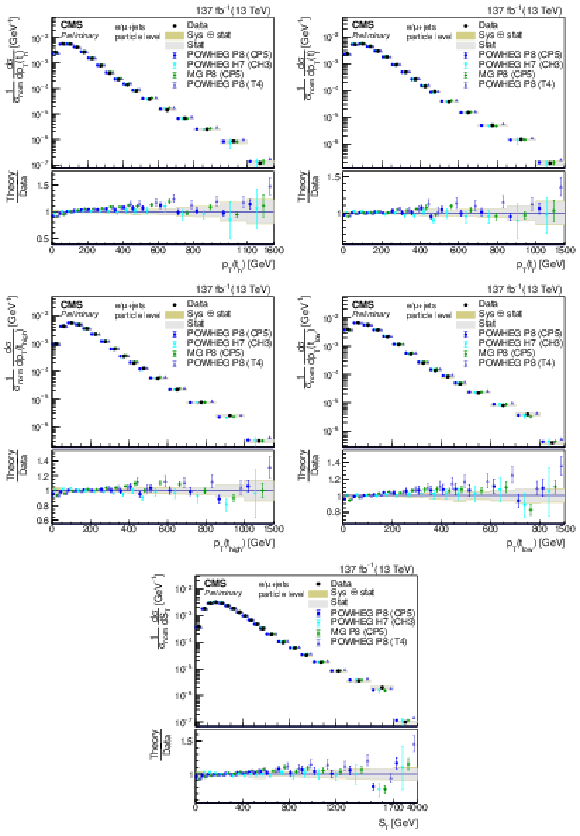
png pdf |
Figure 44:
Normalized differential cross section as functions of pT(th), pT(tℓ), pT(thigh), pT(tlow), and ST. The data are shown as points with light (dark) bands indicating the statistical (statistical and systematic) uncertainties. The cross sections are compared to the predictions of POWHEG +PYTHIA (P8) for the CP5 and CUETP8M2T4 (T4), POWHEG +HERWIG (H7), and the multiparton simulation MG5_aMC@NLO (MG)+PYTHIA. The ratios of the various predictions to the measured cross sections are shown at the bottom of each panel. |

png pdf |
Figure 44-a:
Normalized differential cross section as functions of pT(th), pT(tℓ), pT(thigh), pT(tlow), and ST. The data are shown as points with light (dark) bands indicating the statistical (statistical and systematic) uncertainties. The cross sections are compared to the predictions of POWHEG +PYTHIA (P8) for the CP5 and CUETP8M2T4 (T4), POWHEG +HERWIG (H7), and the multiparton simulation MG5_aMC@NLO (MG)+PYTHIA. The ratios of the various predictions to the measured cross sections are shown at the bottom of each panel. |
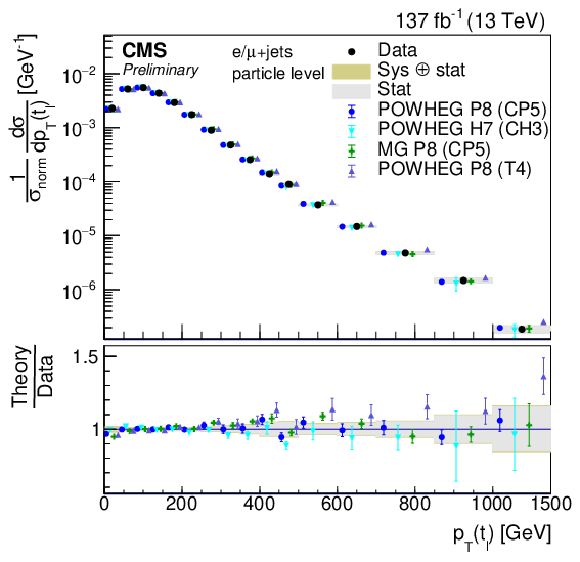
png pdf |
Figure 44-b:
Normalized differential cross section as functions of pT(th), pT(tℓ), pT(thigh), pT(tlow), and ST. The data are shown as points with light (dark) bands indicating the statistical (statistical and systematic) uncertainties. The cross sections are compared to the predictions of POWHEG +PYTHIA (P8) for the CP5 and CUETP8M2T4 (T4), POWHEG +HERWIG (H7), and the multiparton simulation MG5_aMC@NLO (MG)+PYTHIA. The ratios of the various predictions to the measured cross sections are shown at the bottom of each panel. |
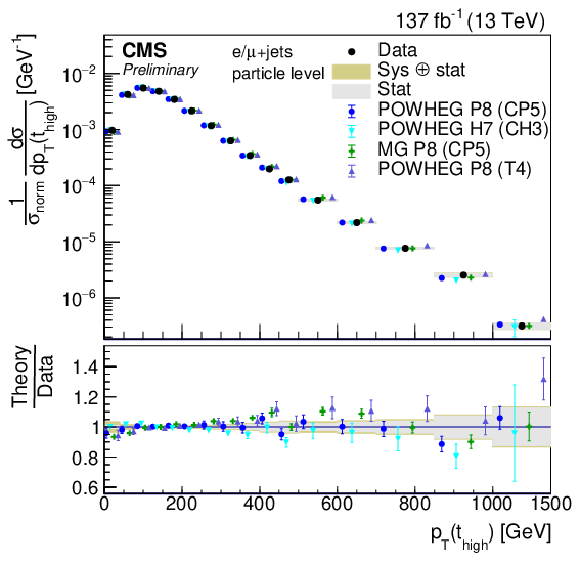
png pdf |
Figure 44-c:
Normalized differential cross section as functions of pT(th), pT(tℓ), pT(thigh), pT(tlow), and ST. The data are shown as points with light (dark) bands indicating the statistical (statistical and systematic) uncertainties. The cross sections are compared to the predictions of POWHEG +PYTHIA (P8) for the CP5 and CUETP8M2T4 (T4), POWHEG +HERWIG (H7), and the multiparton simulation MG5_aMC@NLO (MG)+PYTHIA. The ratios of the various predictions to the measured cross sections are shown at the bottom of each panel. |
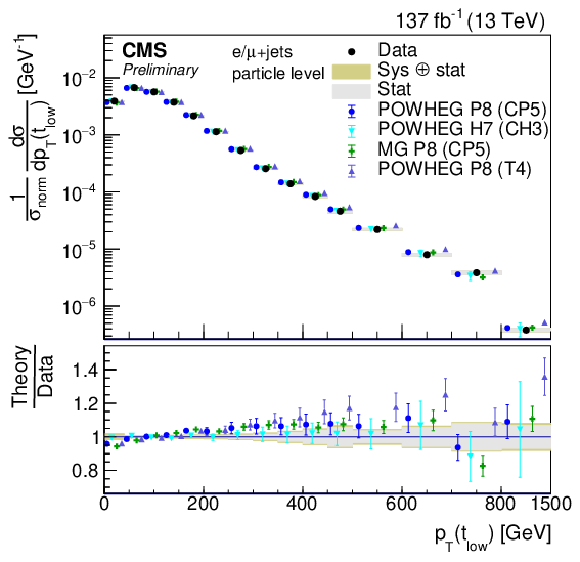
png pdf |
Figure 44-d:
Normalized differential cross section as functions of pT(th), pT(tℓ), pT(thigh), pT(tlow), and ST. The data are shown as points with light (dark) bands indicating the statistical (statistical and systematic) uncertainties. The cross sections are compared to the predictions of POWHEG +PYTHIA (P8) for the CP5 and CUETP8M2T4 (T4), POWHEG +HERWIG (H7), and the multiparton simulation MG5_aMC@NLO (MG)+PYTHIA. The ratios of the various predictions to the measured cross sections are shown at the bottom of each panel. |

png pdf |
Figure 44-e:
Normalized differential cross section as functions of pT(th), pT(tℓ), pT(thigh), pT(tlow), and ST. The data are shown as points with light (dark) bands indicating the statistical (statistical and systematic) uncertainties. The cross sections are compared to the predictions of POWHEG +PYTHIA (P8) for the CP5 and CUETP8M2T4 (T4), POWHEG +HERWIG (H7), and the multiparton simulation MG5_aMC@NLO (MG)+PYTHIA. The ratios of the various predictions to the measured cross sections are shown at the bottom of each panel. |

png pdf |
Figure 45:
Normalized differential cross section as function of |y(th)|, |y(tℓ)|, and the differences Δ|yt/ˉt| and |Δyt/ˉt|. The data are shown as points with light (dark) bands indicating the statistical (statistical and systematic) uncertainties. The cross sections are compared to the predictions of POWHEG combined with PYTHIA (P8) or HERWIG (H7), the multiparton simulation MG5_aMC@NLO (MG5)+PYTHIA FxFx, and the NNLO QCD calculations obtained with Matrix. The ratios of the various predictions to the measured cross sections are shown at the bottom of each panel. |

png pdf |
Figure 45-a:
Normalized differential cross section as function of |y(th)|, |y(tℓ)|, and the differences Δ|yt/ˉt| and |Δyt/ˉt|. The data are shown as points with light (dark) bands indicating the statistical (statistical and systematic) uncertainties. The cross sections are compared to the predictions of POWHEG combined with PYTHIA (P8) or HERWIG (H7), the multiparton simulation MG5_aMC@NLO (MG5)+PYTHIA FxFx, and the NNLO QCD calculations obtained with Matrix. The ratios of the various predictions to the measured cross sections are shown at the bottom of each panel. |
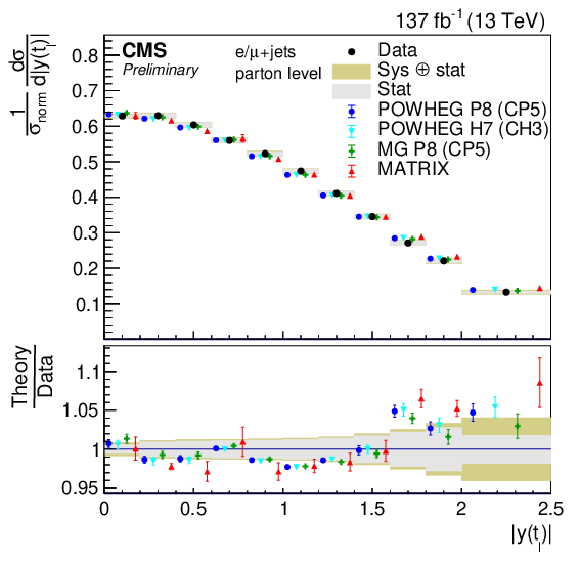
png pdf |
Figure 45-b:
Normalized differential cross section as function of |y(th)|, |y(tℓ)|, and the differences Δ|yt/ˉt| and |Δyt/ˉt|. The data are shown as points with light (dark) bands indicating the statistical (statistical and systematic) uncertainties. The cross sections are compared to the predictions of POWHEG combined with PYTHIA (P8) or HERWIG (H7), the multiparton simulation MG5_aMC@NLO (MG5)+PYTHIA FxFx, and the NNLO QCD calculations obtained with Matrix. The ratios of the various predictions to the measured cross sections are shown at the bottom of each panel. |
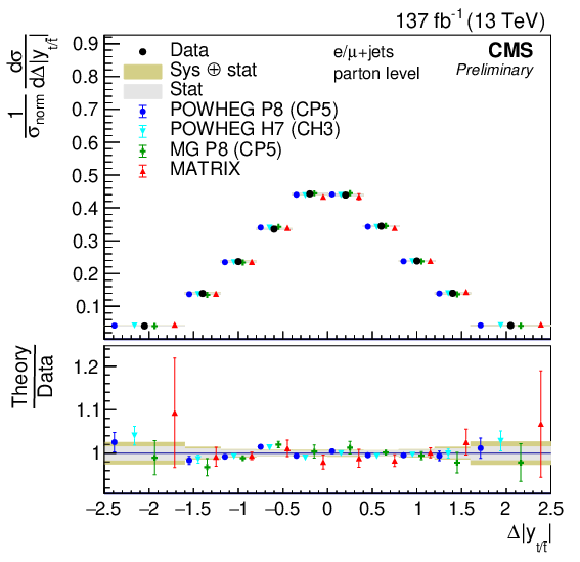
png pdf |
Figure 45-c:
Normalized differential cross section as function of |y(th)|, |y(tℓ)|, and the differences Δ|yt/ˉt| and |Δyt/ˉt|. The data are shown as points with light (dark) bands indicating the statistical (statistical and systematic) uncertainties. The cross sections are compared to the predictions of POWHEG combined with PYTHIA (P8) or HERWIG (H7), the multiparton simulation MG5_aMC@NLO (MG5)+PYTHIA FxFx, and the NNLO QCD calculations obtained with Matrix. The ratios of the various predictions to the measured cross sections are shown at the bottom of each panel. |
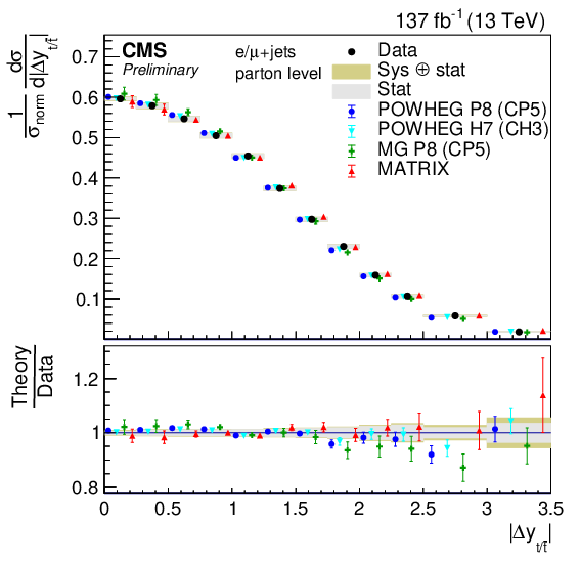
png pdf |
Figure 45-d:
Normalized differential cross section as function of |y(th)|, |y(tℓ)|, and the differences Δ|yt/ˉt| and |Δyt/ˉt|. The data are shown as points with light (dark) bands indicating the statistical (statistical and systematic) uncertainties. The cross sections are compared to the predictions of POWHEG combined with PYTHIA (P8) or HERWIG (H7), the multiparton simulation MG5_aMC@NLO (MG5)+PYTHIA FxFx, and the NNLO QCD calculations obtained with Matrix. The ratios of the various predictions to the measured cross sections are shown at the bottom of each panel. |

png pdf |
Figure 46:
Normalized differential cross section as function of |y(th)|, |y(tℓ)|, and the differences Δ|yt/ˉt| and |Δyt/ˉt|. The data are shown as points with light (dark) bands indicating the statistical (statistical and systematic) uncertainties. The cross sections are compared to the predictions of POWHEG +PYTHIA (P8) for the CP5 and CUETP8M2T4 (T4), POWHEG +HERWIG (H7), and the multiparton simulation MG5_aMC@NLO (MG)+PYTHIA. The ratios of the various predictions to the measured cross sections are shown at the bottom of each panel. |
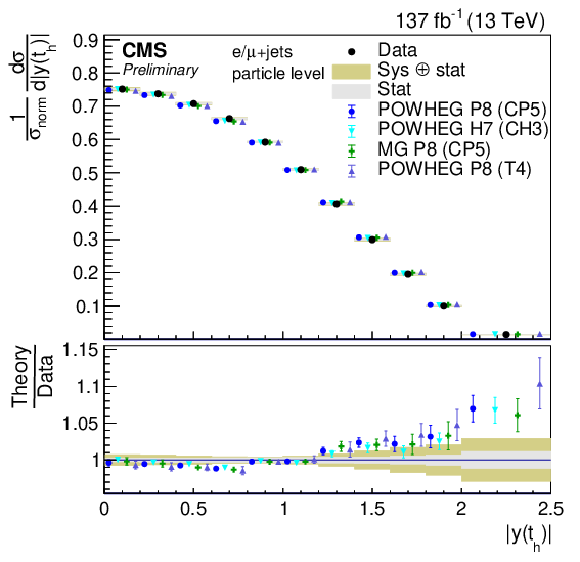
png pdf |
Figure 46-a:
Normalized differential cross section as function of |y(th)|, |y(tℓ)|, and the differences Δ|yt/ˉt| and |Δyt/ˉt|. The data are shown as points with light (dark) bands indicating the statistical (statistical and systematic) uncertainties. The cross sections are compared to the predictions of POWHEG +PYTHIA (P8) for the CP5 and CUETP8M2T4 (T4), POWHEG +HERWIG (H7), and the multiparton simulation MG5_aMC@NLO (MG)+PYTHIA. The ratios of the various predictions to the measured cross sections are shown at the bottom of each panel. |

png pdf |
Figure 46-b:
Normalized differential cross section as function of |y(th)|, |y(tℓ)|, and the differences Δ|yt/ˉt| and |Δyt/ˉt|. The data are shown as points with light (dark) bands indicating the statistical (statistical and systematic) uncertainties. The cross sections are compared to the predictions of POWHEG +PYTHIA (P8) for the CP5 and CUETP8M2T4 (T4), POWHEG +HERWIG (H7), and the multiparton simulation MG5_aMC@NLO (MG)+PYTHIA. The ratios of the various predictions to the measured cross sections are shown at the bottom of each panel. |

png pdf |
Figure 46-c:
Normalized differential cross section as function of |y(th)|, |y(tℓ)|, and the differences Δ|yt/ˉt| and |Δyt/ˉt|. The data are shown as points with light (dark) bands indicating the statistical (statistical and systematic) uncertainties. The cross sections are compared to the predictions of POWHEG +PYTHIA (P8) for the CP5 and CUETP8M2T4 (T4), POWHEG +HERWIG (H7), and the multiparton simulation MG5_aMC@NLO (MG)+PYTHIA. The ratios of the various predictions to the measured cross sections are shown at the bottom of each panel. |
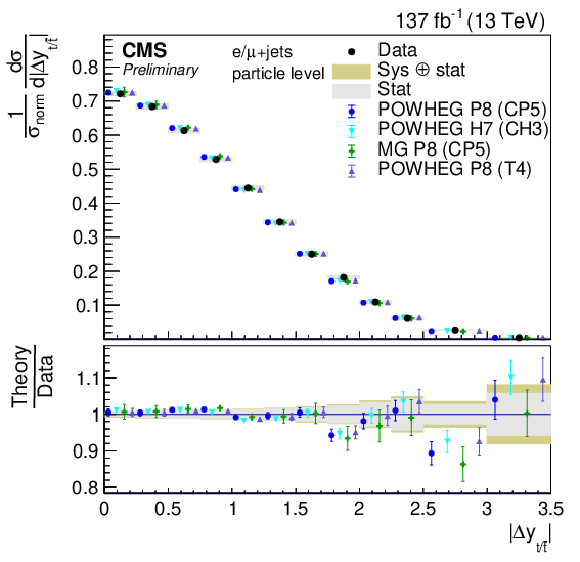
png pdf |
Figure 46-d:
Normalized differential cross section as function of |y(th)|, |y(tℓ)|, and the differences Δ|yt/ˉt| and |Δyt/ˉt|. The data are shown as points with light (dark) bands indicating the statistical (statistical and systematic) uncertainties. The cross sections are compared to the predictions of POWHEG +PYTHIA (P8) for the CP5 and CUETP8M2T4 (T4), POWHEG +HERWIG (H7), and the multiparton simulation MG5_aMC@NLO (MG)+PYTHIA. The ratios of the various predictions to the measured cross sections are shown at the bottom of each panel. |

png pdf |
Figure 47:
Normalized differential cross sections as functions of quantities of the tˉt system. The data are shown as points with light (dark) bands indicating the statistical (statistical and systematic) uncertainties. The cross sections are compared to the predictions of POWHEG combined with PYTHIA (P8) or HERWIG (H7), the multiparton simulation MG5_aMC@NLO (MG5)+PYTHIA FxFx, and the NNLO QCD calculations obtained with Matrix. The ratios of the various predictions to the measured cross sections are shown at the bottom of each panel. |
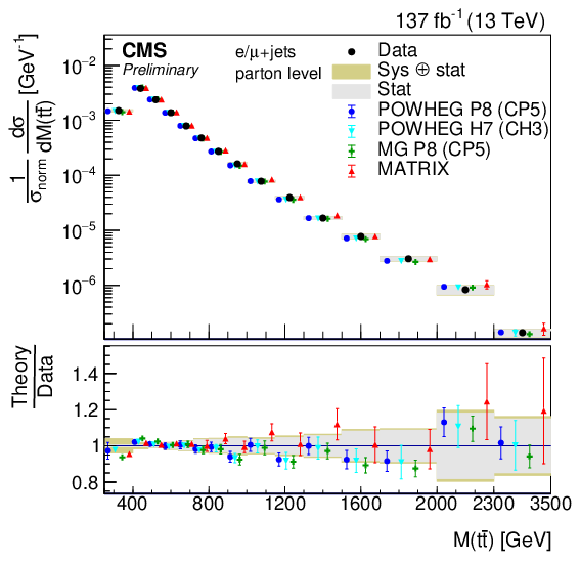
png pdf |
Figure 47-a:
Normalized differential cross sections as functions of quantities of the tˉt system. The data are shown as points with light (dark) bands indicating the statistical (statistical and systematic) uncertainties. The cross sections are compared to the predictions of POWHEG combined with PYTHIA (P8) or HERWIG (H7), the multiparton simulation MG5_aMC@NLO (MG5)+PYTHIA FxFx, and the NNLO QCD calculations obtained with Matrix. The ratios of the various predictions to the measured cross sections are shown at the bottom of each panel. |

png pdf |
Figure 47-b:
Normalized differential cross sections as functions of quantities of the tˉt system. The data are shown as points with light (dark) bands indicating the statistical (statistical and systematic) uncertainties. The cross sections are compared to the predictions of POWHEG combined with PYTHIA (P8) or HERWIG (H7), the multiparton simulation MG5_aMC@NLO (MG5)+PYTHIA FxFx, and the NNLO QCD calculations obtained with Matrix. The ratios of the various predictions to the measured cross sections are shown at the bottom of each panel. |
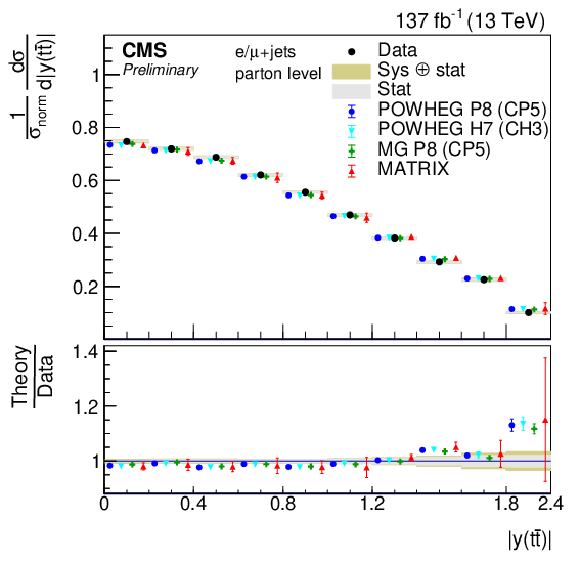
png pdf |
Figure 47-c:
Normalized differential cross sections as functions of quantities of the tˉt system. The data are shown as points with light (dark) bands indicating the statistical (statistical and systematic) uncertainties. The cross sections are compared to the predictions of POWHEG combined with PYTHIA (P8) or HERWIG (H7), the multiparton simulation MG5_aMC@NLO (MG5)+PYTHIA FxFx, and the NNLO QCD calculations obtained with Matrix. The ratios of the various predictions to the measured cross sections are shown at the bottom of each panel. |
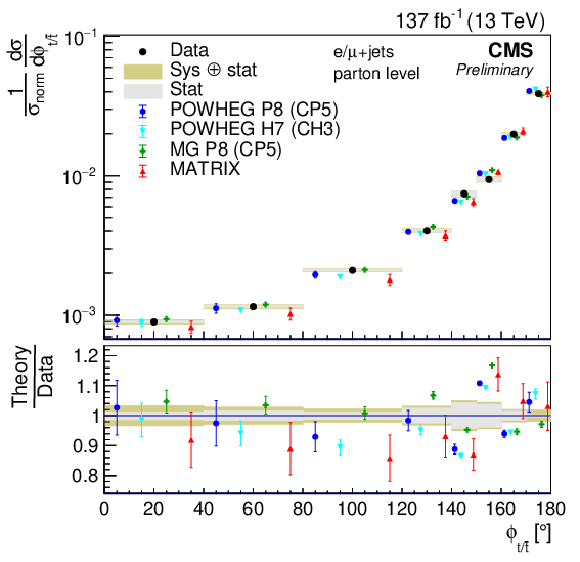
png pdf |
Figure 47-d:
Normalized differential cross sections as functions of quantities of the tˉt system. The data are shown as points with light (dark) bands indicating the statistical (statistical and systematic) uncertainties. The cross sections are compared to the predictions of POWHEG combined with PYTHIA (P8) or HERWIG (H7), the multiparton simulation MG5_aMC@NLO (MG5)+PYTHIA FxFx, and the NNLO QCD calculations obtained with Matrix. The ratios of the various predictions to the measured cross sections are shown at the bottom of each panel. |

png pdf |
Figure 47-e:
Normalized differential cross sections as functions of quantities of the tˉt system. The data are shown as points with light (dark) bands indicating the statistical (statistical and systematic) uncertainties. The cross sections are compared to the predictions of POWHEG combined with PYTHIA (P8) or HERWIG (H7), the multiparton simulation MG5_aMC@NLO (MG5)+PYTHIA FxFx, and the NNLO QCD calculations obtained with Matrix. The ratios of the various predictions to the measured cross sections are shown at the bottom of each panel. |

png pdf |
Figure 48:
Normalized differential cross sections as functions of quantities of the tˉt system. The data are shown as points with light (dark) bands indicating the statistical (statistical and systematic) uncertainties. The cross sections are compared to the predictions of POWHEG +PYTHIA (P8) for the CP5 and CUETP8M2T4 (T4), POWHEG +HERWIG (H7), and the multiparton simulation MG5_aMC@NLO (MG)+PYTHIA. The ratios of the various predictions to the measured cross sections are shown at the bottom of each panel. |
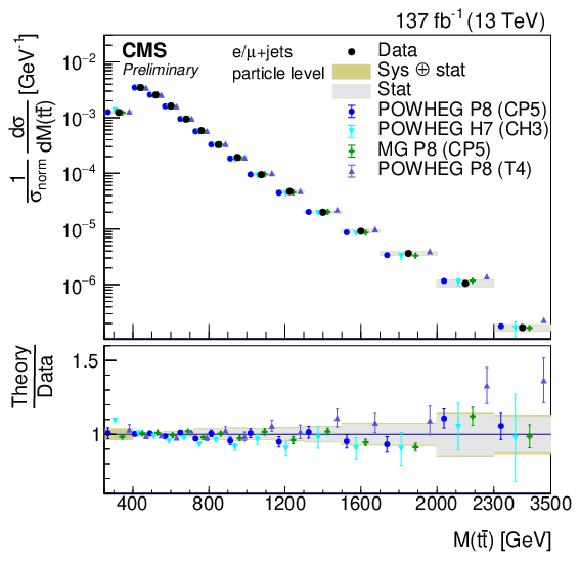
png pdf |
Figure 48-a:
Normalized differential cross sections as functions of quantities of the tˉt system. The data are shown as points with light (dark) bands indicating the statistical (statistical and systematic) uncertainties. The cross sections are compared to the predictions of POWHEG +PYTHIA (P8) for the CP5 and CUETP8M2T4 (T4), POWHEG +HERWIG (H7), and the multiparton simulation MG5_aMC@NLO (MG)+PYTHIA. The ratios of the various predictions to the measured cross sections are shown at the bottom of each panel. |

png pdf |
Figure 48-b:
Normalized differential cross sections as functions of quantities of the tˉt system. The data are shown as points with light (dark) bands indicating the statistical (statistical and systematic) uncertainties. The cross sections are compared to the predictions of POWHEG +PYTHIA (P8) for the CP5 and CUETP8M2T4 (T4), POWHEG +HERWIG (H7), and the multiparton simulation MG5_aMC@NLO (MG)+PYTHIA. The ratios of the various predictions to the measured cross sections are shown at the bottom of each panel. |

png pdf |
Figure 48-c:
Normalized differential cross sections as functions of quantities of the tˉt system. The data are shown as points with light (dark) bands indicating the statistical (statistical and systematic) uncertainties. The cross sections are compared to the predictions of POWHEG +PYTHIA (P8) for the CP5 and CUETP8M2T4 (T4), POWHEG +HERWIG (H7), and the multiparton simulation MG5_aMC@NLO (MG)+PYTHIA. The ratios of the various predictions to the measured cross sections are shown at the bottom of each panel. |
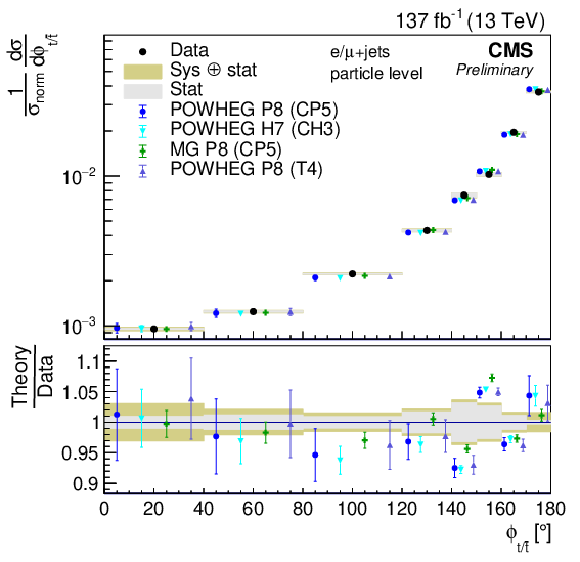
png pdf |
Figure 48-d:
Normalized differential cross sections as functions of quantities of the tˉt system. The data are shown as points with light (dark) bands indicating the statistical (statistical and systematic) uncertainties. The cross sections are compared to the predictions of POWHEG +PYTHIA (P8) for the CP5 and CUETP8M2T4 (T4), POWHEG +HERWIG (H7), and the multiparton simulation MG5_aMC@NLO (MG)+PYTHIA. The ratios of the various predictions to the measured cross sections are shown at the bottom of each panel. |
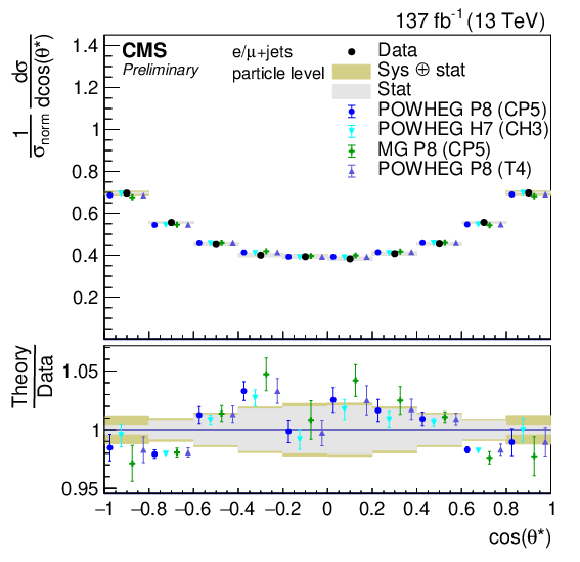
png pdf |
Figure 48-e:
Normalized differential cross sections as functions of quantities of the tˉt system. The data are shown as points with light (dark) bands indicating the statistical (statistical and systematic) uncertainties. The cross sections are compared to the predictions of POWHEG +PYTHIA (P8) for the CP5 and CUETP8M2T4 (T4), POWHEG +HERWIG (H7), and the multiparton simulation MG5_aMC@NLO (MG)+PYTHIA. The ratios of the various predictions to the measured cross sections are shown at the bottom of each panel. |

png pdf |
Figure 49:
Normalized double differential cross section as function of pT(th) vs |y(th)|. The data are shown as points with light (dark) bands indicating the statistical (statistical and systematic) uncertainties. The cross sections are compared to the predictions of POWHEG combined with PYTHIA (P8) or HERWIG (H7), the multiparton simulation MG5_aMC@NLO (MG5)+PYTHIA FxFx, and the NNLO QCD calculations obtained with Matrix. The ratios of the various predictions to the measured cross sections are shown at the bottom of each panel. |

png pdf |
Figure 49-a:
Normalized double differential cross section as function of pT(th) vs |y(th)|. The data are shown as points with light (dark) bands indicating the statistical (statistical and systematic) uncertainties. The cross sections are compared to the predictions of POWHEG combined with PYTHIA (P8) or HERWIG (H7), the multiparton simulation MG5_aMC@NLO (MG5)+PYTHIA FxFx, and the NNLO QCD calculations obtained with Matrix. The ratios of the various predictions to the measured cross sections are shown at the bottom of each panel. |

png pdf |
Figure 49-b:
Normalized double differential cross section as function of pT(th) vs |y(th)|. The data are shown as points with light (dark) bands indicating the statistical (statistical and systematic) uncertainties. The cross sections are compared to the predictions of POWHEG combined with PYTHIA (P8) or HERWIG (H7), the multiparton simulation MG5_aMC@NLO (MG5)+PYTHIA FxFx, and the NNLO QCD calculations obtained with Matrix. The ratios of the various predictions to the measured cross sections are shown at the bottom of each panel. |

png pdf |
Figure 49-c:
Normalized double differential cross section as function of pT(th) vs |y(th)|. The data are shown as points with light (dark) bands indicating the statistical (statistical and systematic) uncertainties. The cross sections are compared to the predictions of POWHEG combined with PYTHIA (P8) or HERWIG (H7), the multiparton simulation MG5_aMC@NLO (MG5)+PYTHIA FxFx, and the NNLO QCD calculations obtained with Matrix. The ratios of the various predictions to the measured cross sections are shown at the bottom of each panel. |
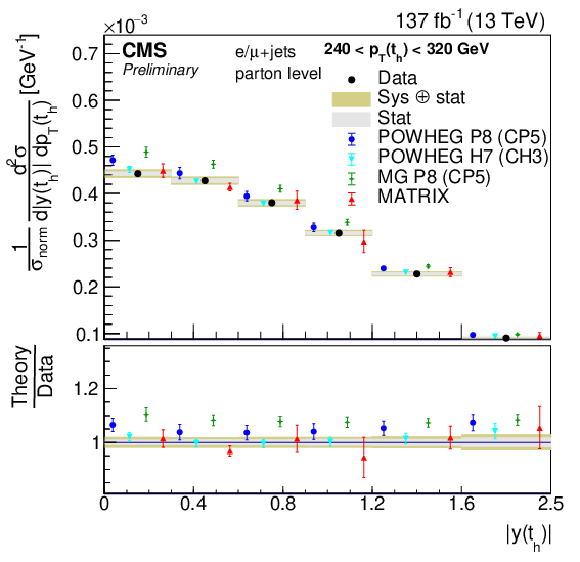
png pdf |
Figure 49-d:
Normalized double differential cross section as function of pT(th) vs |y(th)|. The data are shown as points with light (dark) bands indicating the statistical (statistical and systematic) uncertainties. The cross sections are compared to the predictions of POWHEG combined with PYTHIA (P8) or HERWIG (H7), the multiparton simulation MG5_aMC@NLO (MG5)+PYTHIA FxFx, and the NNLO QCD calculations obtained with Matrix. The ratios of the various predictions to the measured cross sections are shown at the bottom of each panel. |
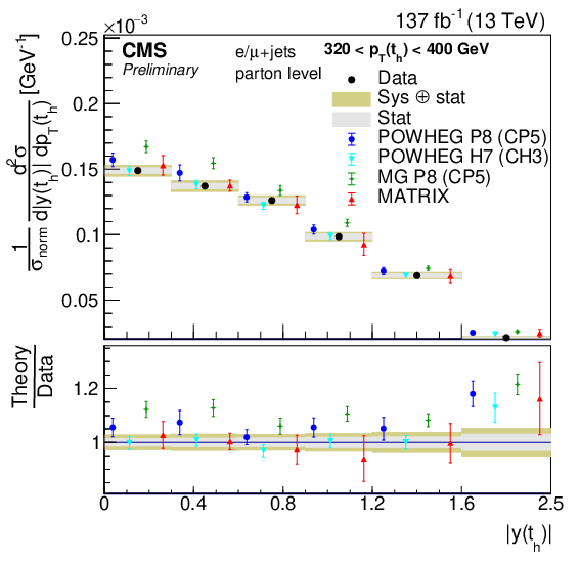
png pdf |
Figure 49-e:
Normalized double differential cross section as function of pT(th) vs |y(th)|. The data are shown as points with light (dark) bands indicating the statistical (statistical and systematic) uncertainties. The cross sections are compared to the predictions of POWHEG combined with PYTHIA (P8) or HERWIG (H7), the multiparton simulation MG5_aMC@NLO (MG5)+PYTHIA FxFx, and the NNLO QCD calculations obtained with Matrix. The ratios of the various predictions to the measured cross sections are shown at the bottom of each panel. |
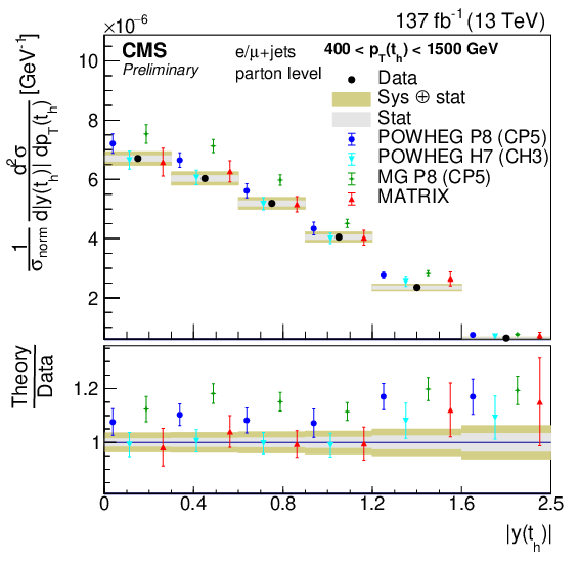
png pdf |
Figure 49-f:
Normalized double differential cross section as function of pT(th) vs |y(th)|. The data are shown as points with light (dark) bands indicating the statistical (statistical and systematic) uncertainties. The cross sections are compared to the predictions of POWHEG combined with PYTHIA (P8) or HERWIG (H7), the multiparton simulation MG5_aMC@NLO (MG5)+PYTHIA FxFx, and the NNLO QCD calculations obtained with Matrix. The ratios of the various predictions to the measured cross sections are shown at the bottom of each panel. |
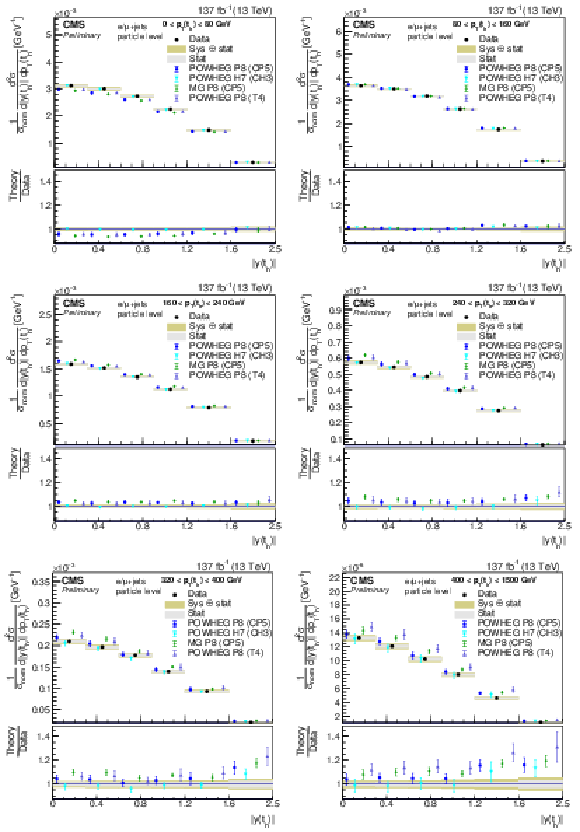
png pdf |
Figure 50:
Normalized double differential cross section as function of pT(th) vs |y(th)|. The data are shown as points with light (dark) bands indicating the statistical (statistical and systematic) uncertainties. The cross sections are compared to the predictions of POWHEG +PYTHIA (P8) for the CP5 and CUETP8M2T4 (T4), POWHEG +HERWIG (H7), and the multiparton simulation MG5_aMC@NLO (MG)+PYTHIA. The ratios of the various predictions to the measured cross sections are shown at the bottom of each panel. |
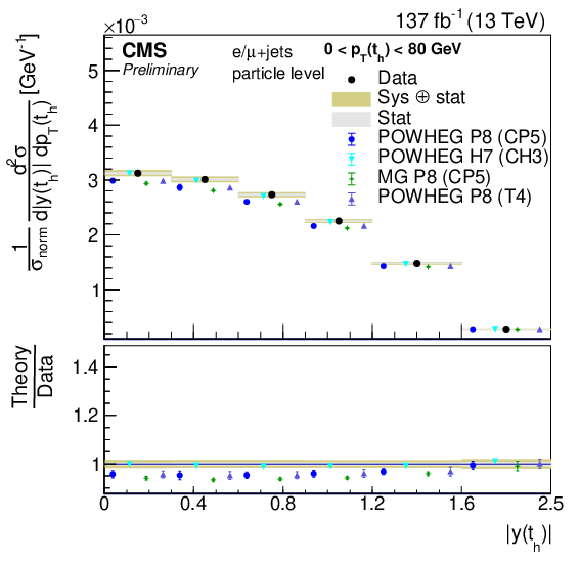
png pdf |
Figure 50-a:
Normalized double differential cross section as function of pT(th) vs |y(th)|. The data are shown as points with light (dark) bands indicating the statistical (statistical and systematic) uncertainties. The cross sections are compared to the predictions of POWHEG +PYTHIA (P8) for the CP5 and CUETP8M2T4 (T4), POWHEG +HERWIG (H7), and the multiparton simulation MG5_aMC@NLO (MG)+PYTHIA. The ratios of the various predictions to the measured cross sections are shown at the bottom of each panel. |
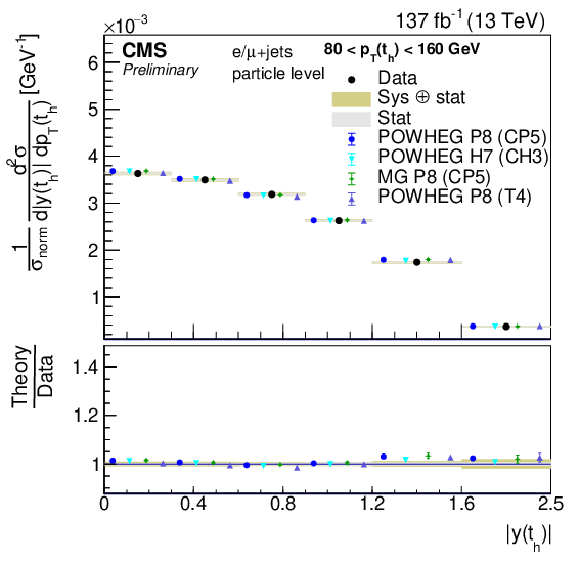
png pdf |
Figure 50-b:
Normalized double differential cross section as function of pT(th) vs |y(th)|. The data are shown as points with light (dark) bands indicating the statistical (statistical and systematic) uncertainties. The cross sections are compared to the predictions of POWHEG +PYTHIA (P8) for the CP5 and CUETP8M2T4 (T4), POWHEG +HERWIG (H7), and the multiparton simulation MG5_aMC@NLO (MG)+PYTHIA. The ratios of the various predictions to the measured cross sections are shown at the bottom of each panel. |

png pdf |
Figure 50-c:
Normalized double differential cross section as function of pT(th) vs |y(th)|. The data are shown as points with light (dark) bands indicating the statistical (statistical and systematic) uncertainties. The cross sections are compared to the predictions of POWHEG +PYTHIA (P8) for the CP5 and CUETP8M2T4 (T4), POWHEG +HERWIG (H7), and the multiparton simulation MG5_aMC@NLO (MG)+PYTHIA. The ratios of the various predictions to the measured cross sections are shown at the bottom of each panel. |

png pdf |
Figure 50-d:
Normalized double differential cross section as function of pT(th) vs |y(th)|. The data are shown as points with light (dark) bands indicating the statistical (statistical and systematic) uncertainties. The cross sections are compared to the predictions of POWHEG +PYTHIA (P8) for the CP5 and CUETP8M2T4 (T4), POWHEG +HERWIG (H7), and the multiparton simulation MG5_aMC@NLO (MG)+PYTHIA. The ratios of the various predictions to the measured cross sections are shown at the bottom of each panel. |

png pdf |
Figure 50-e:
Normalized double differential cross section as function of pT(th) vs |y(th)|. The data are shown as points with light (dark) bands indicating the statistical (statistical and systematic) uncertainties. The cross sections are compared to the predictions of POWHEG +PYTHIA (P8) for the CP5 and CUETP8M2T4 (T4), POWHEG +HERWIG (H7), and the multiparton simulation MG5_aMC@NLO (MG)+PYTHIA. The ratios of the various predictions to the measured cross sections are shown at the bottom of each panel. |
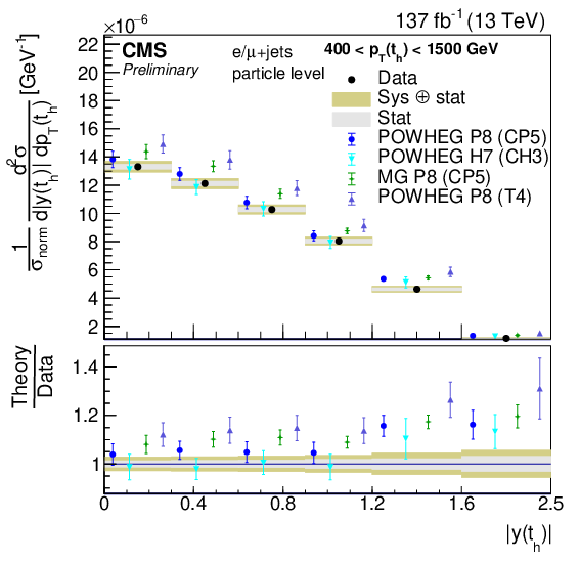
png pdf |
Figure 50-f:
Normalized double differential cross section as function of pT(th) vs |y(th)|. The data are shown as points with light (dark) bands indicating the statistical (statistical and systematic) uncertainties. The cross sections are compared to the predictions of POWHEG +PYTHIA (P8) for the CP5 and CUETP8M2T4 (T4), POWHEG +HERWIG (H7), and the multiparton simulation MG5_aMC@NLO (MG)+PYTHIA. The ratios of the various predictions to the measured cross sections are shown at the bottom of each panel. |

png pdf |
Figure 51:
Normalized double differential cross section as function of M(tˉt) vs |y(tˉt)|. The data are shown as points with light (dark) bands indicating the statistical (statistical and systematic) uncertainties. The cross sections are compared to the predictions of POWHEG combined with PYTHIA (P8) or HERWIG (H7), the multiparton simulation MG5_aMC@NLO (MG5)+PYTHIA FxFx, and the NNLO QCD calculations obtained with Matrix. The ratios of the various predictions to the measured cross sections are shown at the bottom of each panel. |
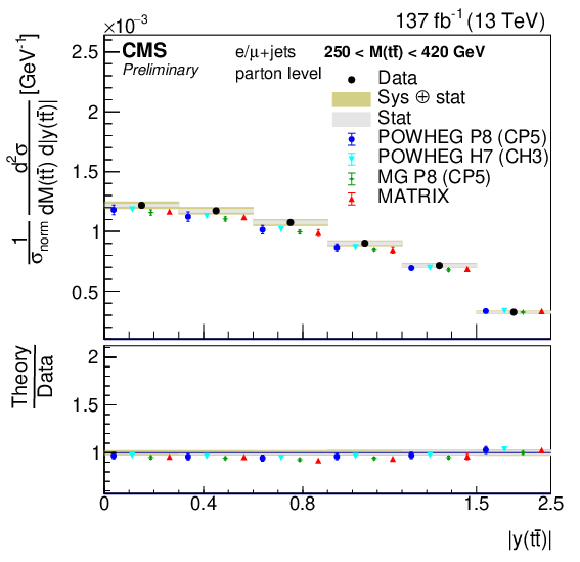
png pdf |
Figure 51-a:
Normalized double differential cross section as function of M(tˉt) vs |y(tˉt)|. The data are shown as points with light (dark) bands indicating the statistical (statistical and systematic) uncertainties. The cross sections are compared to the predictions of POWHEG combined with PYTHIA (P8) or HERWIG (H7), the multiparton simulation MG5_aMC@NLO (MG5)+PYTHIA FxFx, and the NNLO QCD calculations obtained with Matrix. The ratios of the various predictions to the measured cross sections are shown at the bottom of each panel. |
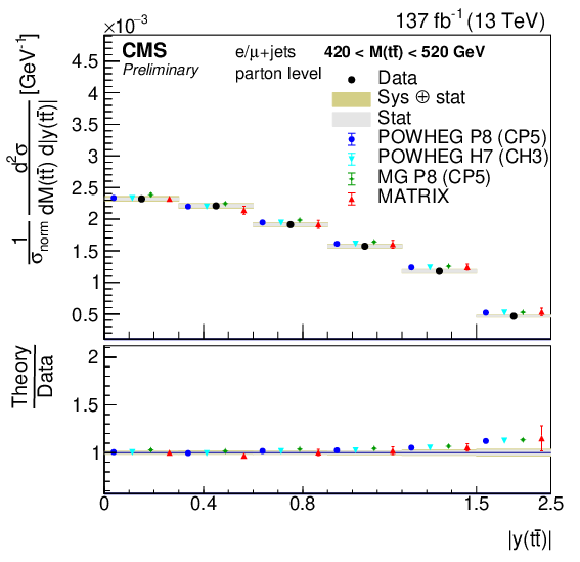
png pdf |
Figure 51-b:
Normalized double differential cross section as function of M(tˉt) vs |y(tˉt)|. The data are shown as points with light (dark) bands indicating the statistical (statistical and systematic) uncertainties. The cross sections are compared to the predictions of POWHEG combined with PYTHIA (P8) or HERWIG (H7), the multiparton simulation MG5_aMC@NLO (MG5)+PYTHIA FxFx, and the NNLO QCD calculations obtained with Matrix. The ratios of the various predictions to the measured cross sections are shown at the bottom of each panel. |
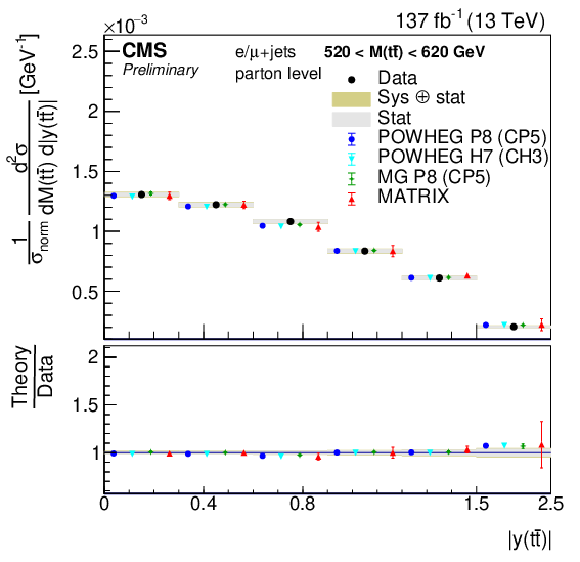
png pdf |
Figure 51-c:
Normalized double differential cross section as function of M(tˉt) vs |y(tˉt)|. The data are shown as points with light (dark) bands indicating the statistical (statistical and systematic) uncertainties. The cross sections are compared to the predictions of POWHEG combined with PYTHIA (P8) or HERWIG (H7), the multiparton simulation MG5_aMC@NLO (MG5)+PYTHIA FxFx, and the NNLO QCD calculations obtained with Matrix. The ratios of the various predictions to the measured cross sections are shown at the bottom of each panel. |
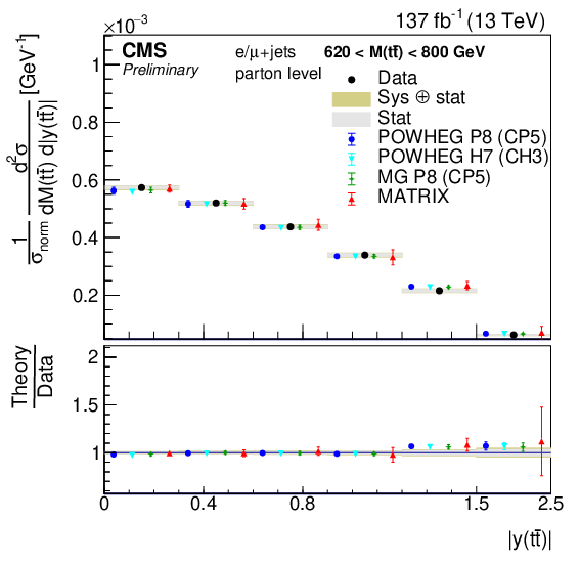
png pdf |
Figure 51-d:
Normalized double differential cross section as function of M(tˉt) vs |y(tˉt)|. The data are shown as points with light (dark) bands indicating the statistical (statistical and systematic) uncertainties. The cross sections are compared to the predictions of POWHEG combined with PYTHIA (P8) or HERWIG (H7), the multiparton simulation MG5_aMC@NLO (MG5)+PYTHIA FxFx, and the NNLO QCD calculations obtained with Matrix. The ratios of the various predictions to the measured cross sections are shown at the bottom of each panel. |
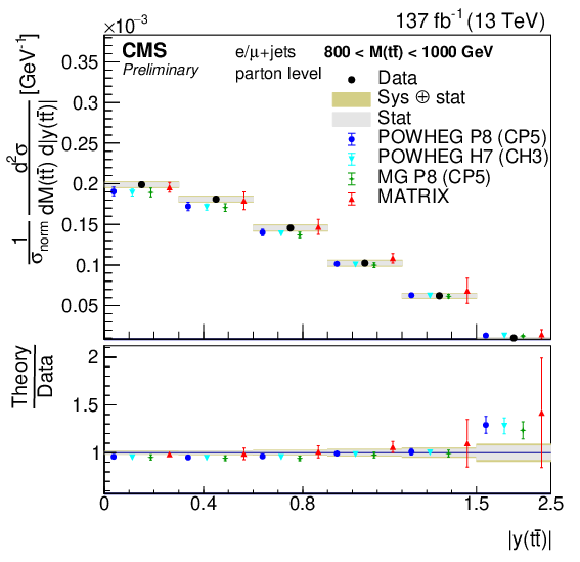
png pdf |
Figure 51-e:
Normalized double differential cross section as function of M(tˉt) vs |y(tˉt)|. The data are shown as points with light (dark) bands indicating the statistical (statistical and systematic) uncertainties. The cross sections are compared to the predictions of POWHEG combined with PYTHIA (P8) or HERWIG (H7), the multiparton simulation MG5_aMC@NLO (MG5)+PYTHIA FxFx, and the NNLO QCD calculations obtained with Matrix. The ratios of the various predictions to the measured cross sections are shown at the bottom of each panel. |

png pdf |
Figure 51-f:
Normalized double differential cross section as function of M(tˉt) vs |y(tˉt)|. The data are shown as points with light (dark) bands indicating the statistical (statistical and systematic) uncertainties. The cross sections are compared to the predictions of POWHEG combined with PYTHIA (P8) or HERWIG (H7), the multiparton simulation MG5_aMC@NLO (MG5)+PYTHIA FxFx, and the NNLO QCD calculations obtained with Matrix. The ratios of the various predictions to the measured cross sections are shown at the bottom of each panel. |

png pdf |
Figure 52:
Normalized double differential cross section as function of M(tˉt) vs |y(tˉt)|. The data are shown as points with light (dark) bands indicating the statistical (statistical and systematic) uncertainties. The cross sections are compared to the predictions of POWHEG +PYTHIA (P8) for the CP5 and CUETP8M2T4 (T4), POWHEG +HERWIG (H7), and the multiparton simulation MG5_aMC@NLO (MG)+PYTHIA. The ratios of the various predictions to the measured cross sections are shown at the bottom of each panel. |

png pdf |
Figure 52-a:
Normalized double differential cross section as function of M(tˉt) vs |y(tˉt)|. The data are shown as points with light (dark) bands indicating the statistical (statistical and systematic) uncertainties. The cross sections are compared to the predictions of POWHEG +PYTHIA (P8) for the CP5 and CUETP8M2T4 (T4), POWHEG +HERWIG (H7), and the multiparton simulation MG5_aMC@NLO (MG)+PYTHIA. The ratios of the various predictions to the measured cross sections are shown at the bottom of each panel. |
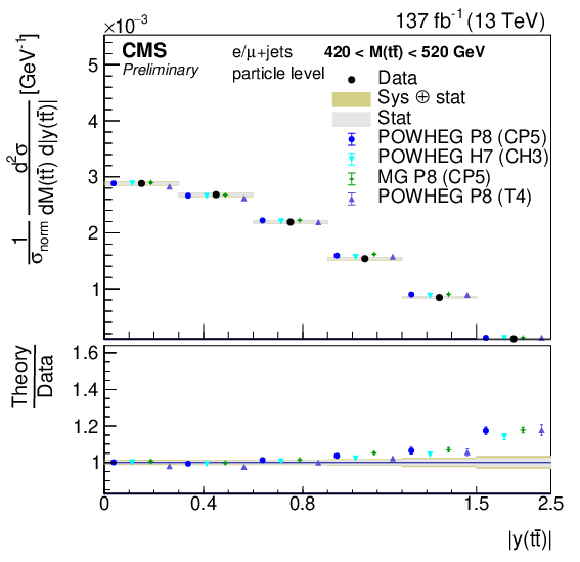
png pdf |
Figure 52-b:
Normalized double differential cross section as function of M(tˉt) vs |y(tˉt)|. The data are shown as points with light (dark) bands indicating the statistical (statistical and systematic) uncertainties. The cross sections are compared to the predictions of POWHEG +PYTHIA (P8) for the CP5 and CUETP8M2T4 (T4), POWHEG +HERWIG (H7), and the multiparton simulation MG5_aMC@NLO (MG)+PYTHIA. The ratios of the various predictions to the measured cross sections are shown at the bottom of each panel. |

png pdf |
Figure 52-c:
Normalized double differential cross section as function of M(tˉt) vs |y(tˉt)|. The data are shown as points with light (dark) bands indicating the statistical (statistical and systematic) uncertainties. The cross sections are compared to the predictions of POWHEG +PYTHIA (P8) for the CP5 and CUETP8M2T4 (T4), POWHEG +HERWIG (H7), and the multiparton simulation MG5_aMC@NLO (MG)+PYTHIA. The ratios of the various predictions to the measured cross sections are shown at the bottom of each panel. |

png pdf |
Figure 52-d:
Normalized double differential cross section as function of M(tˉt) vs |y(tˉt)|. The data are shown as points with light (dark) bands indicating the statistical (statistical and systematic) uncertainties. The cross sections are compared to the predictions of POWHEG +PYTHIA (P8) for the CP5 and CUETP8M2T4 (T4), POWHEG +HERWIG (H7), and the multiparton simulation MG5_aMC@NLO (MG)+PYTHIA. The ratios of the various predictions to the measured cross sections are shown at the bottom of each panel. |

png pdf |
Figure 52-e:
Normalized double differential cross section as function of M(tˉt) vs |y(tˉt)|. The data are shown as points with light (dark) bands indicating the statistical (statistical and systematic) uncertainties. The cross sections are compared to the predictions of POWHEG +PYTHIA (P8) for the CP5 and CUETP8M2T4 (T4), POWHEG +HERWIG (H7), and the multiparton simulation MG5_aMC@NLO (MG)+PYTHIA. The ratios of the various predictions to the measured cross sections are shown at the bottom of each panel. |

png pdf |
Figure 52-f:
Normalized double differential cross section as function of M(tˉt) vs |y(tˉt)|. The data are shown as points with light (dark) bands indicating the statistical (statistical and systematic) uncertainties. The cross sections are compared to the predictions of POWHEG +PYTHIA (P8) for the CP5 and CUETP8M2T4 (T4), POWHEG +HERWIG (H7), and the multiparton simulation MG5_aMC@NLO (MG)+PYTHIA. The ratios of the various predictions to the measured cross sections are shown at the bottom of each panel. |

png pdf |
Figure 53:
Normalized double differential cross section as function of M(tˉt) vs \qopnameelaxocos(θ∗). The data are shown as points with light (dark) bands indicating the statistical (statistical and systematic) uncertainties. The cross sections are compared to the predictions of POWHEG combined with PYTHIA (P8) or HERWIG (H7), the multiparton simulation MG5_aMC@NLO (MG5)+PYTHIA FxFx, and the NNLO QCD calculations obtained with Matrix. The ratios of the various predictions to the measured cross sections are shown at the bottom of each panel. |
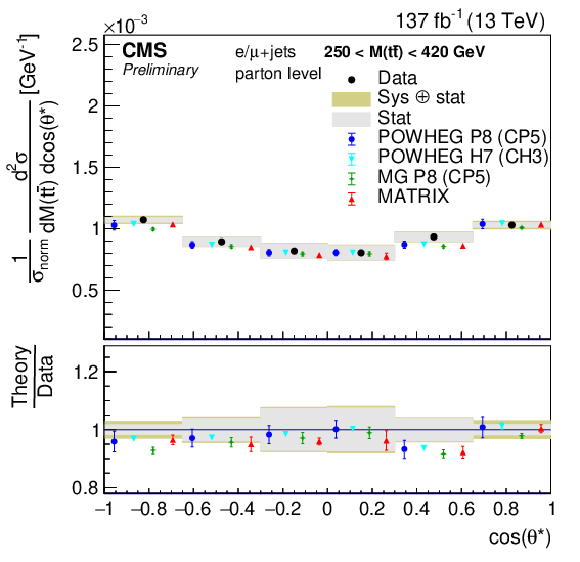
png pdf |
Figure 53-a:
Normalized double differential cross section as function of M(tˉt) vs \qopnameelaxocos(θ∗). The data are shown as points with light (dark) bands indicating the statistical (statistical and systematic) uncertainties. The cross sections are compared to the predictions of POWHEG combined with PYTHIA (P8) or HERWIG (H7), the multiparton simulation MG5_aMC@NLO (MG5)+PYTHIA FxFx, and the NNLO QCD calculations obtained with Matrix. The ratios of the various predictions to the measured cross sections are shown at the bottom of each panel. |
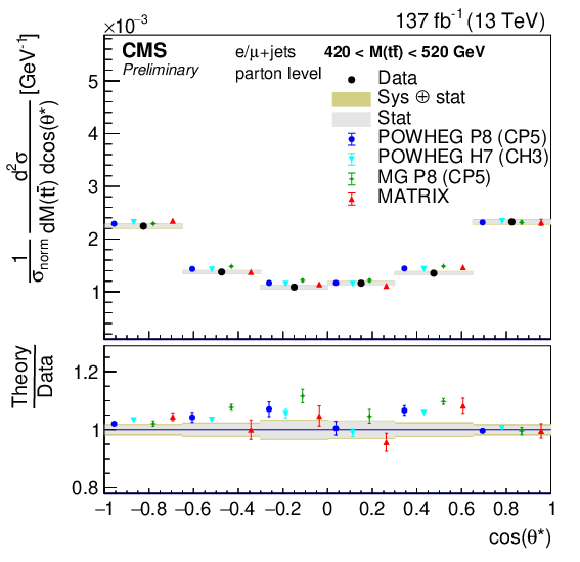
png pdf |
Figure 53-b:
Normalized double differential cross section as function of M(tˉt) vs \qopnameelaxocos(θ∗). The data are shown as points with light (dark) bands indicating the statistical (statistical and systematic) uncertainties. The cross sections are compared to the predictions of POWHEG combined with PYTHIA (P8) or HERWIG (H7), the multiparton simulation MG5_aMC@NLO (MG5)+PYTHIA FxFx, and the NNLO QCD calculations obtained with Matrix. The ratios of the various predictions to the measured cross sections are shown at the bottom of each panel. |

png pdf |
Figure 53-c:
Normalized double differential cross section as function of M(tˉt) vs \qopnameelaxocos(θ∗). The data are shown as points with light (dark) bands indicating the statistical (statistical and systematic) uncertainties. The cross sections are compared to the predictions of POWHEG combined with PYTHIA (P8) or HERWIG (H7), the multiparton simulation MG5_aMC@NLO (MG5)+PYTHIA FxFx, and the NNLO QCD calculations obtained with Matrix. The ratios of the various predictions to the measured cross sections are shown at the bottom of each panel. |
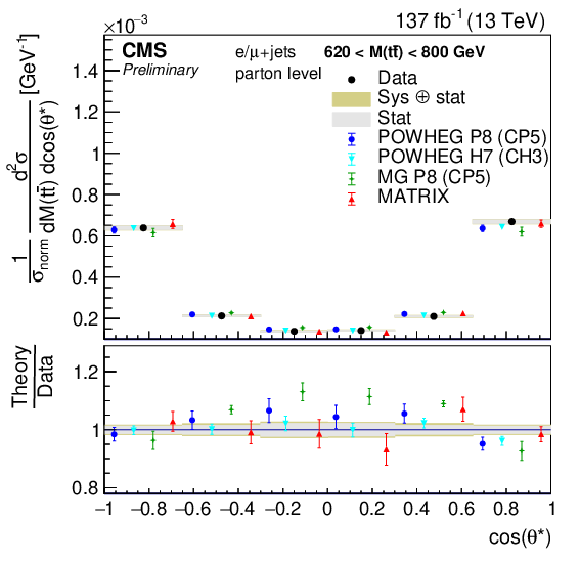
png pdf |
Figure 53-d:
Normalized double differential cross section as function of M(tˉt) vs \qopnameelaxocos(θ∗). The data are shown as points with light (dark) bands indicating the statistical (statistical and systematic) uncertainties. The cross sections are compared to the predictions of POWHEG combined with PYTHIA (P8) or HERWIG (H7), the multiparton simulation MG5_aMC@NLO (MG5)+PYTHIA FxFx, and the NNLO QCD calculations obtained with Matrix. The ratios of the various predictions to the measured cross sections are shown at the bottom of each panel. |
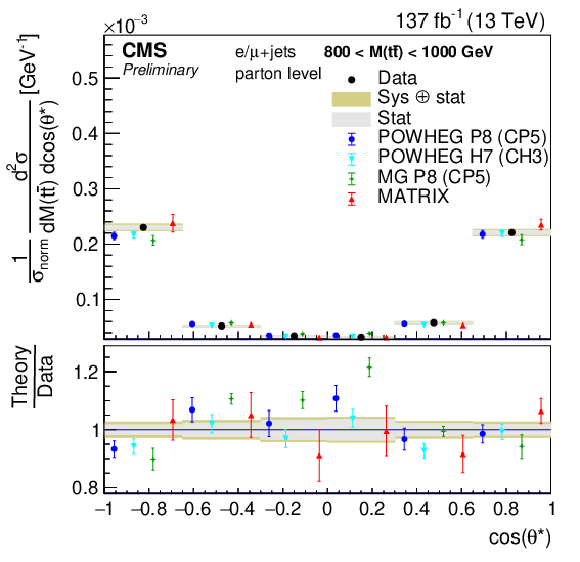
png pdf |
Figure 53-e:
Normalized double differential cross section as function of M(tˉt) vs \qopnameelaxocos(θ∗). The data are shown as points with light (dark) bands indicating the statistical (statistical and systematic) uncertainties. The cross sections are compared to the predictions of POWHEG combined with PYTHIA (P8) or HERWIG (H7), the multiparton simulation MG5_aMC@NLO (MG5)+PYTHIA FxFx, and the NNLO QCD calculations obtained with Matrix. The ratios of the various predictions to the measured cross sections are shown at the bottom of each panel. |
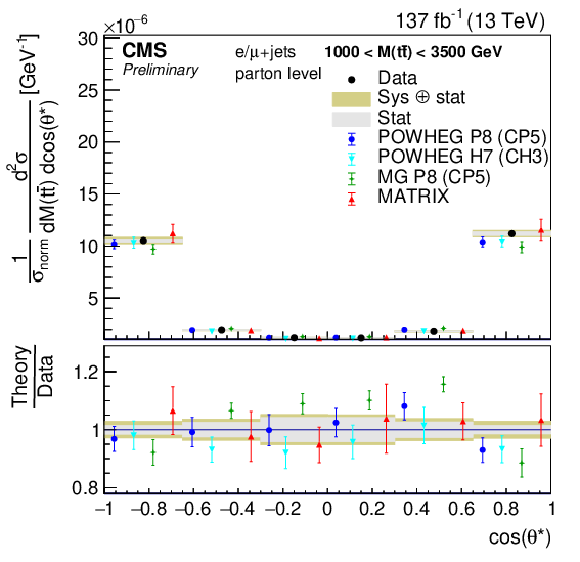
png pdf |
Figure 53-f:
Normalized double differential cross section as function of M(tˉt) vs \qopnameelaxocos(θ∗). The data are shown as points with light (dark) bands indicating the statistical (statistical and systematic) uncertainties. The cross sections are compared to the predictions of POWHEG combined with PYTHIA (P8) or HERWIG (H7), the multiparton simulation MG5_aMC@NLO (MG5)+PYTHIA FxFx, and the NNLO QCD calculations obtained with Matrix. The ratios of the various predictions to the measured cross sections are shown at the bottom of each panel. |

png pdf |
Figure 54:
Normalized double differential cross section as function of M(tˉt) vs \qopnameelaxocos(θ∗). The data are shown as points with light (dark) bands indicating the statistical (statistical and systematic) uncertainties. The cross sections are compared to the predictions of POWHEG +PYTHIA (P8) for the CP5 and CUETP8M2T4 (T4), POWHEG +HERWIG (H7), and the multiparton simulation MG5_aMC@NLO (MG)+PYTHIA. The ratios of the various predictions to the measured cross sections are shown at the bottom of each panel. |
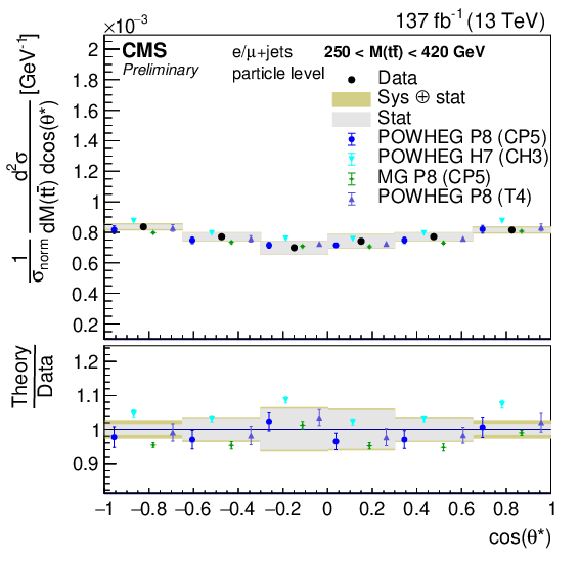
png pdf |
Figure 54-a:
Normalized double differential cross section as function of M(tˉt) vs \qopnameelaxocos(θ∗). The data are shown as points with light (dark) bands indicating the statistical (statistical and systematic) uncertainties. The cross sections are compared to the predictions of POWHEG +PYTHIA (P8) for the CP5 and CUETP8M2T4 (T4), POWHEG +HERWIG (H7), and the multiparton simulation MG5_aMC@NLO (MG)+PYTHIA. The ratios of the various predictions to the measured cross sections are shown at the bottom of each panel. |
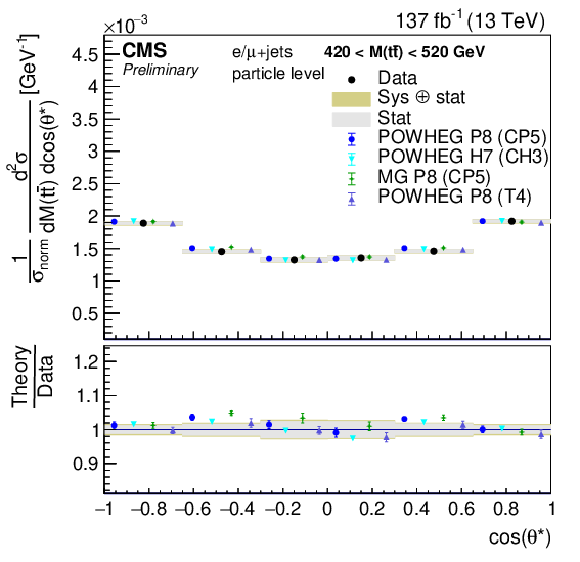
png pdf |
Figure 54-b:
Normalized double differential cross section as function of M(tˉt) vs \qopnameelaxocos(θ∗). The data are shown as points with light (dark) bands indicating the statistical (statistical and systematic) uncertainties. The cross sections are compared to the predictions of POWHEG +PYTHIA (P8) for the CP5 and CUETP8M2T4 (T4), POWHEG +HERWIG (H7), and the multiparton simulation MG5_aMC@NLO (MG)+PYTHIA. The ratios of the various predictions to the measured cross sections are shown at the bottom of each panel. |

png pdf |
Figure 54-c:
Normalized double differential cross section as function of M(tˉt) vs \qopnameelaxocos(θ∗). The data are shown as points with light (dark) bands indicating the statistical (statistical and systematic) uncertainties. The cross sections are compared to the predictions of POWHEG +PYTHIA (P8) for the CP5 and CUETP8M2T4 (T4), POWHEG +HERWIG (H7), and the multiparton simulation MG5_aMC@NLO (MG)+PYTHIA. The ratios of the various predictions to the measured cross sections are shown at the bottom of each panel. |

png pdf |
Figure 54-d:
Normalized double differential cross section as function of M(tˉt) vs \qopnameelaxocos(θ∗). The data are shown as points with light (dark) bands indicating the statistical (statistical and systematic) uncertainties. The cross sections are compared to the predictions of POWHEG +PYTHIA (P8) for the CP5 and CUETP8M2T4 (T4), POWHEG +HERWIG (H7), and the multiparton simulation MG5_aMC@NLO (MG)+PYTHIA. The ratios of the various predictions to the measured cross sections are shown at the bottom of each panel. |
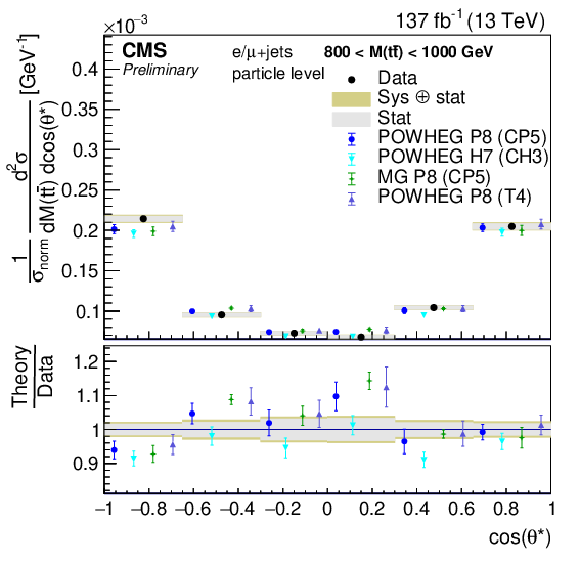
png pdf |
Figure 54-e:
Normalized double differential cross section as function of M(tˉt) vs \qopnameelaxocos(θ∗). The data are shown as points with light (dark) bands indicating the statistical (statistical and systematic) uncertainties. The cross sections are compared to the predictions of POWHEG +PYTHIA (P8) for the CP5 and CUETP8M2T4 (T4), POWHEG +HERWIG (H7), and the multiparton simulation MG5_aMC@NLO (MG)+PYTHIA. The ratios of the various predictions to the measured cross sections are shown at the bottom of each panel. |

png pdf |
Figure 54-f:
Normalized double differential cross section as function of M(tˉt) vs \qopnameelaxocos(θ∗). The data are shown as points with light (dark) bands indicating the statistical (statistical and systematic) uncertainties. The cross sections are compared to the predictions of POWHEG +PYTHIA (P8) for the CP5 and CUETP8M2T4 (T4), POWHEG +HERWIG (H7), and the multiparton simulation MG5_aMC@NLO (MG)+PYTHIA. The ratios of the various predictions to the measured cross sections are shown at the bottom of each panel. |
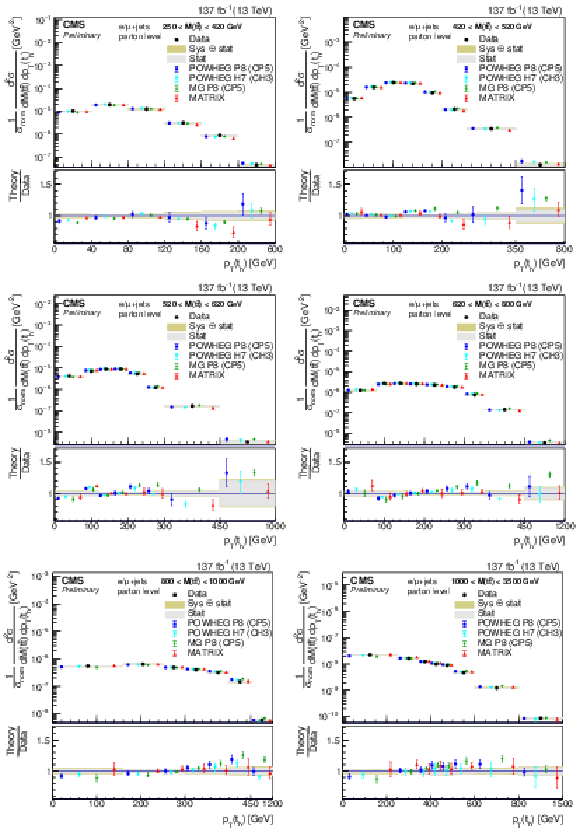
png pdf |
Figure 55:
Normalized double differential cross section as function of M(tˉt) vs pT(th). The data are shown as points with light (dark) bands indicating the statistical (statistical and systematic) uncertainties. The cross sections are compared to the predictions of POWHEG combined with PYTHIA (P8) or HERWIG (H7), the multiparton simulation MG5_aMC@NLO (MG5)+PYTHIA FxFx, and the NNLO QCD calculations obtained with Matrix. The ratios of the various predictions to the measured cross sections are shown at the bottom of each panel. |

png pdf |
Figure 55-a:
Normalized double differential cross section as function of M(tˉt) vs pT(th). The data are shown as points with light (dark) bands indicating the statistical (statistical and systematic) uncertainties. The cross sections are compared to the predictions of POWHEG combined with PYTHIA (P8) or HERWIG (H7), the multiparton simulation MG5_aMC@NLO (MG5)+PYTHIA FxFx, and the NNLO QCD calculations obtained with Matrix. The ratios of the various predictions to the measured cross sections are shown at the bottom of each panel. |

png pdf |
Figure 55-b:
Normalized double differential cross section as function of M(tˉt) vs pT(th). The data are shown as points with light (dark) bands indicating the statistical (statistical and systematic) uncertainties. The cross sections are compared to the predictions of POWHEG combined with PYTHIA (P8) or HERWIG (H7), the multiparton simulation MG5_aMC@NLO (MG5)+PYTHIA FxFx, and the NNLO QCD calculations obtained with Matrix. The ratios of the various predictions to the measured cross sections are shown at the bottom of each panel. |
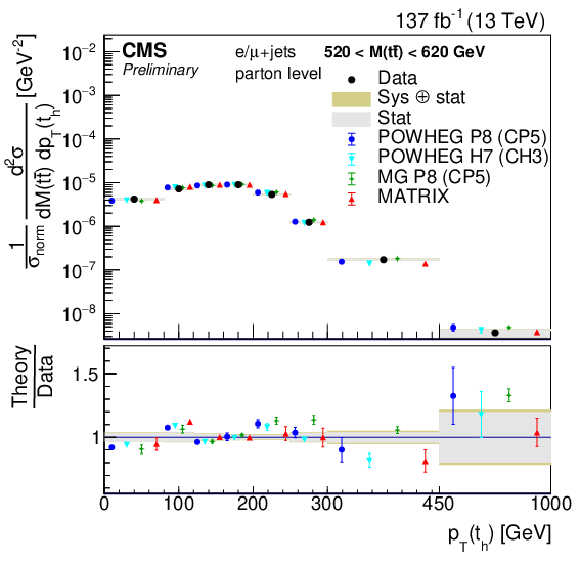
png pdf |
Figure 55-c:
Normalized double differential cross section as function of M(tˉt) vs pT(th). The data are shown as points with light (dark) bands indicating the statistical (statistical and systematic) uncertainties. The cross sections are compared to the predictions of POWHEG combined with PYTHIA (P8) or HERWIG (H7), the multiparton simulation MG5_aMC@NLO (MG5)+PYTHIA FxFx, and the NNLO QCD calculations obtained with Matrix. The ratios of the various predictions to the measured cross sections are shown at the bottom of each panel. |
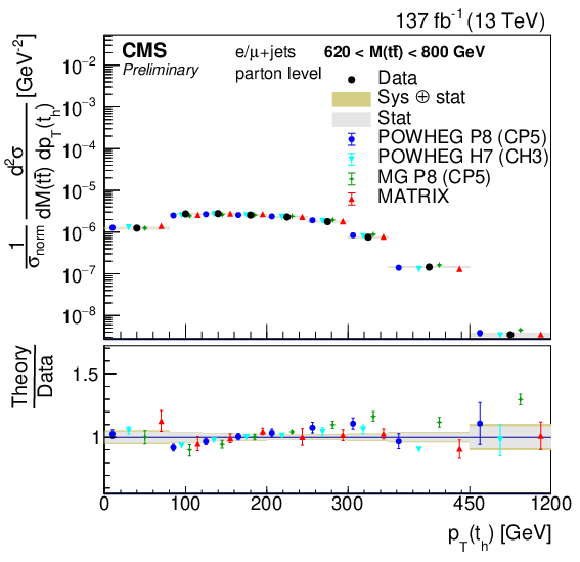
png pdf |
Figure 55-d:
Normalized double differential cross section as function of M(tˉt) vs pT(th). The data are shown as points with light (dark) bands indicating the statistical (statistical and systematic) uncertainties. The cross sections are compared to the predictions of POWHEG combined with PYTHIA (P8) or HERWIG (H7), the multiparton simulation MG5_aMC@NLO (MG5)+PYTHIA FxFx, and the NNLO QCD calculations obtained with Matrix. The ratios of the various predictions to the measured cross sections are shown at the bottom of each panel. |
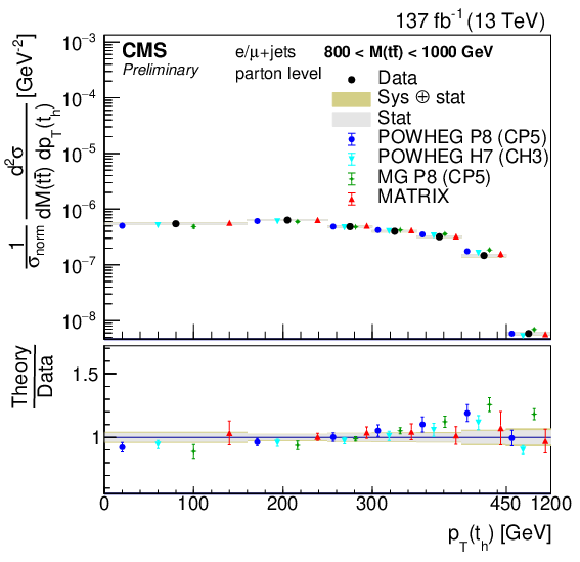
png pdf |
Figure 55-e:
Normalized double differential cross section as function of M(tˉt) vs pT(th). The data are shown as points with light (dark) bands indicating the statistical (statistical and systematic) uncertainties. The cross sections are compared to the predictions of POWHEG combined with PYTHIA (P8) or HERWIG (H7), the multiparton simulation MG5_aMC@NLO (MG5)+PYTHIA FxFx, and the NNLO QCD calculations obtained with Matrix. The ratios of the various predictions to the measured cross sections are shown at the bottom of each panel. |
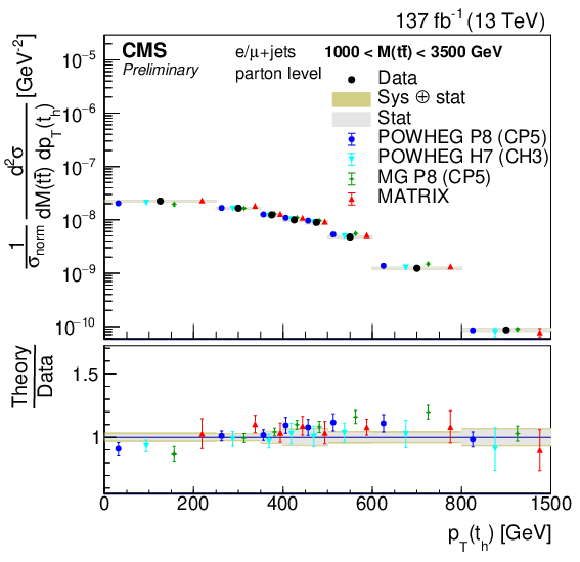
png pdf |
Figure 55-f:
Normalized double differential cross section as function of M(tˉt) vs pT(th). The data are shown as points with light (dark) bands indicating the statistical (statistical and systematic) uncertainties. The cross sections are compared to the predictions of POWHEG combined with PYTHIA (P8) or HERWIG (H7), the multiparton simulation MG5_aMC@NLO (MG5)+PYTHIA FxFx, and the NNLO QCD calculations obtained with Matrix. The ratios of the various predictions to the measured cross sections are shown at the bottom of each panel. |
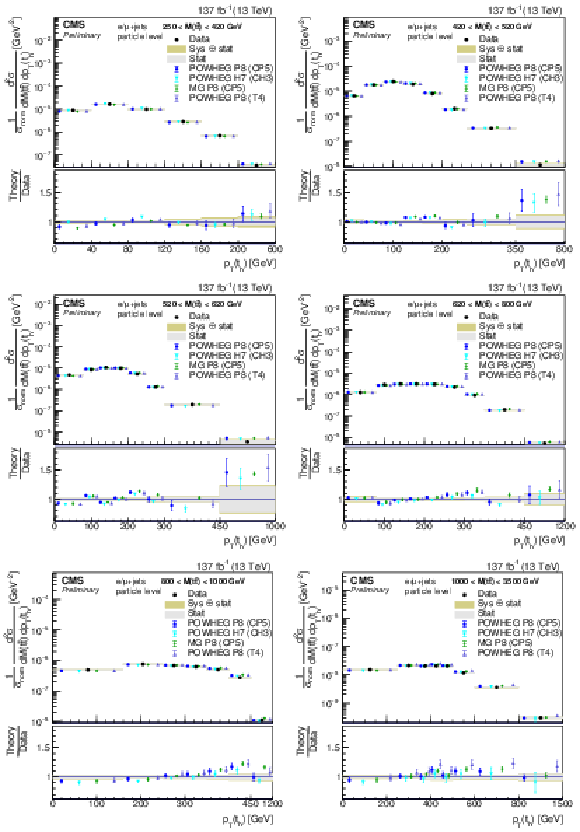
png pdf |
Figure 56:
Normalized double differential cross section as function of M(tˉt) vs pT(th). The data are shown as points with light (dark) bands indicating the statistical (statistical and systematic) uncertainties. The cross sections are compared to the predictions of POWHEG +PYTHIA (P8) for the CP5 and CUETP8M2T4 (T4), POWHEG +HERWIG (H7), and the multiparton simulation MG5_aMC@NLO (MG)+PYTHIA. The ratios of the various predictions to the measured cross sections are shown at the bottom of each panel. |
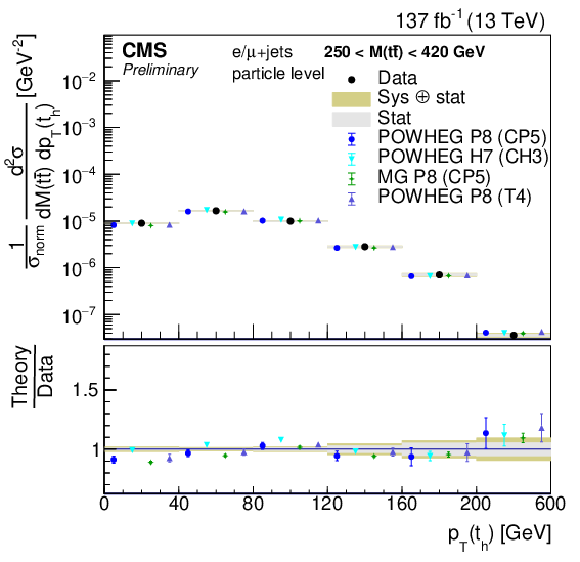
png pdf |
Figure 56-a:
Normalized double differential cross section as function of M(tˉt) vs pT(th). The data are shown as points with light (dark) bands indicating the statistical (statistical and systematic) uncertainties. The cross sections are compared to the predictions of POWHEG +PYTHIA (P8) for the CP5 and CUETP8M2T4 (T4), POWHEG +HERWIG (H7), and the multiparton simulation MG5_aMC@NLO (MG)+PYTHIA. The ratios of the various predictions to the measured cross sections are shown at the bottom of each panel. |

png pdf |
Figure 56-b:
Normalized double differential cross section as function of M(tˉt) vs pT(th). The data are shown as points with light (dark) bands indicating the statistical (statistical and systematic) uncertainties. The cross sections are compared to the predictions of POWHEG +PYTHIA (P8) for the CP5 and CUETP8M2T4 (T4), POWHEG +HERWIG (H7), and the multiparton simulation MG5_aMC@NLO (MG)+PYTHIA. The ratios of the various predictions to the measured cross sections are shown at the bottom of each panel. |

png pdf |
Figure 56-c:
Normalized double differential cross section as function of M(tˉt) vs pT(th). The data are shown as points with light (dark) bands indicating the statistical (statistical and systematic) uncertainties. The cross sections are compared to the predictions of POWHEG +PYTHIA (P8) for the CP5 and CUETP8M2T4 (T4), POWHEG +HERWIG (H7), and the multiparton simulation MG5_aMC@NLO (MG)+PYTHIA. The ratios of the various predictions to the measured cross sections are shown at the bottom of each panel. |
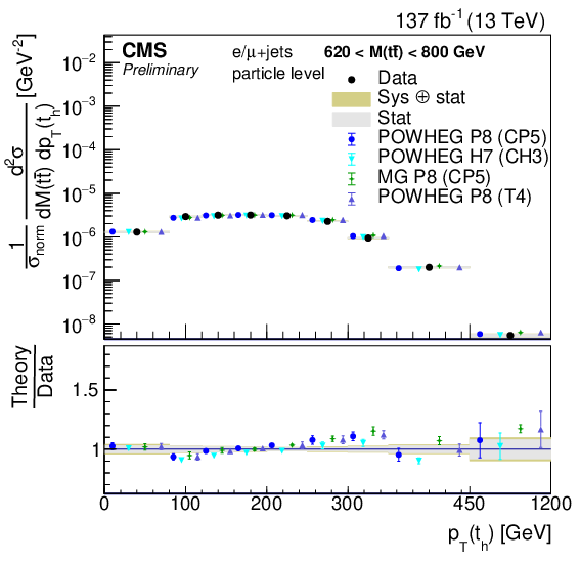
png pdf |
Figure 56-d:
Normalized double differential cross section as function of M(tˉt) vs pT(th). The data are shown as points with light (dark) bands indicating the statistical (statistical and systematic) uncertainties. The cross sections are compared to the predictions of POWHEG +PYTHIA (P8) for the CP5 and CUETP8M2T4 (T4), POWHEG +HERWIG (H7), and the multiparton simulation MG5_aMC@NLO (MG)+PYTHIA. The ratios of the various predictions to the measured cross sections are shown at the bottom of each panel. |

png pdf |
Figure 56-e:
Normalized double differential cross section as function of M(tˉt) vs pT(th). The data are shown as points with light (dark) bands indicating the statistical (statistical and systematic) uncertainties. The cross sections are compared to the predictions of POWHEG +PYTHIA (P8) for the CP5 and CUETP8M2T4 (T4), POWHEG +HERWIG (H7), and the multiparton simulation MG5_aMC@NLO (MG)+PYTHIA. The ratios of the various predictions to the measured cross sections are shown at the bottom of each panel. |

png pdf |
Figure 56-f:
Normalized double differential cross section as function of M(tˉt) vs pT(th). The data are shown as points with light (dark) bands indicating the statistical (statistical and systematic) uncertainties. The cross sections are compared to the predictions of POWHEG +PYTHIA (P8) for the CP5 and CUETP8M2T4 (T4), POWHEG +HERWIG (H7), and the multiparton simulation MG5_aMC@NLO (MG)+PYTHIA. The ratios of the various predictions to the measured cross sections are shown at the bottom of each panel. |

png pdf |
Figure 57:
Normalized double differential cross section as function of pT(tˉt) vs pT(th). The data are shown as points with light (dark) bands indicating the statistical (statistical and systematic) uncertainties. The cross sections are compared to the predictions of POWHEG combined with PYTHIA (P8) or HERWIG (H7), the multiparton simulation MG5_aMC@NLO (MG5)+PYTHIA FxFx, and the NNLO QCD calculations obtained with Matrix. The ratios of the various predictions to the measured cross sections are shown at the bottom of each panel. |
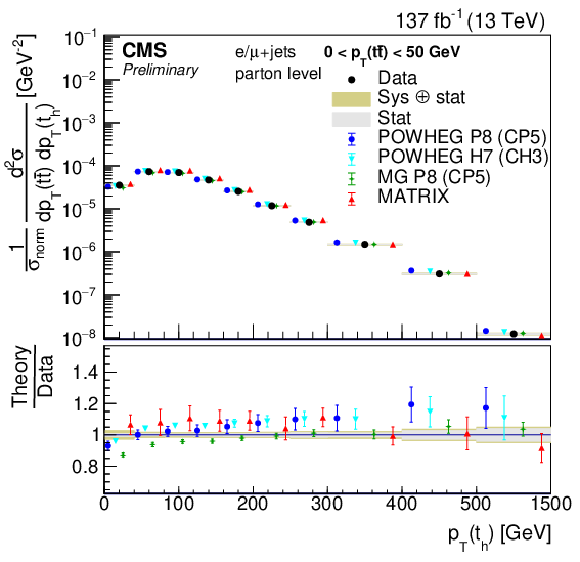
png pdf |
Figure 57-a:
Normalized double differential cross section as function of pT(tˉt) vs pT(th). The data are shown as points with light (dark) bands indicating the statistical (statistical and systematic) uncertainties. The cross sections are compared to the predictions of POWHEG combined with PYTHIA (P8) or HERWIG (H7), the multiparton simulation MG5_aMC@NLO (MG5)+PYTHIA FxFx, and the NNLO QCD calculations obtained with Matrix. The ratios of the various predictions to the measured cross sections are shown at the bottom of each panel. |
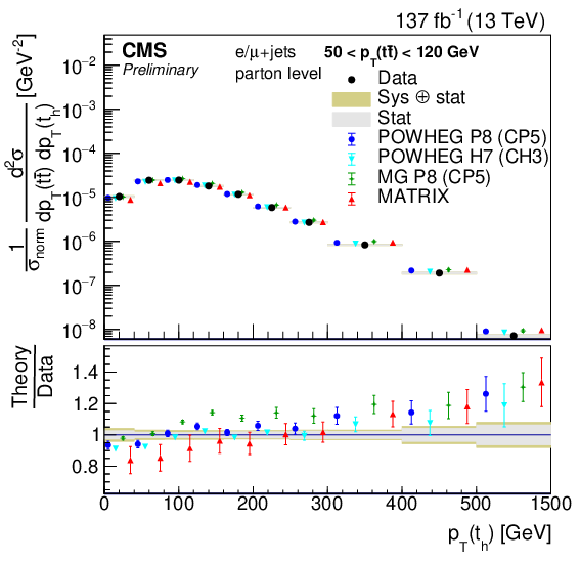
png pdf |
Figure 57-b:
Normalized double differential cross section as function of pT(tˉt) vs pT(th). The data are shown as points with light (dark) bands indicating the statistical (statistical and systematic) uncertainties. The cross sections are compared to the predictions of POWHEG combined with PYTHIA (P8) or HERWIG (H7), the multiparton simulation MG5_aMC@NLO (MG5)+PYTHIA FxFx, and the NNLO QCD calculations obtained with Matrix. The ratios of the various predictions to the measured cross sections are shown at the bottom of each panel. |

png pdf |
Figure 57-c:
Normalized double differential cross section as function of pT(tˉt) vs pT(th). The data are shown as points with light (dark) bands indicating the statistical (statistical and systematic) uncertainties. The cross sections are compared to the predictions of POWHEG combined with PYTHIA (P8) or HERWIG (H7), the multiparton simulation MG5_aMC@NLO (MG5)+PYTHIA FxFx, and the NNLO QCD calculations obtained with Matrix. The ratios of the various predictions to the measured cross sections are shown at the bottom of each panel. |

png pdf |
Figure 57-d:
Normalized double differential cross section as function of pT(tˉt) vs pT(th). The data are shown as points with light (dark) bands indicating the statistical (statistical and systematic) uncertainties. The cross sections are compared to the predictions of POWHEG combined with PYTHIA (P8) or HERWIG (H7), the multiparton simulation MG5_aMC@NLO (MG5)+PYTHIA FxFx, and the NNLO QCD calculations obtained with Matrix. The ratios of the various predictions to the measured cross sections are shown at the bottom of each panel. |

png pdf |
Figure 57-e:
Normalized double differential cross section as function of pT(tˉt) vs pT(th). The data are shown as points with light (dark) bands indicating the statistical (statistical and systematic) uncertainties. The cross sections are compared to the predictions of POWHEG combined with PYTHIA (P8) or HERWIG (H7), the multiparton simulation MG5_aMC@NLO (MG5)+PYTHIA FxFx, and the NNLO QCD calculations obtained with Matrix. The ratios of the various predictions to the measured cross sections are shown at the bottom of each panel. |
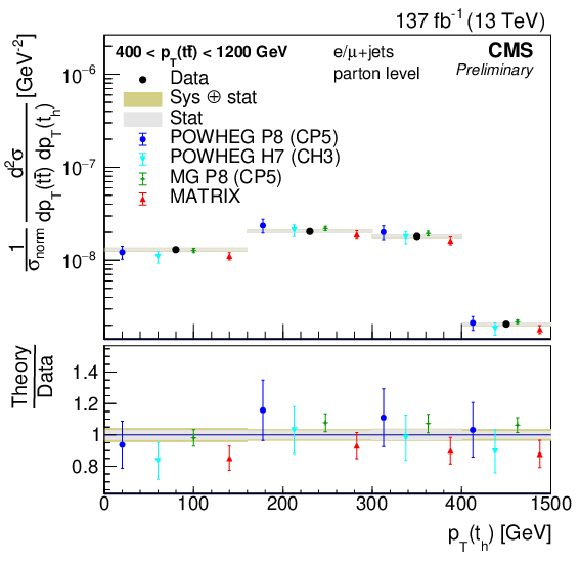
png pdf |
Figure 57-f:
Normalized double differential cross section as function of pT(tˉt) vs pT(th). The data are shown as points with light (dark) bands indicating the statistical (statistical and systematic) uncertainties. The cross sections are compared to the predictions of POWHEG combined with PYTHIA (P8) or HERWIG (H7), the multiparton simulation MG5_aMC@NLO (MG5)+PYTHIA FxFx, and the NNLO QCD calculations obtained with Matrix. The ratios of the various predictions to the measured cross sections are shown at the bottom of each panel. |
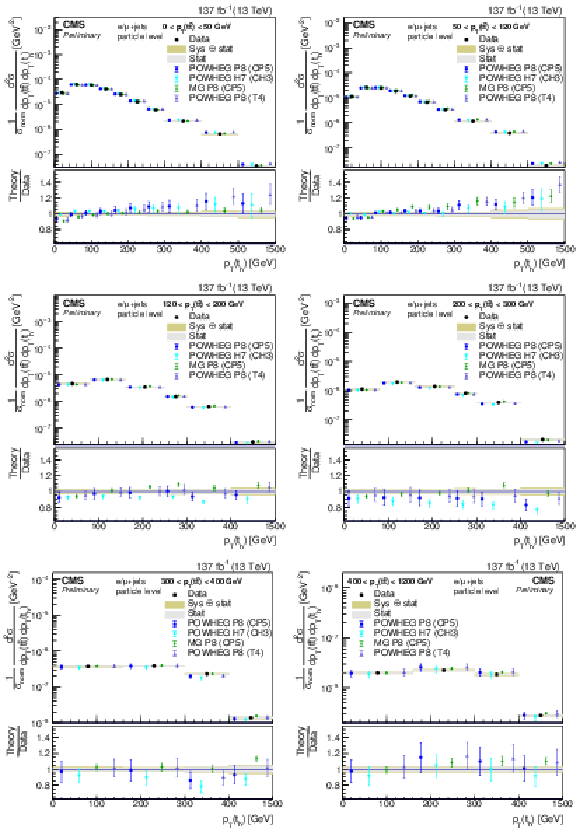
png pdf |
Figure 58:
Normalized double differential cross section as function of pT(tˉt) vs pT(th). The data are shown as points with light (dark) bands indicating the statistical (statistical and systematic) uncertainties. The cross sections are compared to the predictions of POWHEG +PYTHIA (P8) for the CP5 and CUETP8M2T4 (T4), POWHEG +HERWIG (H7), and the multiparton simulation MG5_aMC@NLO (MG)+PYTHIA. The ratios of the various predictions to the measured cross sections are shown at the bottom of each panel. |

png pdf |
Figure 58-a:
Normalized double differential cross section as function of pT(tˉt) vs pT(th). The data are shown as points with light (dark) bands indicating the statistical (statistical and systematic) uncertainties. The cross sections are compared to the predictions of POWHEG +PYTHIA (P8) for the CP5 and CUETP8M2T4 (T4), POWHEG +HERWIG (H7), and the multiparton simulation MG5_aMC@NLO (MG)+PYTHIA. The ratios of the various predictions to the measured cross sections are shown at the bottom of each panel. |
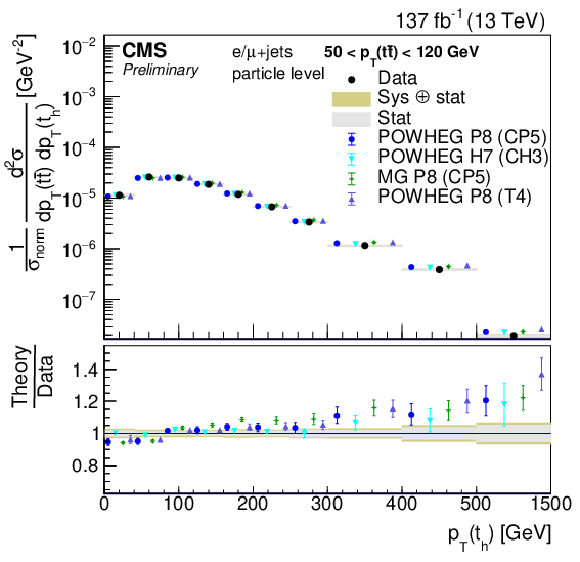
png pdf |
Figure 58-b:
Normalized double differential cross section as function of pT(tˉt) vs pT(th). The data are shown as points with light (dark) bands indicating the statistical (statistical and systematic) uncertainties. The cross sections are compared to the predictions of POWHEG +PYTHIA (P8) for the CP5 and CUETP8M2T4 (T4), POWHEG +HERWIG (H7), and the multiparton simulation MG5_aMC@NLO (MG)+PYTHIA. The ratios of the various predictions to the measured cross sections are shown at the bottom of each panel. |
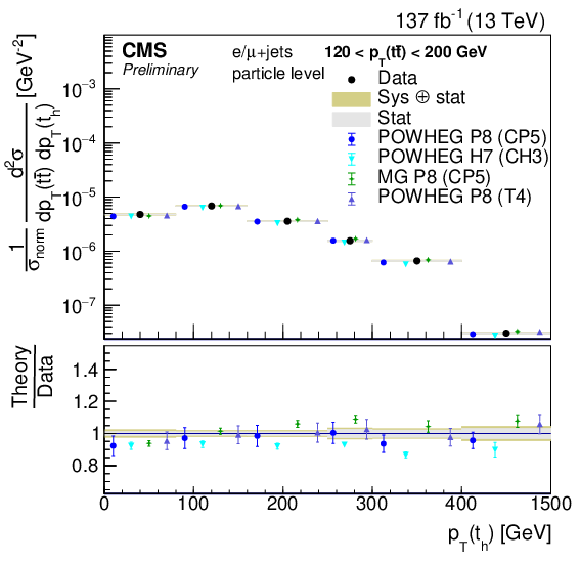
png pdf |
Figure 58-c:
Normalized double differential cross section as function of pT(tˉt) vs pT(th). The data are shown as points with light (dark) bands indicating the statistical (statistical and systematic) uncertainties. The cross sections are compared to the predictions of POWHEG +PYTHIA (P8) for the CP5 and CUETP8M2T4 (T4), POWHEG +HERWIG (H7), and the multiparton simulation MG5_aMC@NLO (MG)+PYTHIA. The ratios of the various predictions to the measured cross sections are shown at the bottom of each panel. |

png pdf |
Figure 58-d:
Normalized double differential cross section as function of pT(tˉt) vs pT(th). The data are shown as points with light (dark) bands indicating the statistical (statistical and systematic) uncertainties. The cross sections are compared to the predictions of POWHEG +PYTHIA (P8) for the CP5 and CUETP8M2T4 (T4), POWHEG +HERWIG (H7), and the multiparton simulation MG5_aMC@NLO (MG)+PYTHIA. The ratios of the various predictions to the measured cross sections are shown at the bottom of each panel. |

png pdf |
Figure 58-e:
Normalized double differential cross section as function of pT(tˉt) vs pT(th). The data are shown as points with light (dark) bands indicating the statistical (statistical and systematic) uncertainties. The cross sections are compared to the predictions of POWHEG +PYTHIA (P8) for the CP5 and CUETP8M2T4 (T4), POWHEG +HERWIG (H7), and the multiparton simulation MG5_aMC@NLO (MG)+PYTHIA. The ratios of the various predictions to the measured cross sections are shown at the bottom of each panel. |

png pdf |
Figure 58-f:
Normalized double differential cross section as function of pT(tˉt) vs pT(th). The data are shown as points with light (dark) bands indicating the statistical (statistical and systematic) uncertainties. The cross sections are compared to the predictions of POWHEG +PYTHIA (P8) for the CP5 and CUETP8M2T4 (T4), POWHEG +HERWIG (H7), and the multiparton simulation MG5_aMC@NLO (MG)+PYTHIA. The ratios of the various predictions to the measured cross sections are shown at the bottom of each panel. |

png pdf |
Figure 59:
Normalized double differential cross section as function of |Δyt/ˉt| vs M(tˉt). The data are shown as points with light (dark) bands indicating the statistical (statistical and systematic) uncertainties. The cross sections are compared to the predictions of POWHEG combined with PYTHIA (P8) or HERWIG (H7), the multiparton simulation MG5_aMC@NLO (MG5)+PYTHIA FxFx, and the NNLO QCD calculations obtained with Matrix. The ratios of the various predictions to the measured cross sections are shown at the bottom of each panel. |

png pdf |
Figure 59-a:
Normalized double differential cross section as function of |Δyt/ˉt| vs M(tˉt). The data are shown as points with light (dark) bands indicating the statistical (statistical and systematic) uncertainties. The cross sections are compared to the predictions of POWHEG combined with PYTHIA (P8) or HERWIG (H7), the multiparton simulation MG5_aMC@NLO (MG5)+PYTHIA FxFx, and the NNLO QCD calculations obtained with Matrix. The ratios of the various predictions to the measured cross sections are shown at the bottom of each panel. |
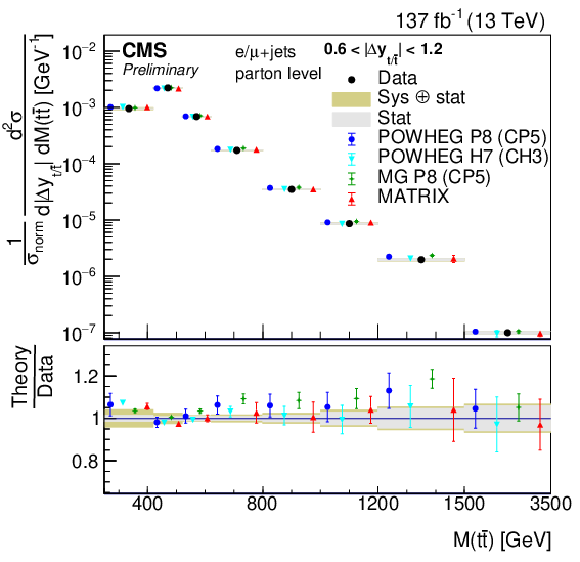
png pdf |
Figure 59-b:
Normalized double differential cross section as function of |Δyt/ˉt| vs M(tˉt). The data are shown as points with light (dark) bands indicating the statistical (statistical and systematic) uncertainties. The cross sections are compared to the predictions of POWHEG combined with PYTHIA (P8) or HERWIG (H7), the multiparton simulation MG5_aMC@NLO (MG5)+PYTHIA FxFx, and the NNLO QCD calculations obtained with Matrix. The ratios of the various predictions to the measured cross sections are shown at the bottom of each panel. |
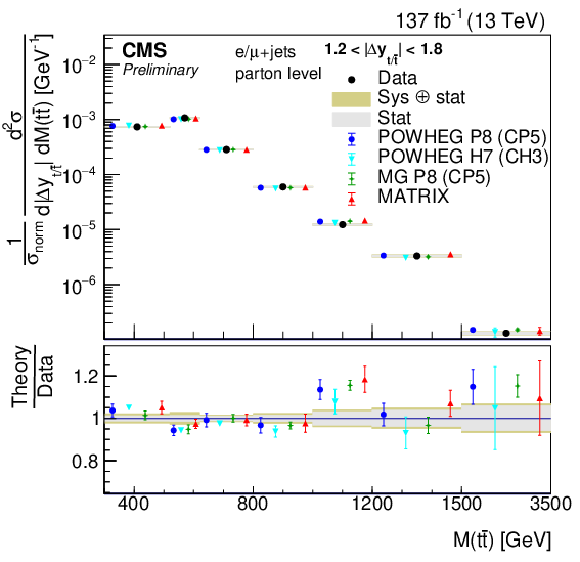
png pdf |
Figure 59-c:
Normalized double differential cross section as function of |Δyt/ˉt| vs M(tˉt). The data are shown as points with light (dark) bands indicating the statistical (statistical and systematic) uncertainties. The cross sections are compared to the predictions of POWHEG combined with PYTHIA (P8) or HERWIG (H7), the multiparton simulation MG5_aMC@NLO (MG5)+PYTHIA FxFx, and the NNLO QCD calculations obtained with Matrix. The ratios of the various predictions to the measured cross sections are shown at the bottom of each panel. |
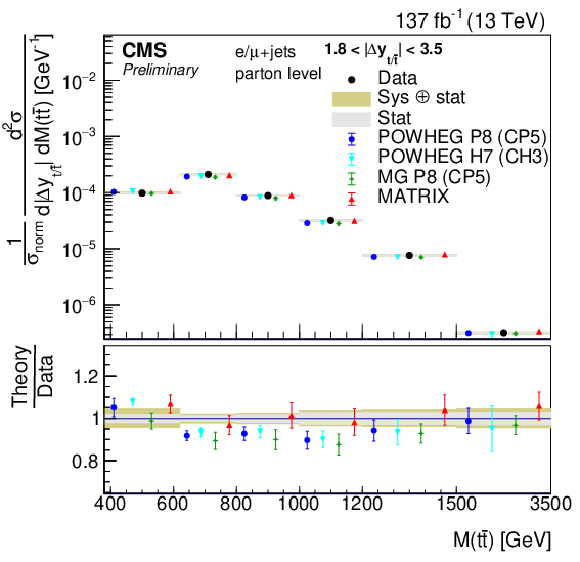
png pdf |
Figure 59-d:
Normalized double differential cross section as function of |Δyt/ˉt| vs M(tˉt). The data are shown as points with light (dark) bands indicating the statistical (statistical and systematic) uncertainties. The cross sections are compared to the predictions of POWHEG combined with PYTHIA (P8) or HERWIG (H7), the multiparton simulation MG5_aMC@NLO (MG5)+PYTHIA FxFx, and the NNLO QCD calculations obtained with Matrix. The ratios of the various predictions to the measured cross sections are shown at the bottom of each panel. |

png pdf |
Figure 60:
Normalized double differential cross section as function of |Δyt/ˉt| vs M(tˉt). The data are shown as points with light (dark) bands indicating the statistical (statistical and systematic) uncertainties. The cross sections are compared to the predictions of POWHEG +PYTHIA (P8) for the CP5 and CUETP8M2T4 (T4), POWHEG +HERWIG (H7), and the multiparton simulation MG5_aMC@NLO (MG)+PYTHIA. The ratios of the various predictions to the measured cross sections are shown at the bottom of each panel. |

png pdf |
Figure 60-a:
Normalized double differential cross section as function of |Δyt/ˉt| vs M(tˉt). The data are shown as points with light (dark) bands indicating the statistical (statistical and systematic) uncertainties. The cross sections are compared to the predictions of POWHEG +PYTHIA (P8) for the CP5 and CUETP8M2T4 (T4), POWHEG +HERWIG (H7), and the multiparton simulation MG5_aMC@NLO (MG)+PYTHIA. The ratios of the various predictions to the measured cross sections are shown at the bottom of each panel. |
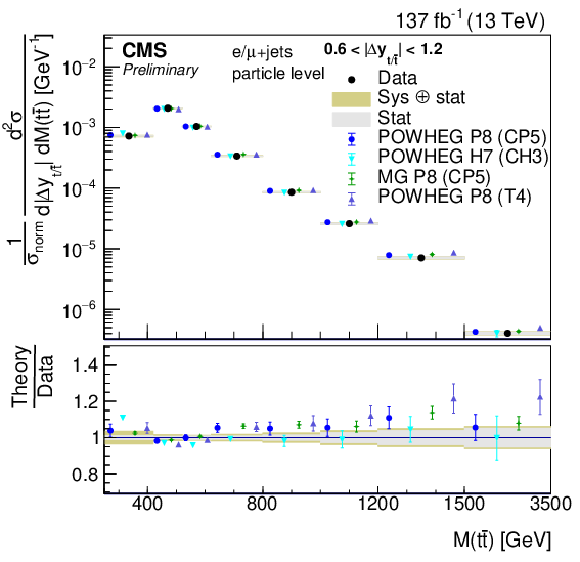
png pdf |
Figure 60-b:
Normalized double differential cross section as function of |Δyt/ˉt| vs M(tˉt). The data are shown as points with light (dark) bands indicating the statistical (statistical and systematic) uncertainties. The cross sections are compared to the predictions of POWHEG +PYTHIA (P8) for the CP5 and CUETP8M2T4 (T4), POWHEG +HERWIG (H7), and the multiparton simulation MG5_aMC@NLO (MG)+PYTHIA. The ratios of the various predictions to the measured cross sections are shown at the bottom of each panel. |
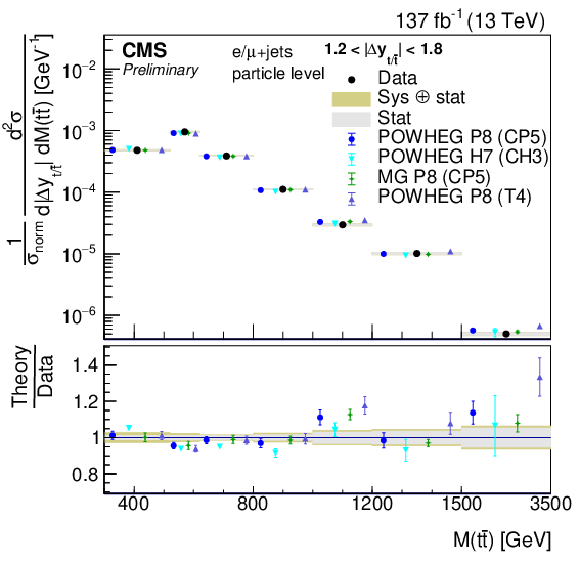
png pdf |
Figure 60-c:
Normalized double differential cross section as function of |Δyt/ˉt| vs M(tˉt). The data are shown as points with light (dark) bands indicating the statistical (statistical and systematic) uncertainties. The cross sections are compared to the predictions of POWHEG +PYTHIA (P8) for the CP5 and CUETP8M2T4 (T4), POWHEG +HERWIG (H7), and the multiparton simulation MG5_aMC@NLO (MG)+PYTHIA. The ratios of the various predictions to the measured cross sections are shown at the bottom of each panel. |
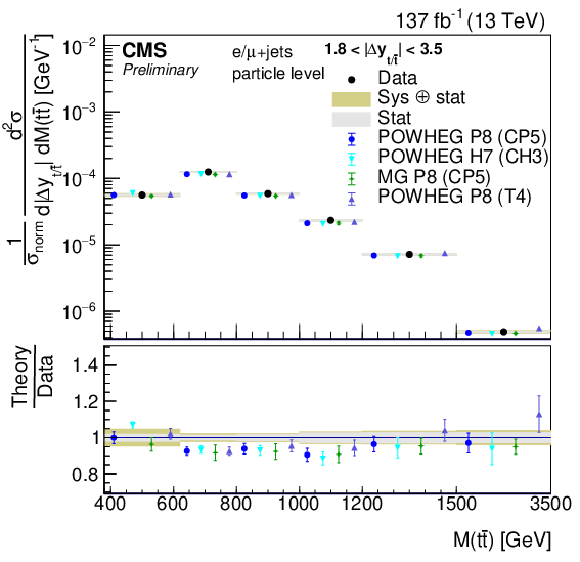
png pdf |
Figure 60-d:
Normalized double differential cross section as function of |Δyt/ˉt| vs M(tˉt). The data are shown as points with light (dark) bands indicating the statistical (statistical and systematic) uncertainties. The cross sections are compared to the predictions of POWHEG +PYTHIA (P8) for the CP5 and CUETP8M2T4 (T4), POWHEG +HERWIG (H7), and the multiparton simulation MG5_aMC@NLO (MG)+PYTHIA. The ratios of the various predictions to the measured cross sections are shown at the bottom of each panel. |

png pdf |
Figure 61:
Normalized double differential cross section as function of M(tˉt) vs Δ|yt/ˉt|. The data are shown as points with light (dark) bands indicating the statistical (statistical and systematic) uncertainties. The cross sections are compared to the predictions of POWHEG combined with PYTHIA (P8) or HERWIG (H7), the multiparton simulation MG5_aMC@NLO (MG5)+PYTHIA FxFx, and the NNLO QCD calculations obtained with Matrix. The ratios of the various predictions to the measured cross sections are shown at the bottom of each panel. |

png pdf |
Figure 61-a:
Normalized double differential cross section as function of M(tˉt) vs Δ|yt/ˉt|. The data are shown as points with light (dark) bands indicating the statistical (statistical and systematic) uncertainties. The cross sections are compared to the predictions of POWHEG combined with PYTHIA (P8) or HERWIG (H7), the multiparton simulation MG5_aMC@NLO (MG5)+PYTHIA FxFx, and the NNLO QCD calculations obtained with Matrix. The ratios of the various predictions to the measured cross sections are shown at the bottom of each panel. |
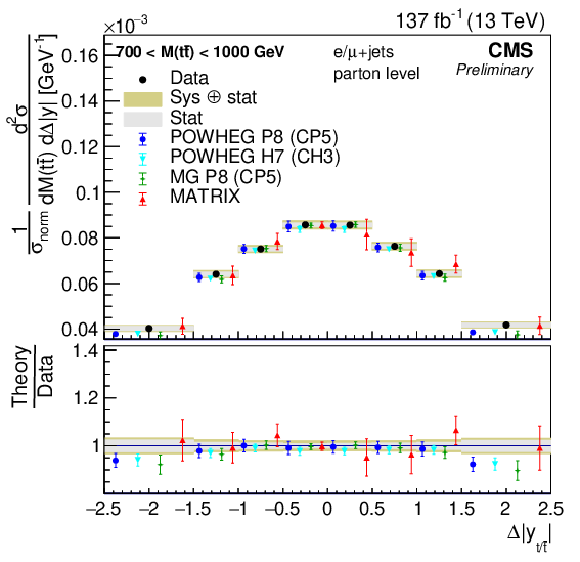
png pdf |
Figure 61-b:
Normalized double differential cross section as function of M(tˉt) vs Δ|yt/ˉt|. The data are shown as points with light (dark) bands indicating the statistical (statistical and systematic) uncertainties. The cross sections are compared to the predictions of POWHEG combined with PYTHIA (P8) or HERWIG (H7), the multiparton simulation MG5_aMC@NLO (MG5)+PYTHIA FxFx, and the NNLO QCD calculations obtained with Matrix. The ratios of the various predictions to the measured cross sections are shown at the bottom of each panel. |

png pdf |
Figure 61-c:
Normalized double differential cross section as function of M(tˉt) vs Δ|yt/ˉt|. The data are shown as points with light (dark) bands indicating the statistical (statistical and systematic) uncertainties. The cross sections are compared to the predictions of POWHEG combined with PYTHIA (P8) or HERWIG (H7), the multiparton simulation MG5_aMC@NLO (MG5)+PYTHIA FxFx, and the NNLO QCD calculations obtained with Matrix. The ratios of the various predictions to the measured cross sections are shown at the bottom of each panel. |

png pdf |
Figure 62:
Normalized double differential cross section as function of M(tˉt) vs Δ|yt/ˉt|. The data are shown as points with light (dark) bands indicating the statistical (statistical and systematic) uncertainties. The cross sections are compared to the predictions of POWHEG +PYTHIA (P8) for the CP5 and CUETP8M2T4 (T4), POWHEG +HERWIG (H7), and the multiparton simulation MG5_aMC@NLO (MG)+PYTHIA. The ratios of the various predictions to the measured cross sections are shown at the bottom of each panel. |

png pdf |
Figure 62-a:
Normalized double differential cross section as function of M(tˉt) vs Δ|yt/ˉt|. The data are shown as points with light (dark) bands indicating the statistical (statistical and systematic) uncertainties. The cross sections are compared to the predictions of POWHEG +PYTHIA (P8) for the CP5 and CUETP8M2T4 (T4), POWHEG +HERWIG (H7), and the multiparton simulation MG5_aMC@NLO (MG)+PYTHIA. The ratios of the various predictions to the measured cross sections are shown at the bottom of each panel. |
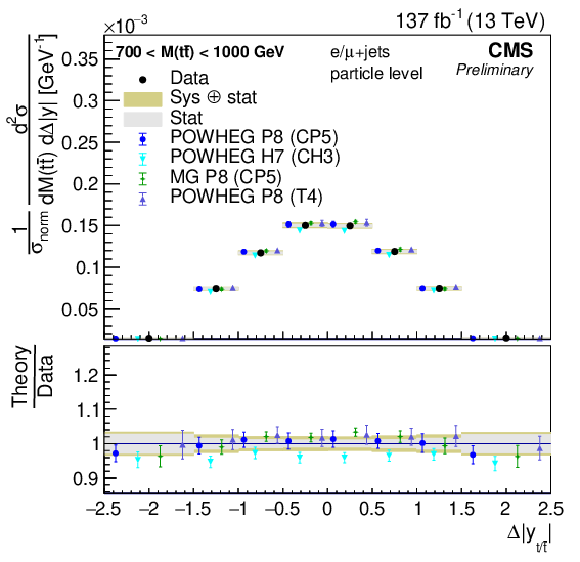
png pdf |
Figure 62-b:
Normalized double differential cross section as function of M(tˉt) vs Δ|yt/ˉt|. The data are shown as points with light (dark) bands indicating the statistical (statistical and systematic) uncertainties. The cross sections are compared to the predictions of POWHEG +PYTHIA (P8) for the CP5 and CUETP8M2T4 (T4), POWHEG +HERWIG (H7), and the multiparton simulation MG5_aMC@NLO (MG)+PYTHIA. The ratios of the various predictions to the measured cross sections are shown at the bottom of each panel. |

png pdf |
Figure 62-c:
Normalized double differential cross section as function of M(tˉt) vs Δ|yt/ˉt|. The data are shown as points with light (dark) bands indicating the statistical (statistical and systematic) uncertainties. The cross sections are compared to the predictions of POWHEG +PYTHIA (P8) for the CP5 and CUETP8M2T4 (T4), POWHEG +HERWIG (H7), and the multiparton simulation MG5_aMC@NLO (MG)+PYTHIA. The ratios of the various predictions to the measured cross sections are shown at the bottom of each panel. |

png pdf |
Figure 63:
Normalized double differential cross section as function of |y(t)| vs |y(ˉt)|. The data are shown as points with light (dark) bands indicating the statistical (statistical and systematic) uncertainties. The cross sections are compared to the predictions of POWHEG combined with PYTHIA (P8) or HERWIG (H7), the multiparton simulation MG5_aMC@NLO (MG5)+PYTHIA FxFx, and the NNLO QCD calculations obtained with Matrix. The ratios of the various predictions to the measured cross sections are shown at the bottom of each panel. |

png pdf |
Figure 63-a:
Normalized double differential cross section as function of |y(t)| vs |y(ˉt)|. The data are shown as points with light (dark) bands indicating the statistical (statistical and systematic) uncertainties. The cross sections are compared to the predictions of POWHEG combined with PYTHIA (P8) or HERWIG (H7), the multiparton simulation MG5_aMC@NLO (MG5)+PYTHIA FxFx, and the NNLO QCD calculations obtained with Matrix. The ratios of the various predictions to the measured cross sections are shown at the bottom of each panel. |

png pdf |
Figure 63-b:
Normalized double differential cross section as function of |y(t)| vs |y(ˉt)|. The data are shown as points with light (dark) bands indicating the statistical (statistical and systematic) uncertainties. The cross sections are compared to the predictions of POWHEG combined with PYTHIA (P8) or HERWIG (H7), the multiparton simulation MG5_aMC@NLO (MG5)+PYTHIA FxFx, and the NNLO QCD calculations obtained with Matrix. The ratios of the various predictions to the measured cross sections are shown at the bottom of each panel. |

png pdf |
Figure 63-c:
Normalized double differential cross section as function of |y(t)| vs |y(ˉt)|. The data are shown as points with light (dark) bands indicating the statistical (statistical and systematic) uncertainties. The cross sections are compared to the predictions of POWHEG combined with PYTHIA (P8) or HERWIG (H7), the multiparton simulation MG5_aMC@NLO (MG5)+PYTHIA FxFx, and the NNLO QCD calculations obtained with Matrix. The ratios of the various predictions to the measured cross sections are shown at the bottom of each panel. |

png pdf |
Figure 63-d:
Normalized double differential cross section as function of |y(t)| vs |y(ˉt)|. The data are shown as points with light (dark) bands indicating the statistical (statistical and systematic) uncertainties. The cross sections are compared to the predictions of POWHEG combined with PYTHIA (P8) or HERWIG (H7), the multiparton simulation MG5_aMC@NLO (MG5)+PYTHIA FxFx, and the NNLO QCD calculations obtained with Matrix. The ratios of the various predictions to the measured cross sections are shown at the bottom of each panel. |

png pdf |
Figure 63-e:
Normalized double differential cross section as function of |y(t)| vs |y(ˉt)|. The data are shown as points with light (dark) bands indicating the statistical (statistical and systematic) uncertainties. The cross sections are compared to the predictions of POWHEG combined with PYTHIA (P8) or HERWIG (H7), the multiparton simulation MG5_aMC@NLO (MG5)+PYTHIA FxFx, and the NNLO QCD calculations obtained with Matrix. The ratios of the various predictions to the measured cross sections are shown at the bottom of each panel. |
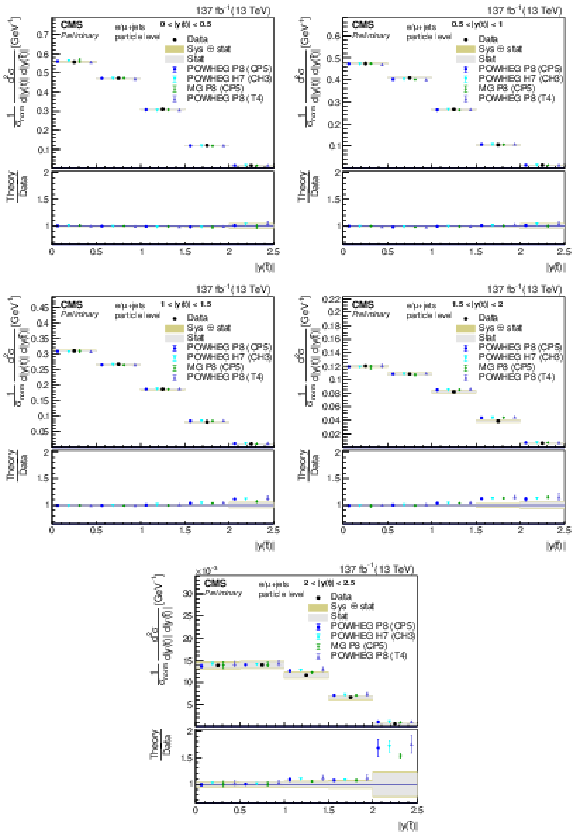
png pdf |
Figure 64:
Normalized double differential cross section as function of |y(t)| vs |y(ˉt)|. The data are shown as points with light (dark) bands indicating the statistical (statistical and systematic) uncertainties. The cross sections are compared to the predictions of POWHEG +PYTHIA (P8) for the CP5 and CUETP8M2T4 (T4), POWHEG +HERWIG (H7), and the multiparton simulation MG5_aMC@NLO (MG)+PYTHIA. The ratios of the various predictions to the measured cross sections are shown at the bottom of each panel. |

png pdf |
Figure 64-a:
Normalized double differential cross section as function of |y(t)| vs |y(ˉt)|. The data are shown as points with light (dark) bands indicating the statistical (statistical and systematic) uncertainties. The cross sections are compared to the predictions of POWHEG +PYTHIA (P8) for the CP5 and CUETP8M2T4 (T4), POWHEG +HERWIG (H7), and the multiparton simulation MG5_aMC@NLO (MG)+PYTHIA. The ratios of the various predictions to the measured cross sections are shown at the bottom of each panel. |

png pdf |
Figure 64-b:
Normalized double differential cross section as function of |y(t)| vs |y(ˉt)|. The data are shown as points with light (dark) bands indicating the statistical (statistical and systematic) uncertainties. The cross sections are compared to the predictions of POWHEG +PYTHIA (P8) for the CP5 and CUETP8M2T4 (T4), POWHEG +HERWIG (H7), and the multiparton simulation MG5_aMC@NLO (MG)+PYTHIA. The ratios of the various predictions to the measured cross sections are shown at the bottom of each panel. |
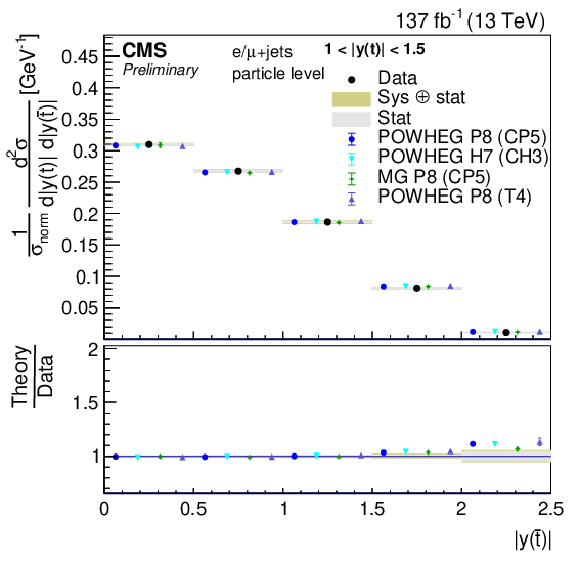
png pdf |
Figure 64-c:
Normalized double differential cross section as function of |y(t)| vs |y(ˉt)|. The data are shown as points with light (dark) bands indicating the statistical (statistical and systematic) uncertainties. The cross sections are compared to the predictions of POWHEG +PYTHIA (P8) for the CP5 and CUETP8M2T4 (T4), POWHEG +HERWIG (H7), and the multiparton simulation MG5_aMC@NLO (MG)+PYTHIA. The ratios of the various predictions to the measured cross sections are shown at the bottom of each panel. |

png pdf |
Figure 64-d:
Normalized double differential cross section as function of |y(t)| vs |y(ˉt)|. The data are shown as points with light (dark) bands indicating the statistical (statistical and systematic) uncertainties. The cross sections are compared to the predictions of POWHEG +PYTHIA (P8) for the CP5 and CUETP8M2T4 (T4), POWHEG +HERWIG (H7), and the multiparton simulation MG5_aMC@NLO (MG)+PYTHIA. The ratios of the various predictions to the measured cross sections are shown at the bottom of each panel. |

png pdf |
Figure 64-e:
Normalized double differential cross section as function of |y(t)| vs |y(ˉt)|. The data are shown as points with light (dark) bands indicating the statistical (statistical and systematic) uncertainties. The cross sections are compared to the predictions of POWHEG +PYTHIA (P8) for the CP5 and CUETP8M2T4 (T4), POWHEG +HERWIG (H7), and the multiparton simulation MG5_aMC@NLO (MG)+PYTHIA. The ratios of the various predictions to the measured cross sections are shown at the bottom of each panel. |

png pdf |
Figure 65:
Normalized differential cross sections as functions of pT(ℓ), jet multiplicity, HT, and Mevt. The data are shown as points with light (dark) bands indicating the statistical (statistical and systematic) uncertainties. The cross sections are compared to the predictions of POWHEG +PYTHIA (P8) for the CP5 and CUETP8M2T4 (T4), POWHEG +HERWIG (H7), and the multiparton simulation MG5_aMC@NLO (MG)+PYTHIA. The ratios of the various predictions to the measured cross sections are shown at the bottom of each panel. |

png pdf |
Figure 65-a:
Normalized differential cross sections as functions of pT(ℓ), jet multiplicity, HT, and Mevt. The data are shown as points with light (dark) bands indicating the statistical (statistical and systematic) uncertainties. The cross sections are compared to the predictions of POWHEG +PYTHIA (P8) for the CP5 and CUETP8M2T4 (T4), POWHEG +HERWIG (H7), and the multiparton simulation MG5_aMC@NLO (MG)+PYTHIA. The ratios of the various predictions to the measured cross sections are shown at the bottom of each panel. |
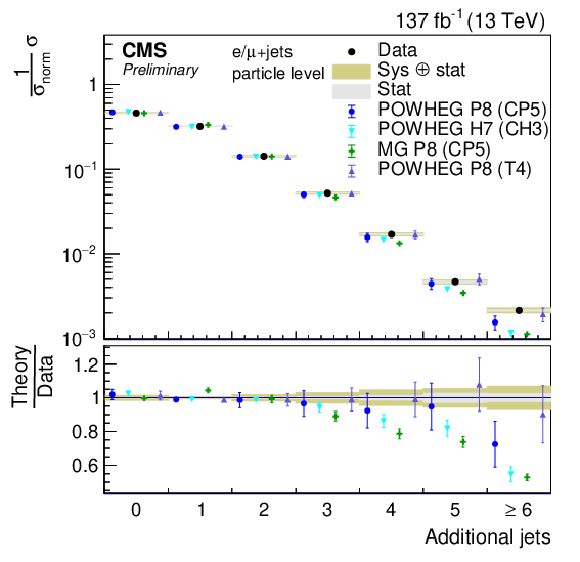
png pdf |
Figure 65-b:
Normalized differential cross sections as functions of pT(ℓ), jet multiplicity, HT, and Mevt. The data are shown as points with light (dark) bands indicating the statistical (statistical and systematic) uncertainties. The cross sections are compared to the predictions of POWHEG +PYTHIA (P8) for the CP5 and CUETP8M2T4 (T4), POWHEG +HERWIG (H7), and the multiparton simulation MG5_aMC@NLO (MG)+PYTHIA. The ratios of the various predictions to the measured cross sections are shown at the bottom of each panel. |

png pdf |
Figure 65-c:
Normalized differential cross sections as functions of pT(ℓ), jet multiplicity, HT, and Mevt. The data are shown as points with light (dark) bands indicating the statistical (statistical and systematic) uncertainties. The cross sections are compared to the predictions of POWHEG +PYTHIA (P8) for the CP5 and CUETP8M2T4 (T4), POWHEG +HERWIG (H7), and the multiparton simulation MG5_aMC@NLO (MG)+PYTHIA. The ratios of the various predictions to the measured cross sections are shown at the bottom of each panel. |

png pdf |
Figure 65-d:
Normalized differential cross sections as functions of pT(ℓ), jet multiplicity, HT, and Mevt. The data are shown as points with light (dark) bands indicating the statistical (statistical and systematic) uncertainties. The cross sections are compared to the predictions of POWHEG +PYTHIA (P8) for the CP5 and CUETP8M2T4 (T4), POWHEG +HERWIG (H7), and the multiparton simulation MG5_aMC@NLO (MG)+PYTHIA. The ratios of the various predictions to the measured cross sections are shown at the bottom of each panel. |
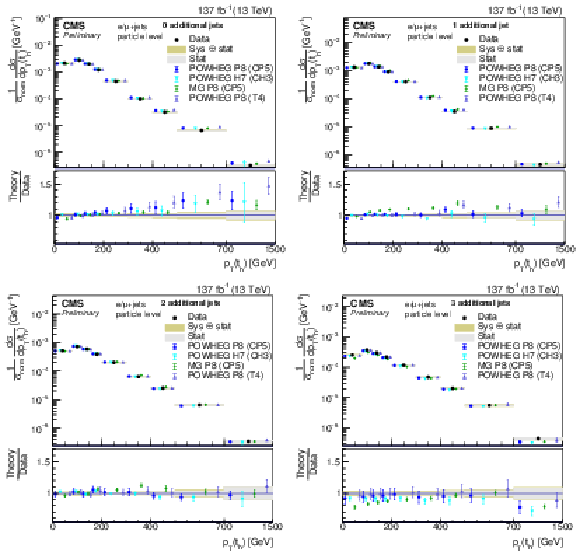
png pdf |
Figure 66:
Normalized differential cross section as function of pT(th) in bins of jet multiplicity. The data are shown as points with light (dark) bands indicating the statistical (statistical and systematic) uncertainties. The cross sections are compared to the predictions of POWHEG +PYTHIA (P8) for the CP5 and CUETP8M2T4 (T4), POWHEG +HERWIG (H7), and the multiparton simulation MG5_aMC@NLO (MG)+PYTHIA. The ratios of the various predictions to the measured cross sections are shown at the bottom of each panel. |
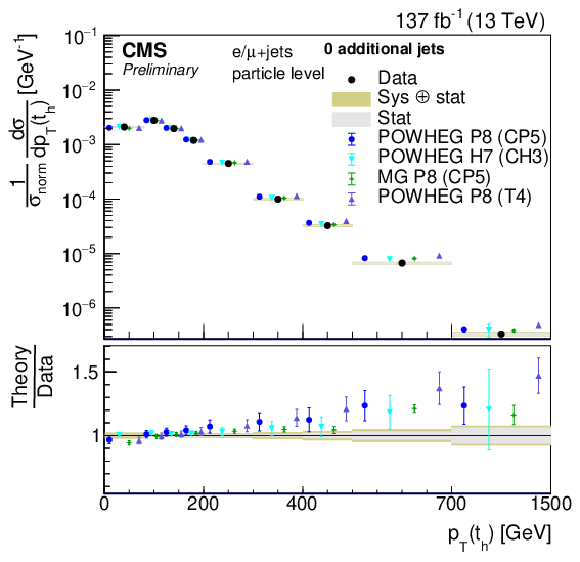
png pdf |
Figure 66-a:
Normalized differential cross section as function of pT(th) in bins of jet multiplicity. The data are shown as points with light (dark) bands indicating the statistical (statistical and systematic) uncertainties. The cross sections are compared to the predictions of POWHEG +PYTHIA (P8) for the CP5 and CUETP8M2T4 (T4), POWHEG +HERWIG (H7), and the multiparton simulation MG5_aMC@NLO (MG)+PYTHIA. The ratios of the various predictions to the measured cross sections are shown at the bottom of each panel. |

png pdf |
Figure 66-b:
Normalized differential cross section as function of pT(th) in bins of jet multiplicity. The data are shown as points with light (dark) bands indicating the statistical (statistical and systematic) uncertainties. The cross sections are compared to the predictions of POWHEG +PYTHIA (P8) for the CP5 and CUETP8M2T4 (T4), POWHEG +HERWIG (H7), and the multiparton simulation MG5_aMC@NLO (MG)+PYTHIA. The ratios of the various predictions to the measured cross sections are shown at the bottom of each panel. |

png pdf |
Figure 66-c:
Normalized differential cross section as function of pT(th) in bins of jet multiplicity. The data are shown as points with light (dark) bands indicating the statistical (statistical and systematic) uncertainties. The cross sections are compared to the predictions of POWHEG +PYTHIA (P8) for the CP5 and CUETP8M2T4 (T4), POWHEG +HERWIG (H7), and the multiparton simulation MG5_aMC@NLO (MG)+PYTHIA. The ratios of the various predictions to the measured cross sections are shown at the bottom of each panel. |
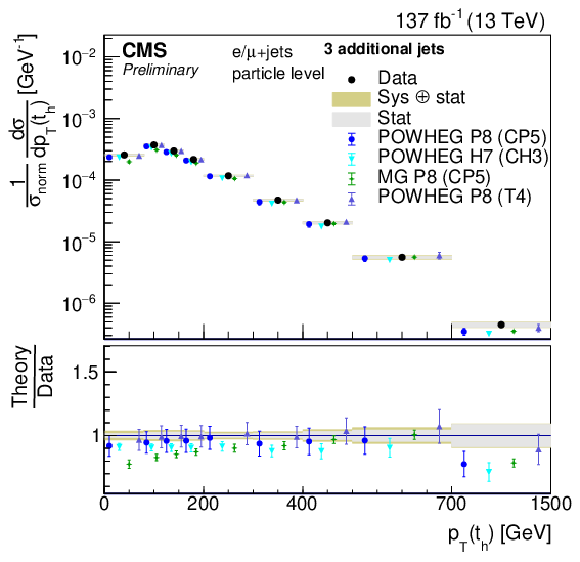
png pdf |
Figure 66-d:
Normalized differential cross section as function of pT(th) in bins of jet multiplicity. The data are shown as points with light (dark) bands indicating the statistical (statistical and systematic) uncertainties. The cross sections are compared to the predictions of POWHEG +PYTHIA (P8) for the CP5 and CUETP8M2T4 (T4), POWHEG +HERWIG (H7), and the multiparton simulation MG5_aMC@NLO (MG)+PYTHIA. The ratios of the various predictions to the measured cross sections are shown at the bottom of each panel. |

png pdf |
Figure 67:
Normalized differential cross section as function of M(tˉt) in bins of jet multiplicity. The data are shown as points with light (dark) bands indicating the statistical (statistical and systematic) uncertainties. The cross sections are compared to the predictions of POWHEG +PYTHIA (P8) for the CP5 and CUETP8M2T4 (T4), POWHEG +HERWIG (H7), and the multiparton simulation MG5_aMC@NLO (MG)+PYTHIA. The ratios of the various predictions to the measured cross sections are shown at the bottom of each panel. |

png pdf |
Figure 67-a:
Normalized differential cross section as function of M(tˉt) in bins of jet multiplicity. The data are shown as points with light (dark) bands indicating the statistical (statistical and systematic) uncertainties. The cross sections are compared to the predictions of POWHEG +PYTHIA (P8) for the CP5 and CUETP8M2T4 (T4), POWHEG +HERWIG (H7), and the multiparton simulation MG5_aMC@NLO (MG)+PYTHIA. The ratios of the various predictions to the measured cross sections are shown at the bottom of each panel. |
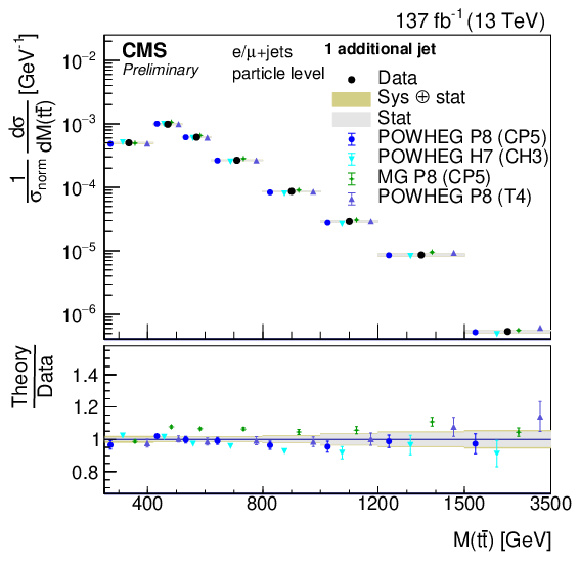
png pdf |
Figure 67-b:
Normalized differential cross section as function of M(tˉt) in bins of jet multiplicity. The data are shown as points with light (dark) bands indicating the statistical (statistical and systematic) uncertainties. The cross sections are compared to the predictions of POWHEG +PYTHIA (P8) for the CP5 and CUETP8M2T4 (T4), POWHEG +HERWIG (H7), and the multiparton simulation MG5_aMC@NLO (MG)+PYTHIA. The ratios of the various predictions to the measured cross sections are shown at the bottom of each panel. |

png pdf |
Figure 67-c:
Normalized differential cross section as function of M(tˉt) in bins of jet multiplicity. The data are shown as points with light (dark) bands indicating the statistical (statistical and systematic) uncertainties. The cross sections are compared to the predictions of POWHEG +PYTHIA (P8) for the CP5 and CUETP8M2T4 (T4), POWHEG +HERWIG (H7), and the multiparton simulation MG5_aMC@NLO (MG)+PYTHIA. The ratios of the various predictions to the measured cross sections are shown at the bottom of each panel. |

png pdf |
Figure 67-d:
Normalized differential cross section as function of M(tˉt) in bins of jet multiplicity. The data are shown as points with light (dark) bands indicating the statistical (statistical and systematic) uncertainties. The cross sections are compared to the predictions of POWHEG +PYTHIA (P8) for the CP5 and CUETP8M2T4 (T4), POWHEG +HERWIG (H7), and the multiparton simulation MG5_aMC@NLO (MG)+PYTHIA. The ratios of the various predictions to the measured cross sections are shown at the bottom of each panel. |
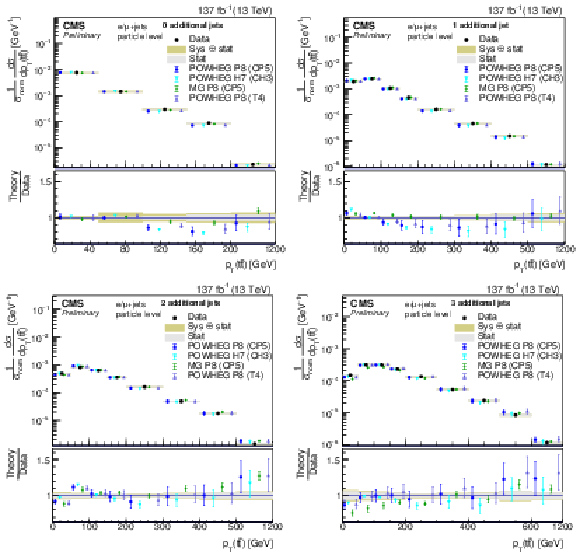
png pdf |
Figure 68:
Normalized differential cross section as function of {{p_{\mathrm {T}}} ({\mathrm{t} \mathrm{\bar{t}}})} in bins of jet multiplicity. The data are shown as points with light (dark) bands indicating the statistical (statistical and systematic) uncertainties. The cross sections are compared to the predictions of POWHEG +PYTHIA (P8) for the CP5 and CUETP8M2T4 (T4), POWHEG +HERWIG (H7), and the multiparton simulation MG5_aMC@NLO (MG)+PYTHIA. The ratios of the various predictions to the measured cross sections are shown at the bottom of each panel. |
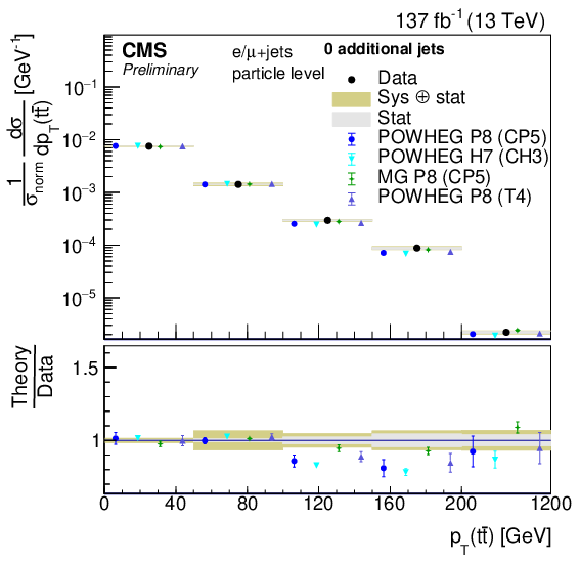
png pdf |
Figure 68-a:
Normalized differential cross section as function of {{p_{\mathrm {T}}} ({\mathrm{t} \mathrm{\bar{t}}})} in bins of jet multiplicity. The data are shown as points with light (dark) bands indicating the statistical (statistical and systematic) uncertainties. The cross sections are compared to the predictions of POWHEG +PYTHIA (P8) for the CP5 and CUETP8M2T4 (T4), POWHEG +HERWIG (H7), and the multiparton simulation MG5_aMC@NLO (MG)+PYTHIA. The ratios of the various predictions to the measured cross sections are shown at the bottom of each panel. |
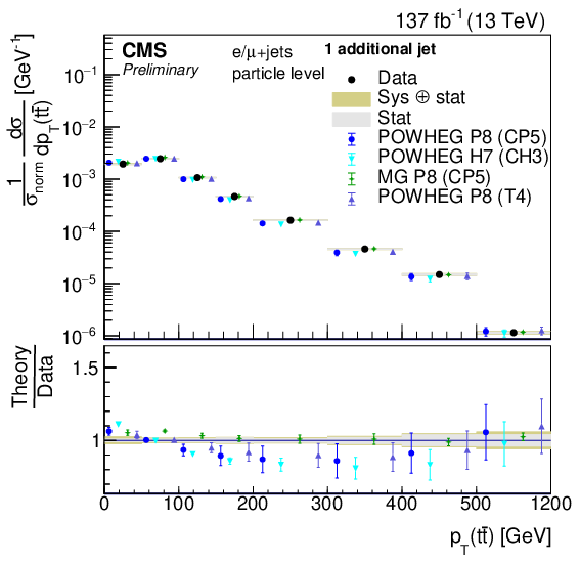
png pdf |
Figure 68-b:
Normalized differential cross section as function of {{p_{\mathrm {T}}} ({\mathrm{t} \mathrm{\bar{t}}})} in bins of jet multiplicity. The data are shown as points with light (dark) bands indicating the statistical (statistical and systematic) uncertainties. The cross sections are compared to the predictions of POWHEG +PYTHIA (P8) for the CP5 and CUETP8M2T4 (T4), POWHEG +HERWIG (H7), and the multiparton simulation MG5_aMC@NLO (MG)+PYTHIA. The ratios of the various predictions to the measured cross sections are shown at the bottom of each panel. |

png pdf |
Figure 68-c:
Normalized differential cross section as function of {{p_{\mathrm {T}}} ({\mathrm{t} \mathrm{\bar{t}}})} in bins of jet multiplicity. The data are shown as points with light (dark) bands indicating the statistical (statistical and systematic) uncertainties. The cross sections are compared to the predictions of POWHEG +PYTHIA (P8) for the CP5 and CUETP8M2T4 (T4), POWHEG +HERWIG (H7), and the multiparton simulation MG5_aMC@NLO (MG)+PYTHIA. The ratios of the various predictions to the measured cross sections are shown at the bottom of each panel. |

png pdf |
Figure 68-d:
Normalized differential cross section as function of {{p_{\mathrm {T}}} ({\mathrm{t} \mathrm{\bar{t}}})} in bins of jet multiplicity. The data are shown as points with light (dark) bands indicating the statistical (statistical and systematic) uncertainties. The cross sections are compared to the predictions of POWHEG +PYTHIA (P8) for the CP5 and CUETP8M2T4 (T4), POWHEG +HERWIG (H7), and the multiparton simulation MG5_aMC@NLO (MG)+PYTHIA. The ratios of the various predictions to the measured cross sections are shown at the bottom of each panel. |

png pdf |
Figure 69:
Results of \chi ^2 tests in standard deviation (SD) comparing the measured normalized cross sections at the parton (upper) and particle (lower) level to various predictions. The p-values above 0.5 correspond to a positive SD and below 0.5 to a negative SD. The uncertainties in the measurements and the predictions are taken into account. |
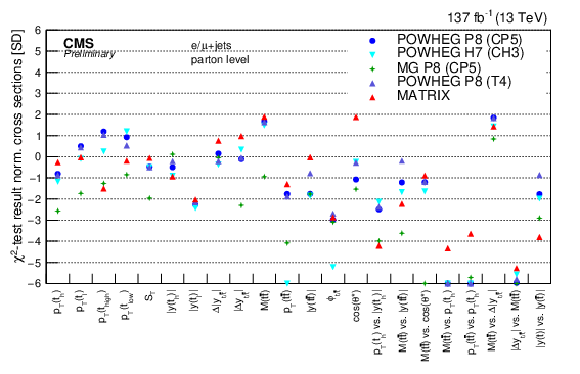
png pdf |
Figure 69-a:
Results of \chi ^2 tests in standard deviation (SD) comparing the measured normalized cross sections at the parton (upper) and particle (lower) level to various predictions. The p-values above 0.5 correspond to a positive SD and below 0.5 to a negative SD. The uncertainties in the measurements and the predictions are taken into account. |

png pdf |
Figure 69-b:
Results of \chi ^2 tests in standard deviation (SD) comparing the measured normalized cross sections at the parton (upper) and particle (lower) level to various predictions. The p-values above 0.5 correspond to a positive SD and below 0.5 to a negative SD. The uncertainties in the measurements and the predictions are taken into account. |
| Tables | |
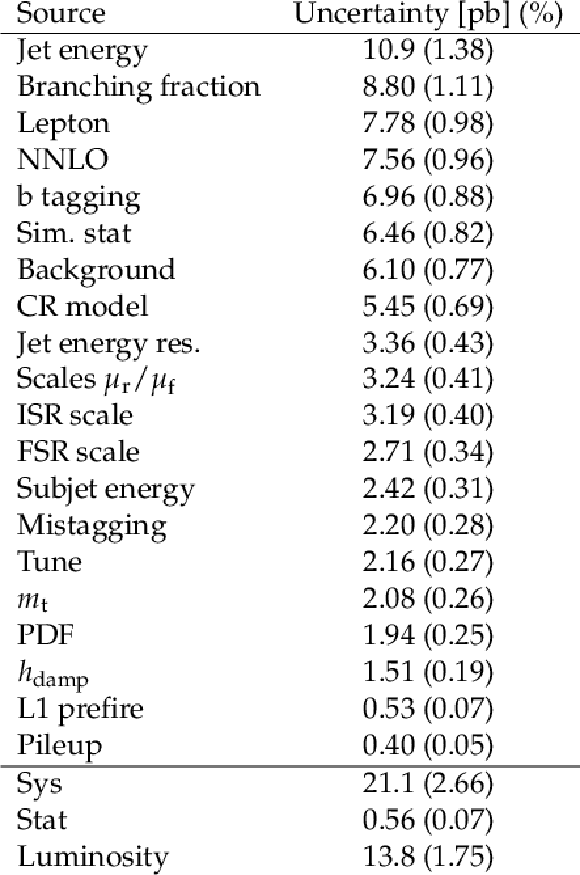
png pdf |
Table 1:
Systematic uncertainties in the measurement of \sigma _\mathrm {tot}. |

png pdf |
Table 2:
Systematic uncertainties in the measurement of \sigma _\mathrm {particle}. |
| Summary |
|
A measurement of the differential and double differential \mathrm{t\bar{t}} production cross sections was presented as functions of many kinematic properties of the top quarks and the \mathrm{t\bar{t}} system at the parton and particle level. In addition, the number of additional jets and kinematic variables in bins of jet multiplicities have been measured at the particle level. The data correspond to an integrated luminosity of 137 fb^{-1} recorded by the CMS experiment. The \mathrm{t\bar{t}} cross sections are measured in the e/\mu+jets channels. For the first time the cross section of the full spectra are obtained using a combination of resolved and boosted \mathrm{t\bar{t}} topologies. The combination of multiple reconstruction categories allows for constraints of systematic uncertainties and results in a significantly improved precision with respect to previous measurements. Uncertainties in the jet energy scale, luminosity, and \mathrm{t\bar{t}} modeling are the dominant sources. In general, most differential distributions are found to be compatible with the SM predictions of POWHEG +PYTHIAA, POWHEG +HERWIG, and mg5_aMC@NLO +PYTHIAA. In addition, the parton-level cross sections are compared to the NNLO QCD calculations obtained with Matrix that comes with a significantly reduced theoretical uncertainty. A softer top quark {p_{\mathrm{T}}} spectrum is observed compared to most of the NLO predictions. Deviations between the predictions and data are observed when the top quark {p_{\mathrm{T}}} is measured in bins of {M(\mathrm{t\bar{t}})} and {{p_{\mathrm{T}}}(\mathrm{t\bar{t}})}. The simulation by POWHEG +HERWIG and mg5_aMC@NLO +PYTHIAA have problems to describe the jet multiplicities and related observables like {H_\mathrm{T}}. The measured inclusive \mathrm{t\bar{t}} production cross section is |
| References | ||||
| 1 | CMS Collaboration | Measurement of \mathrm{t\bar{t}} normalised multi-differential cross sections in pp collisions at \sqrt{s} = 13 TeV and simultaneous determination of the strong coupling strength, top quark pole mass, and parton distribution functions | EPJC 80 (2020) 658 | CMS-TOP-18-004 1904.05237 |
| 2 | CMS Collaboration | Measurement of differential top-quark pair production cross sections in pp collisions at \sqrt{s}= 7 TeV | EPJC 73 (2013) 2339 | CMS-TOP-11-013 1211.2220 |
| 3 | ATLAS Collaboration | Differential top-antitop cross-section measurements as a function of observables constructed from final-state particles using pp collisions at \sqrt{s}= 7 TeV in the ATLAS detector | JHEP 06 (2015) 100 | 1502.05923 |
| 4 | CMS Collaboration | Measurement of the differential cross section for top quark pair production in pp collisions at \sqrt{s} = 8 TeV | EPJC 75 (2015) 542 | CMS-TOP-12-028 1505.04480 |
| 5 | ATLAS Collaboration | Measurements of top-quark pair differential cross-sections in the lepton+jets channel in pp collisions at \sqrt{s}= 8 TeV using the ATLAS detector | EPJC 76 (2016) 538 | 1511.04716 |
| 6 | ATLAS Collaboration | Measurement of the differential cross-section of highly boosted top quarks as a function of their transverse momentum in \sqrt{s} = 8 TeV proton-proton collisions using the ATLAS detector | PRD 93 (2016) 032009 | 1510.03818 |
| 7 | CMS Collaboration | Measurement of the \mathrm{t\bar{t}} production cross section in the all-jets final state in pp collisions at \sqrt{s}= 8 TeV | EPJC 76 (2016) 128 | CMS-TOP-14-018 1509.06076 |
| 8 | CMS Collaboration | Measurement of the integrated and differential \mathrm{t \bar{t}} production cross sections for high- p_{\mathrm{T}} top quarks in pp collisions at \sqrt{s} = 8 TeV | PRD 94 (2016) 072002 | CMS-TOP-14-012 1605.00116 |
| 9 | ATLAS Collaboration | Measurement of top quark pair differential cross-sections in the dilepton channel in pp collisions at \sqrt{s} = 7 and 8 TeV with ATLAS | PRD 94 (2016) 092003 | 1607.07281 |
| 10 | CMS Collaboration | Measurement of double-differential cross sections for top quark pair production in pp collisions at \sqrt{s} = 8 TeV and impact on parton distribution functions | EPJC 77 (2017) 459 | CMS-TOP-14-013 1703.01630 |
| 11 | ATLAS Collaboration | Measurement of jet activity produced in top-quark events with an electron, a muon and two b-tagged jets in the final state in pp collisions at \sqrt{s}= 13 TeV with the ATLAS detector | EPJC 77 (2017) 220 | 1610.09978 |
| 12 | ATLAS Collaboration | Measurements of top-quark pair differential cross-sections in the e \mu channel in pp collisions at \sqrt{s} = 13 TeV using the ATLAS detector | EPJC 77 (2017) 292 | 1612.05220 |
| 13 | CMS Collaboration | Measurement of normalized differential \mathrm{t \bar{t}} cross sections in the dilepton channel from pp collisions at \sqrt{s} = 13 TeV | JHEP 04 (2018) 60 | CMS-TOP-16-007 1708.07638 |
| 14 | CMS Collaboration | Measurement of differential cross sections for top quark pair production using the lepton+jets final state in proton-proton collisions at 13 TeV | PRD 95 (2017) 092001 | CMS-TOP-16-008 1610.04191 |
| 15 | CMS Collaboration | Measurement of differential cross sections for the production of top quark pairs and of additional jets in lepton+jets events from pp collisions at 13 TeV | PRD 97 (2018) 112003 | CMS-TOP-17-002 1803.08856 |
| 16 | ATLAS Collaboration | Measurements of \mathrm{t\bar{t}} differential cross-sections of highly boosted top quarks decaying to all-hadronic final states in pp collisions at \sqrt{s}= 13 TeV using the ATLAS detector | PRD 98 (2018) 012003 | 1801.02052 |
| 17 | ATLAS Collaboration | Measurements of top-quark pair differential and double-differential cross-sections in the \ell +jets channel with pp collisions at \sqrt{s}= 13 TeV using the ATLAS detector | EPJC 79 (2019) 1028 | 1908.07305 |
| 18 | ATLAS Collaboration | Measurement of the \mathrm{t\bar{t}} production cross-section and lepton differential distributions in e\mu dilepton events from pp collisions at \sqrt{s}= 13 TeV with the ATLAS detector | EPJC 80 (2020) 528 | 1910.08819 |
| 19 | P. Nason | A new method for combining NLO QCD with shower Monte Carlo algorithms | JHEP 11 (2004) 40 | hep-ph/0409146 |
| 20 | S. Frixione, P. Nason, and C. Oleari | Matching NLO QCD computations with parton shower simulations: the POWHEG method | JHEP 11 (2007) 70 | 0709.2092 |
| 21 | S. Alioli, P. Nason, C. Oleari, and E. Re | A general framework for implementing NLO calculations in shower Monte Carlo programs: the POWHEG BOX | JHEP 06 (2010) 043 | 1002.2581 |
| 22 | S. Frixione, P. Nason, and G. Ridolfi | A Positive-weight next-to-leading-order Monte Carlo for heavy flavour hadroproduction | JHEP 09 (2007) 126 | 0707.3088 |
| 23 | T. Sjostrand, S. Mrenna, and P. Skands | PYTHIA 6.4 physics and manual | JHEP 05 (2006) 026 | hep-ph/0603175 |
| 24 | T. Sjostrand, S. Mrenna, and P. Skands | A brief introduction to PYTHIA 8.1 | CPC 178 (2008) 852 | 0710.3820 |
| 25 | P. Skands, S. Carrazza, and J. Rojo | Tuning PYTHIA 8.1: the Monash 2013 tune | EPJC 74 (2014) 3024 | 1404.5630 |
| 26 | CMS Collaboration | Investigations of the impact of the parton shower tuning in PYTHIA 8 in the modelling of \mathrm{t\overline{t}} at \sqrt{s}= 8 and 13 TeV | CMS-PAS-TOP-16-021 | CMS-PAS-TOP-16-021 |
| 27 | CMS Collaboration | Extraction and validation of a new set of CMS Pythia8 tunes from underlying-event measurements | EPJC 80 (2020) 4 | CMS-GEN-17-001 1903.12179 |
| 28 | NNPDF Collaboration | Parton distributions for the LHC Run II | JHEP 04 (2015) 040 | 1410.8849 |
| 29 | NNPDF Collaboration | Parton distributions from high-precision collider data | EPJC 77 (2017) 663 | 1706.00428 |
| 30 | GEANT4 Collaboration | GEANT4--a simulation toolkit | NIMA 506 (2003) 250 | |
| 31 | M. Bahr et al. | HERWIG++ physics and manual | EPJC 58 (2008) 639 | 0803.0883 |
| 32 | CMS Collaboration | Development and validation of HERWIG 7 tunes from CMS underlying-event measurements | Submitted to \it EPJC | CMS-GEN-19-001 2011.03422 |
| 33 | J. Alwall et al. | The automated computation of tree-level and next-to-leading order differential cross sections, and their matching to parton shower simulations | JHEP 07 (2014) 079 | 1405.0301 |
| 34 | R. Frederix and S. Frixione | Merging meets matching in MC@NLO | JHEP 12 (2012) 061 | 1209.6215 |
| 35 | M. Czakon and A. Mitov | Top++: A program for the calculation of the top-pair cross-section at hadron colliders | CPC 185 (2014) 2930 | 1112.5675 |
| 36 | M. Grazzini, S. Kallweit, and M. Wiesemann | Fully differential NNLO computations with MATRIX | EPJC 78 (2017) 537 | 1711.06631 |
| 37 | E. Re | Single-top Wt-channel production matched with parton showers using the POWHEG method | EPJC 71 (2011) 1547 | 1009.2450 |
| 38 | Y. Li and F. Petriello | Combining QCD and electroweak corrections to dilepton production in FEWZ | PRD 86 (2012) 094034 | 1208.5967 |
| 39 | P. Kant et al. | HatHor for single top-quark production: Updated predictions and uncertainty estimates for single top-quark production in hadronic collisions | CPC 191 (2015) 74 | 1406.4403 |
| 40 | N. Kidonakis | NNLL threshold resummation for top-pair and single-top production | Phys. Part. Nucl. 45 (2014) 714 | 1210.7813 |
| 41 | Particle Data Group, C. Patrignani et al. | Review of particle physics | CPC 40 (2016) 100001 | |
| 42 | CMS Collaboration | Object definitions for top quark analyses at the particle level | CDS | |
| 43 | M. Cacciari, G. P. Salam, and G. Soyez | The anti- k_\mathrm{t} jet clustering algorithm | JHEP 04 (2008) 063 | 0802.1189 |
| 44 | M. Cacciari, G. P. Salam, and G. Soyez | FastJet user manual | EPJC 72 (2012) 1896 | 1111.6097 |
| 45 | CMS Collaboration | Particle-flow reconstruction and global event description with the CMS detector | JINST 12 (2017) P10003 | CMS-PRF-14-001 1706.04965 |
| 46 | CMS Collaboration | Performance of electron reconstruction and selection with the CMS detector in proton-proton collisions at \sqrt{s} = 8 TeV | JINST 10 (2015) P06005 | CMS-EGM-13-001 1502.02701 |
| 47 | CMS Collaboration | Performance of the CMS muon detector and muon reconstruction with proton-proton collisions at \sqrt{s} = 13 TeV | JINST 13 (2018) P06015 | CMS-MUO-16-001 1804.04528 |
| 48 | CMS Collaboration | Measurements of inclusive W and Z cross sections in pp collisions at \sqrt{s}= 7 TeV | JHEP 01 (2011) 080 | CMS-EWK-10-002 1012.2466 |
| 49 | CMS Collaboration | Jet energy scale and resolution in the CMS experiment in pp collisions at 8 TeV | JINST 12 (2017) P02014 | CMS-JME-13-004 1607.03663 |
| 50 | CMS Collaboration | Identification of heavy-flavour jets with the CMS detector in pp collisions at 13 TeV | JINST 13 (2018) P05011 | CMS-BTV-16-002 1712.07158 |
| 51 | D. Bertolini, P. Harris, M. Low, and N. Tran | Pileup Per Particle Identification | JHEP 10 (2014) 59 | 1407.6013 |
| 52 | D. Kingma and J. Ba | Adam: A Method for Stochastic Optimization | International Conference on Learning Representations (2014) | 1412.6980 |
| 53 | I. W. Stewart, F. J. Tackmann, and W. J. Waalewijn | N -Jettiness: An Inclusive Event Shape to Veto Jets | PRL 105 (2010) 092002 | 1004.2489 |
| 54 | J. D. Bjorken and S. J. Brodsky | Statistical Model for Electron-Positron Annihilation into Hadrons | PRD 1 (1970) 1416 | |
| 55 | CMS Collaboration | CMS Luminosity measurement for the 2016 data taking period | CMS-PAS-LUM-17-001 | CMS-PAS-LUM-17-001 |
| 56 | CMS Collaboration | CMS Luminosity measurement for the 2017 data taking period | CMS-PAS-LUM-17-004 | CMS-PAS-LUM-17-004 |
| 57 | CMS Collaboration | CMS Luminosity measurement for the 2018 data taking period | CMS-PAS-LUM-18-002 | CMS-PAS-LUM-18-002 |
| 58 | ATLAS Collaboration | Measurement of the inelastic proton-proton cross section at \sqrt{s} = 13 TeV with the ATLAS detector at the LHC | PRL 117 (2016) 182002 | 1606.02625 |
| 59 | W. S. Cleveland | Robust locally weighted regression and smoothing scatterplots | J. Am. Stat. Assoc. 74 (1979) 829 | |
| 60 | S. Dulat et al. | New parton distribution functions from a global analysis of quantum chromodynamics | PRD 93 (2016) 033006 | 1506.07443 |
| 61 | H1 and ZEUS Collaboration | Combination of measurements of inclusive deep inelastic e ^\pm p scattering cross sections and QCD analysis of HERA data | EPJC 12 (2015) 580 | 1506.06042 |
| 62 | L. A. Harland-Lang, A. D. Martin, P. Motylinski, and R. S. Thorne | Parton distributions in the LHC era: MMHT 2014 PDFs | EPJC 75 (2015) 204 | 1412.3989 |
| 63 | CMS Collaboration | Measurement of the top quark Yukawa coupling from t\overline{t} kinematic distributions in the lepton+jets final state in proton-proton collisions at \sqrt{s} = 13 TeV | PRD 100 (2019) 072007 | CMS-TOP-17-004 1907.01590 |

|
Compact Muon Solenoid LHC, CERN |

|

|

|

|

|

|